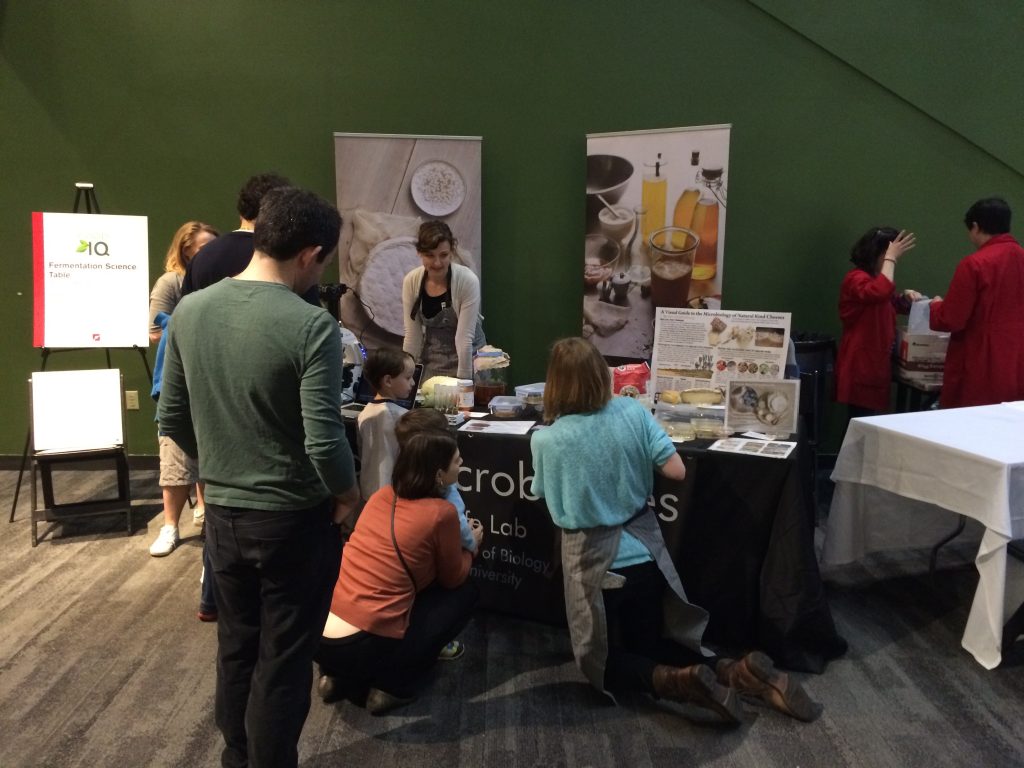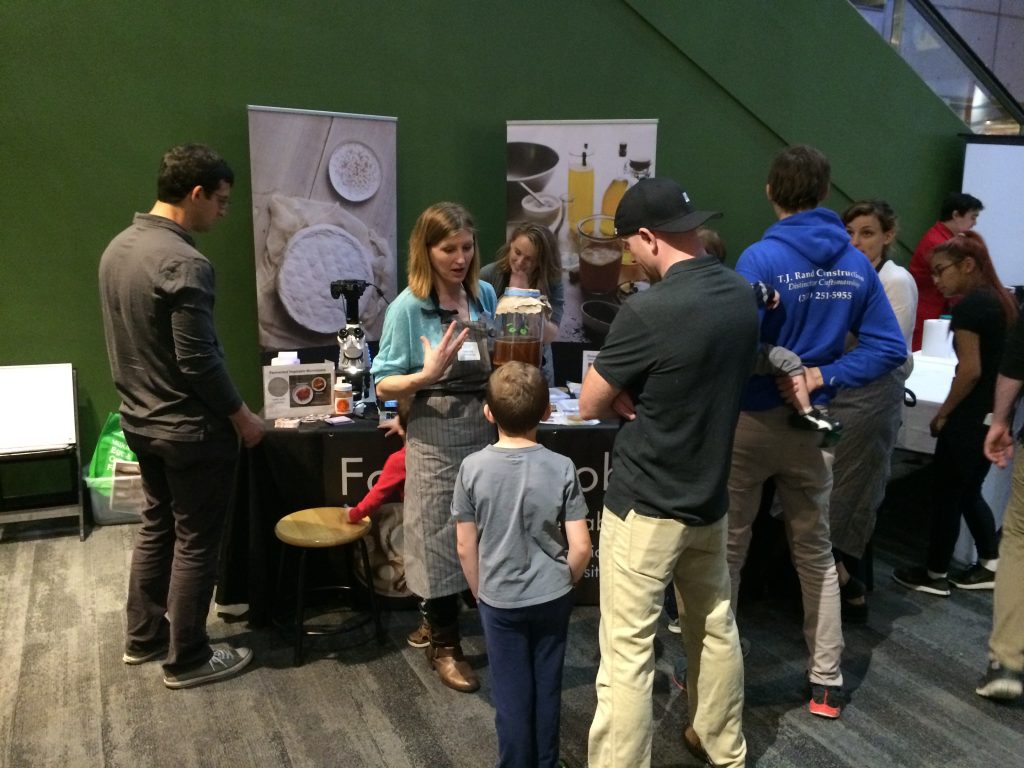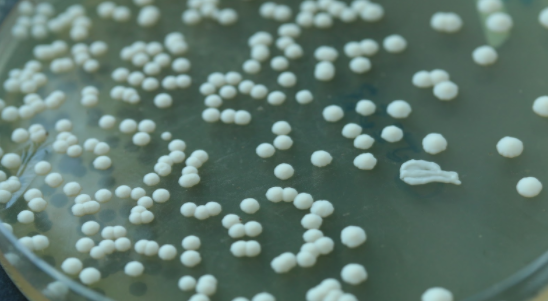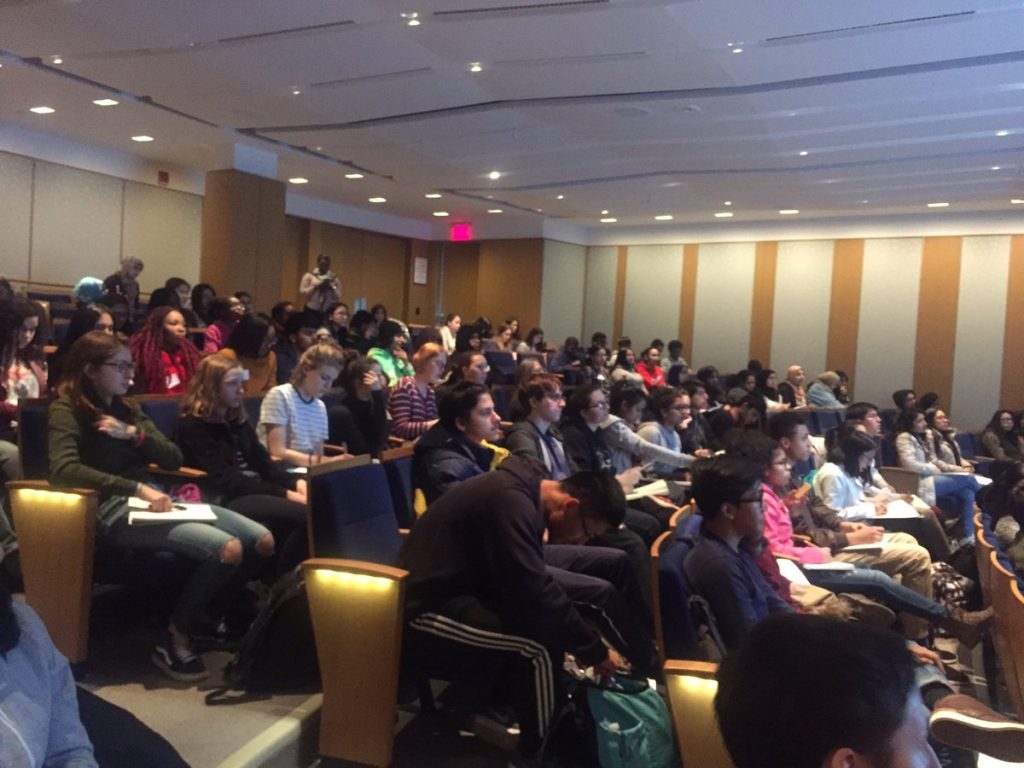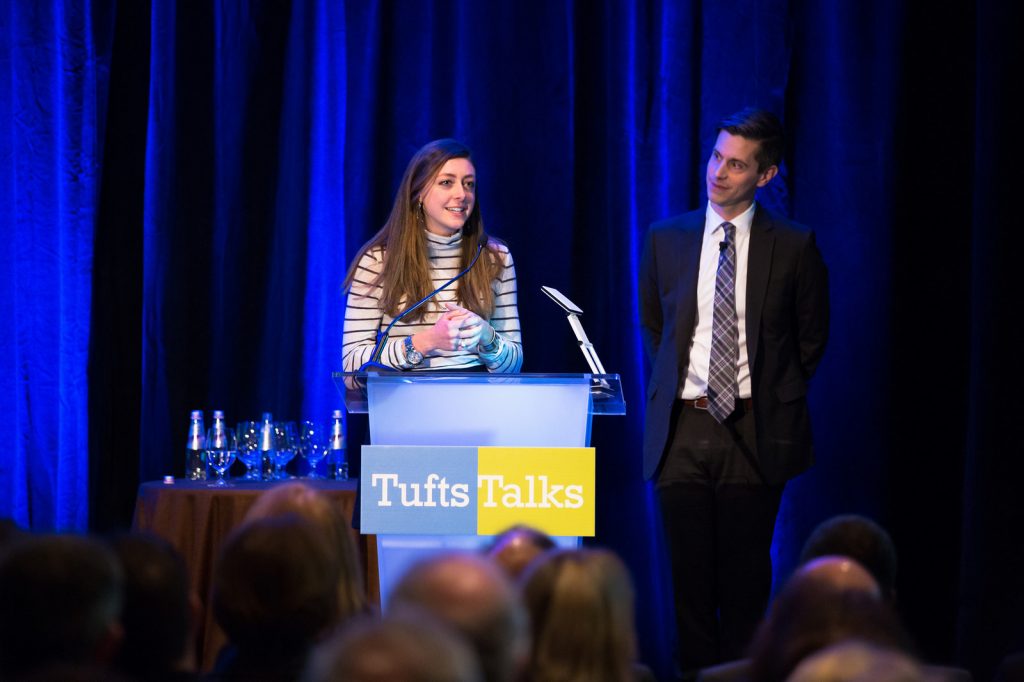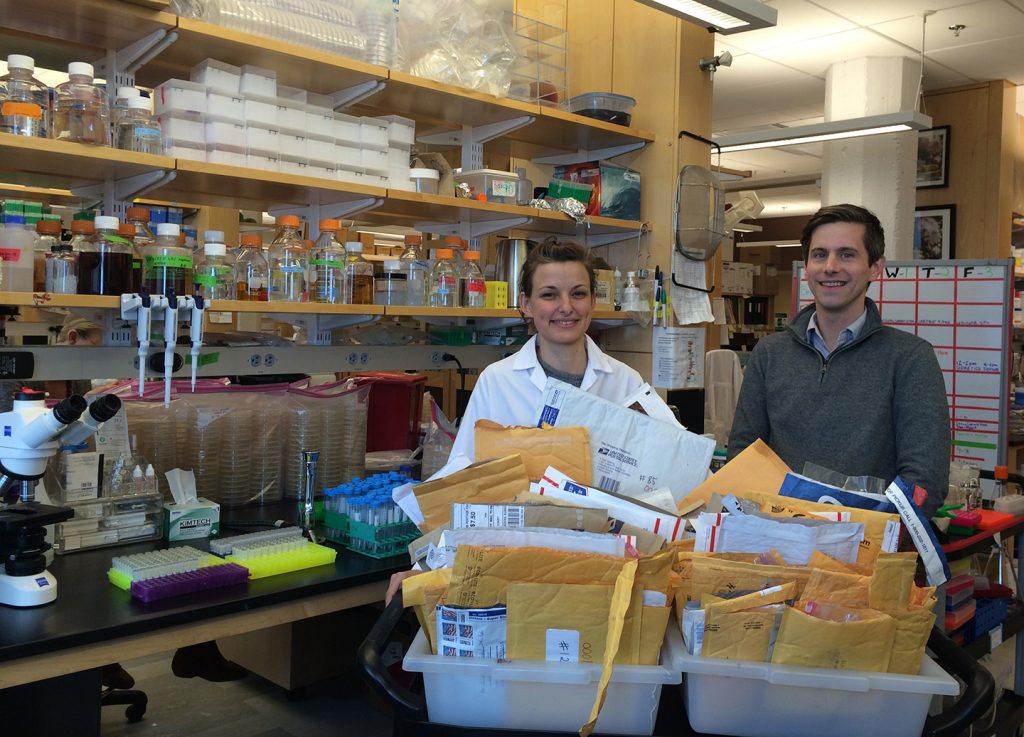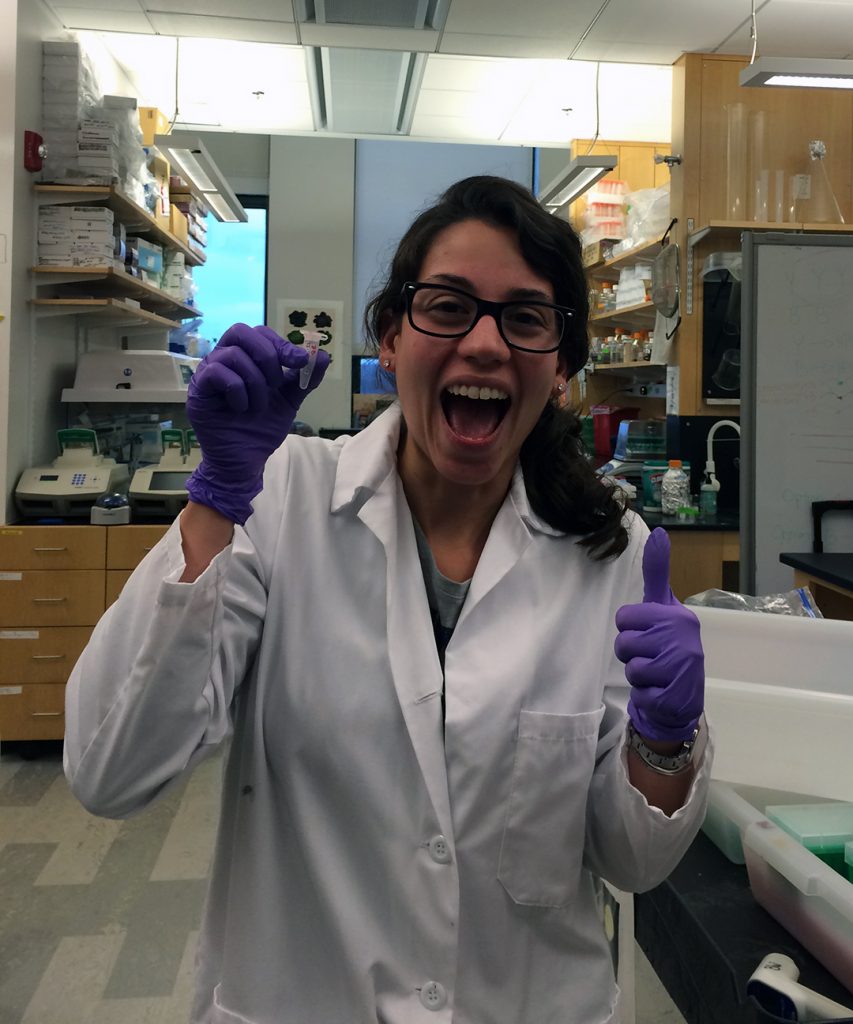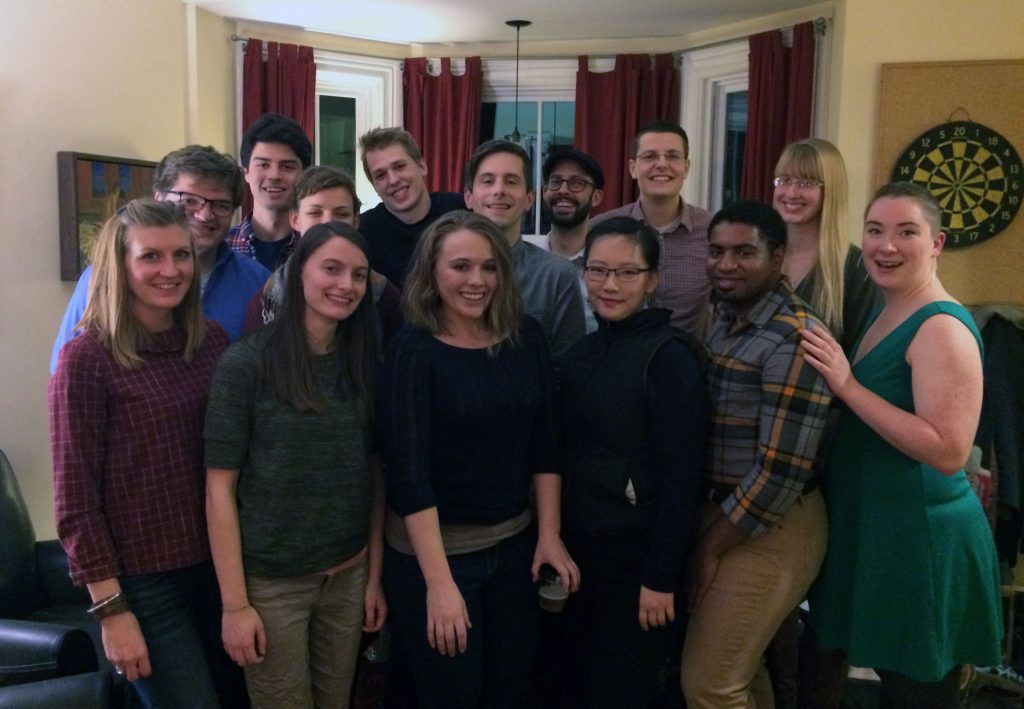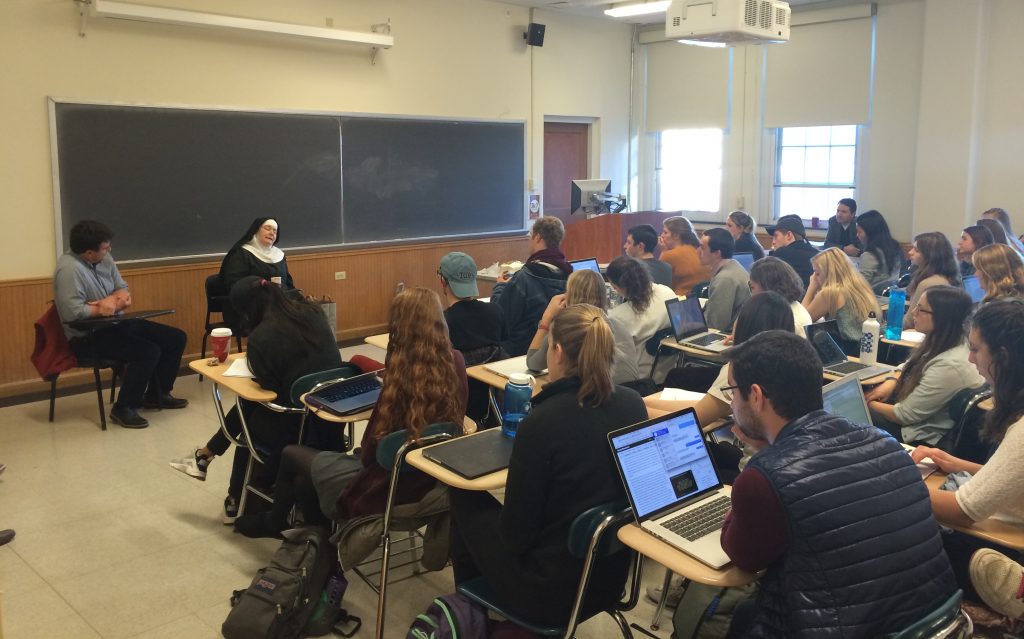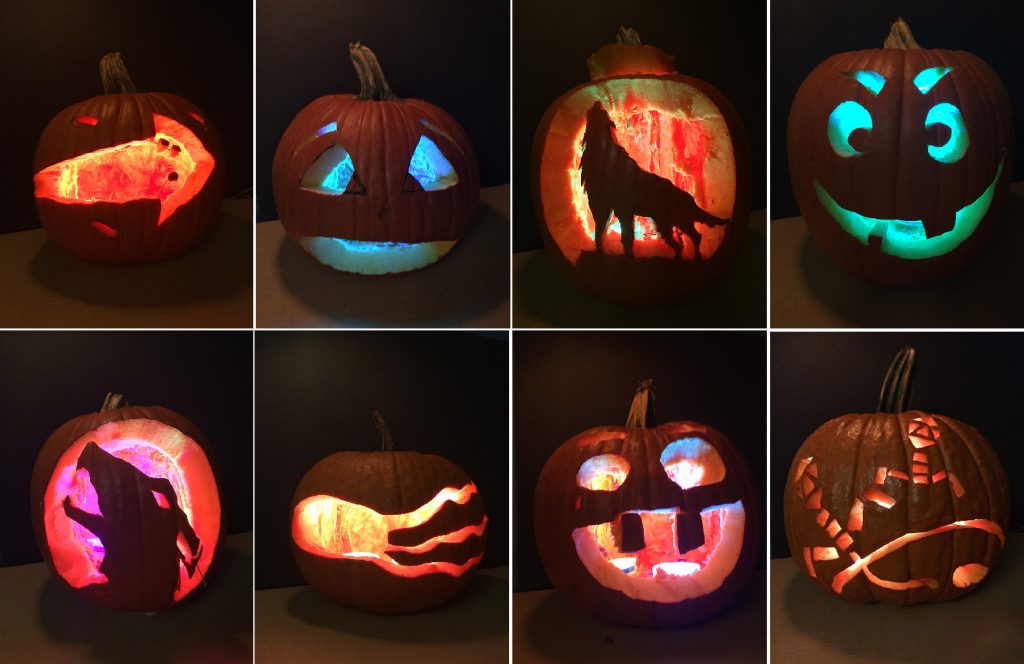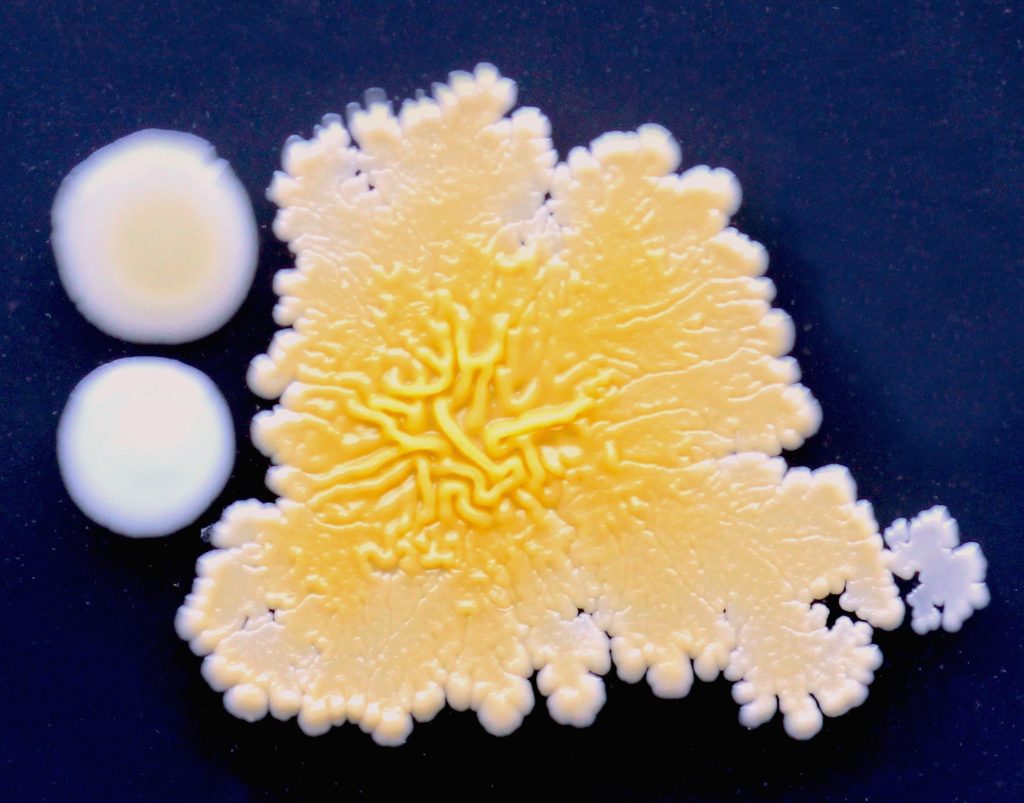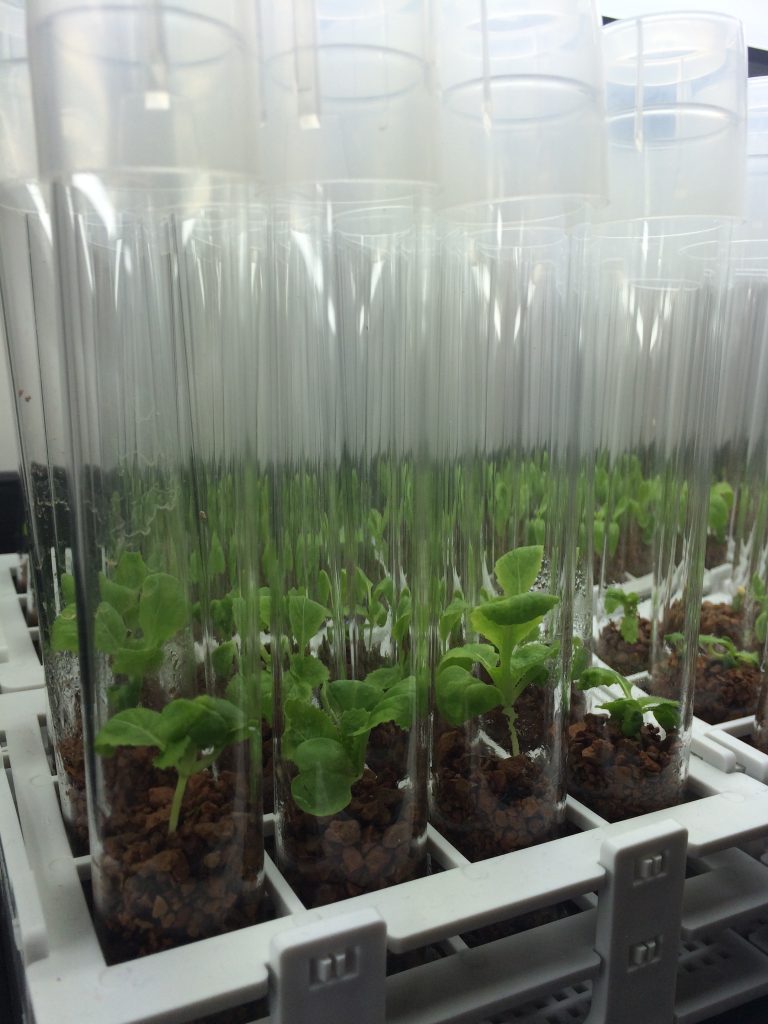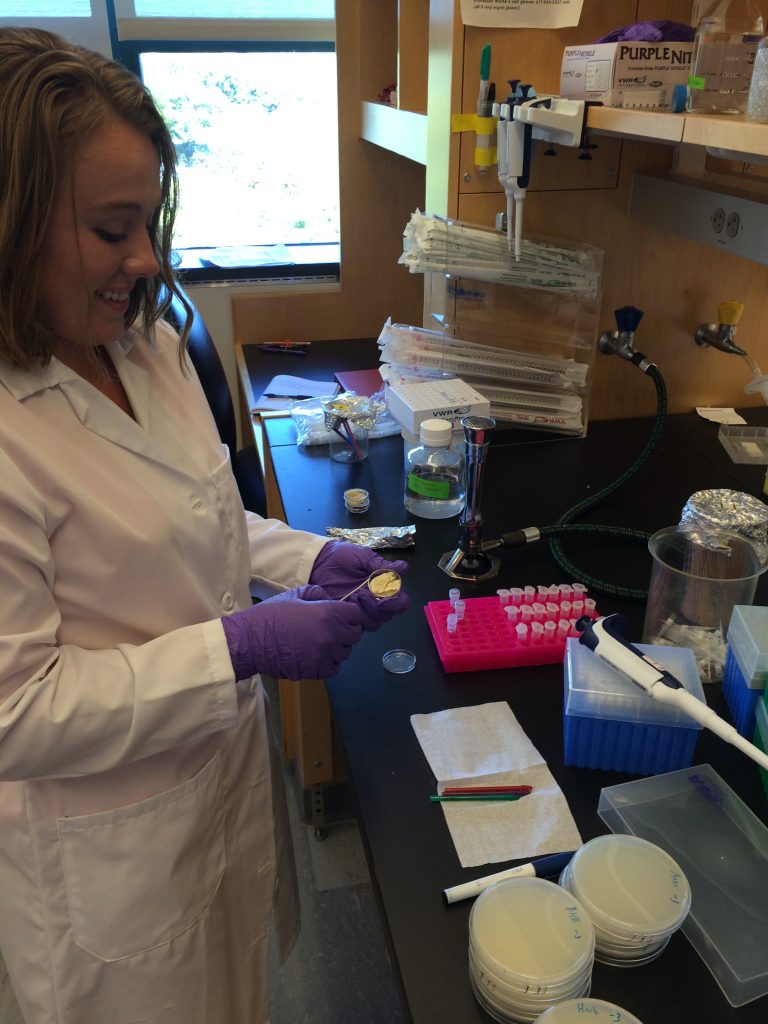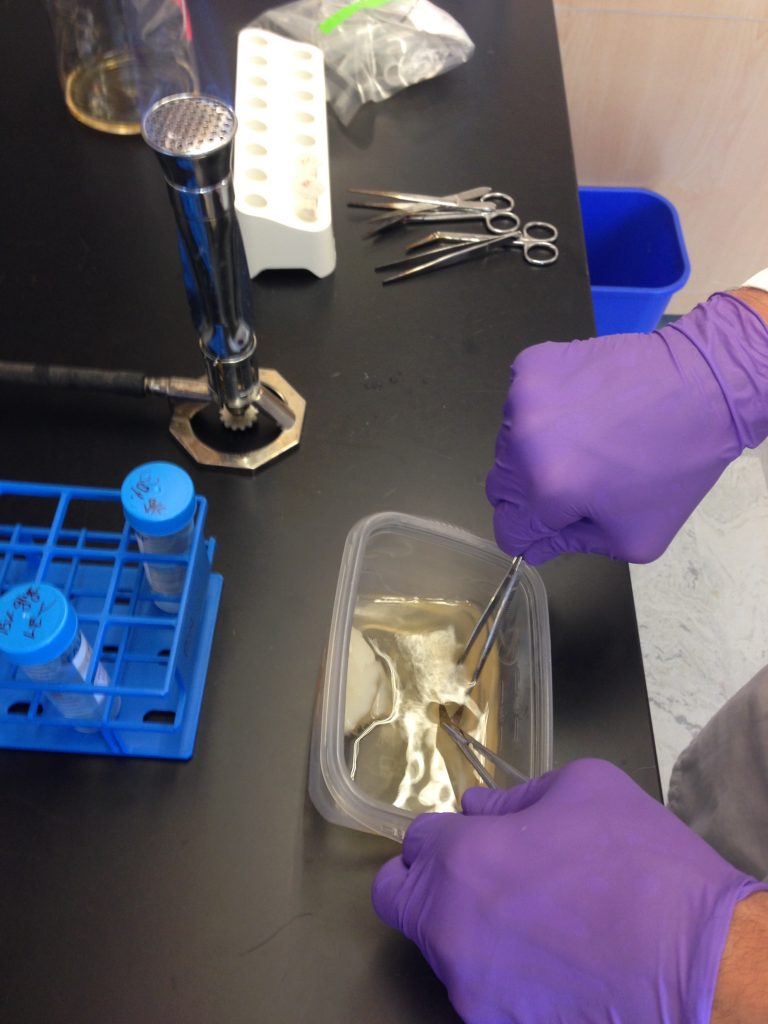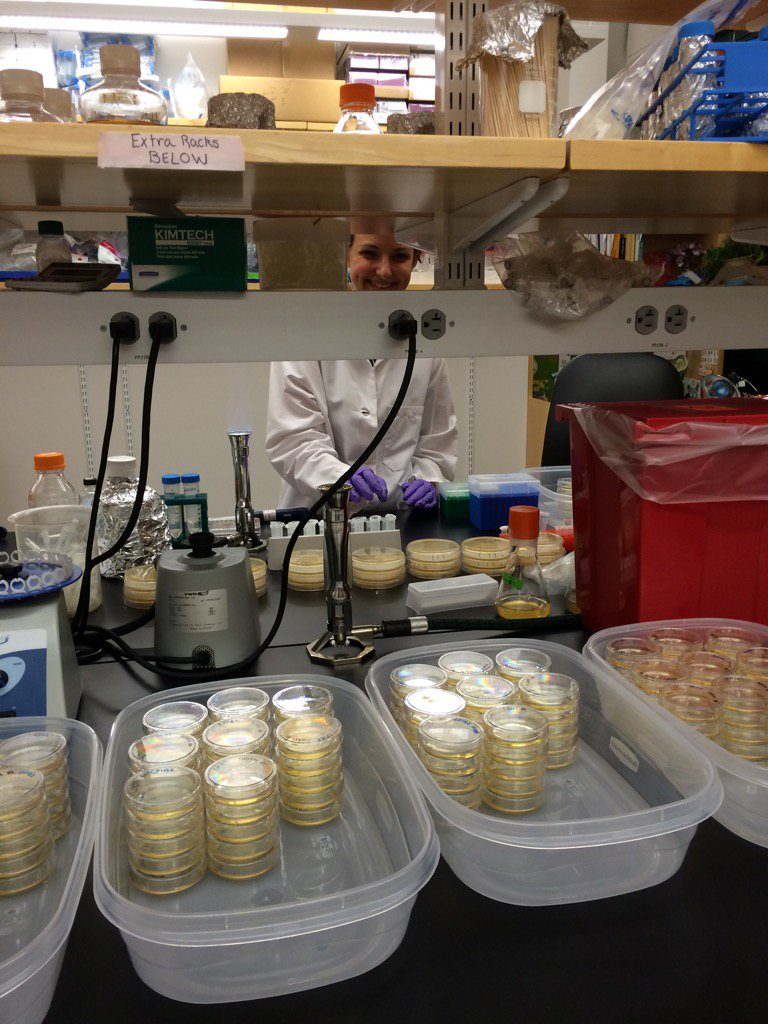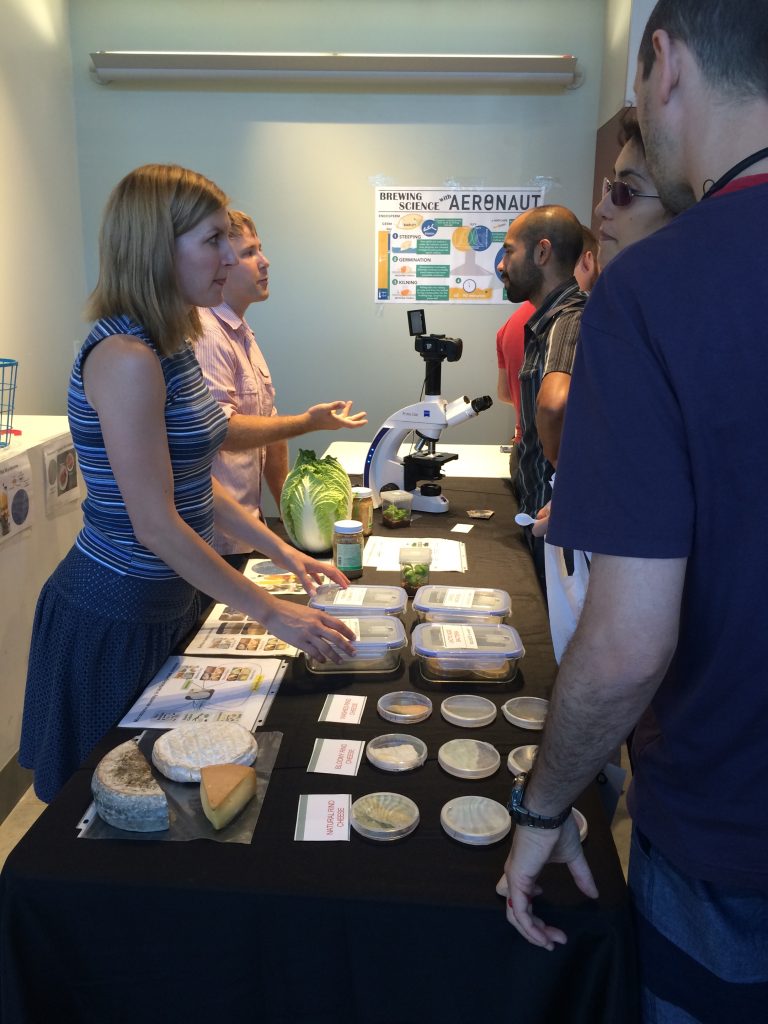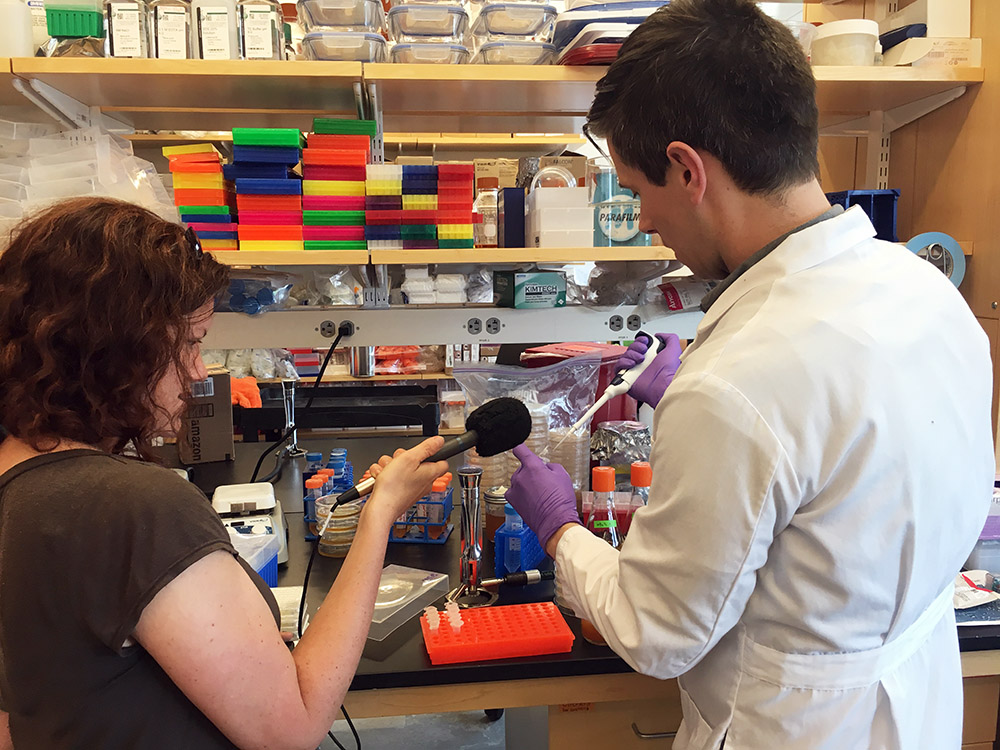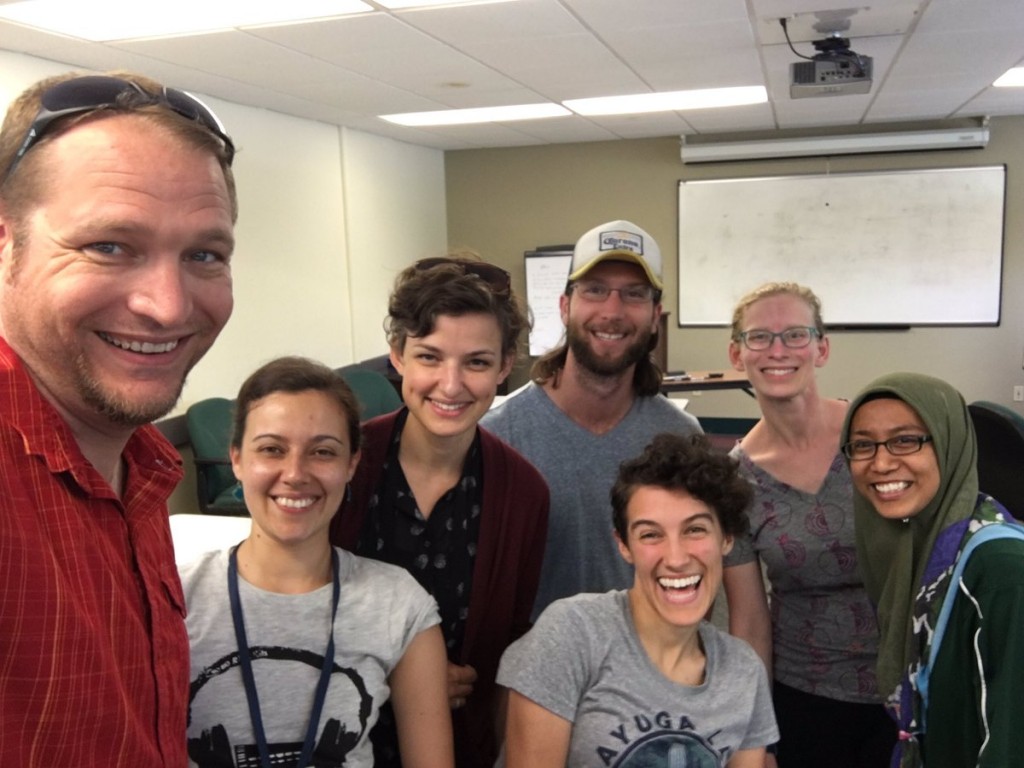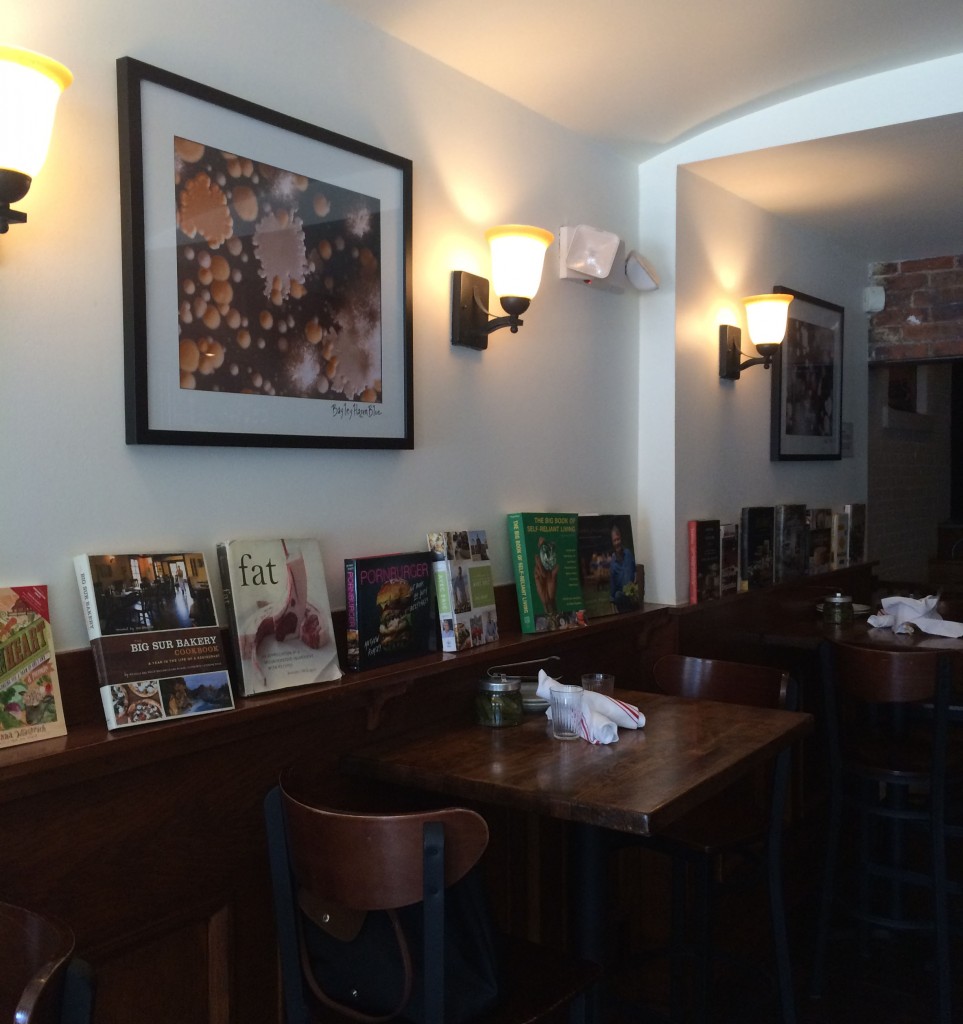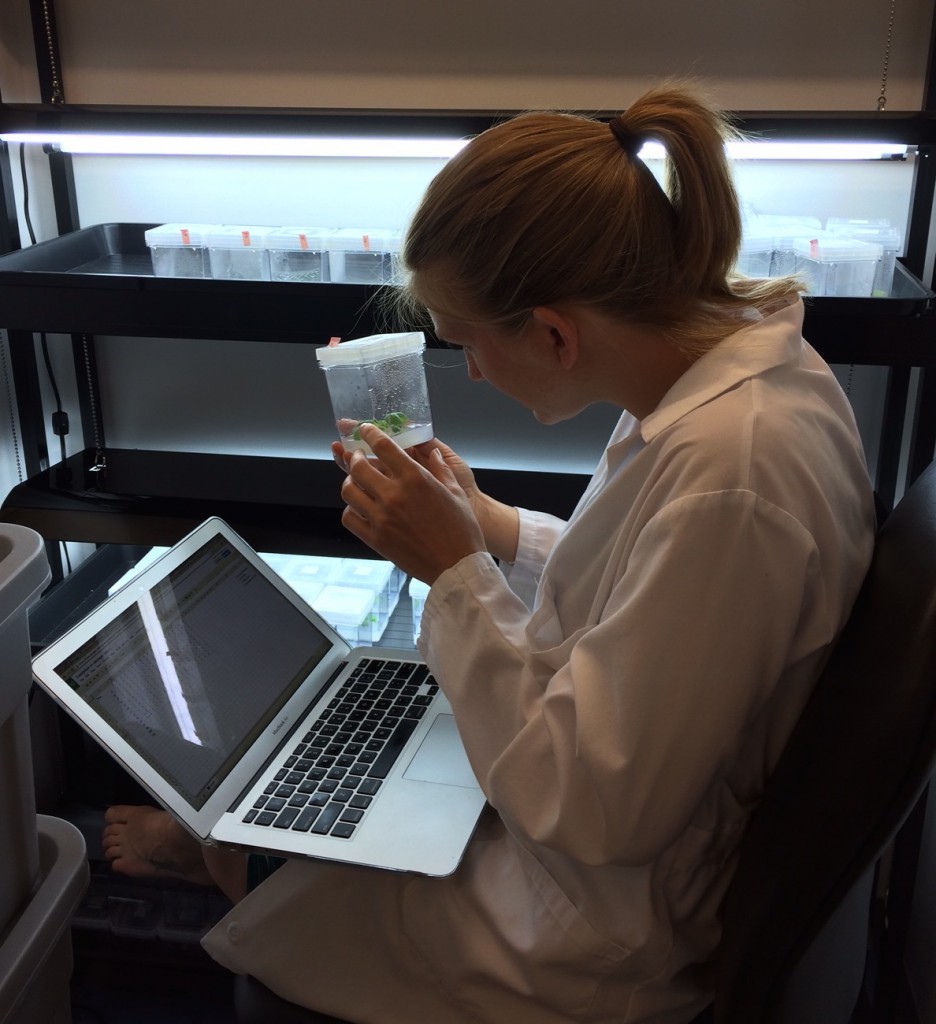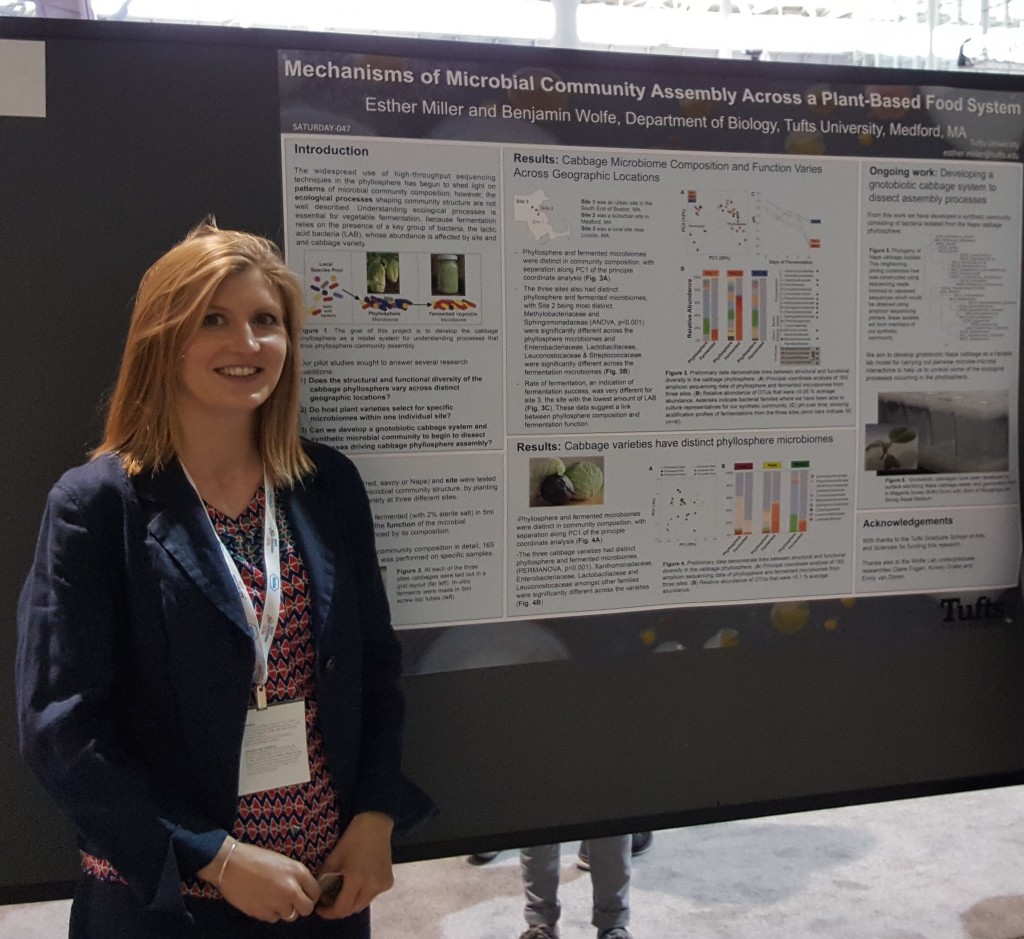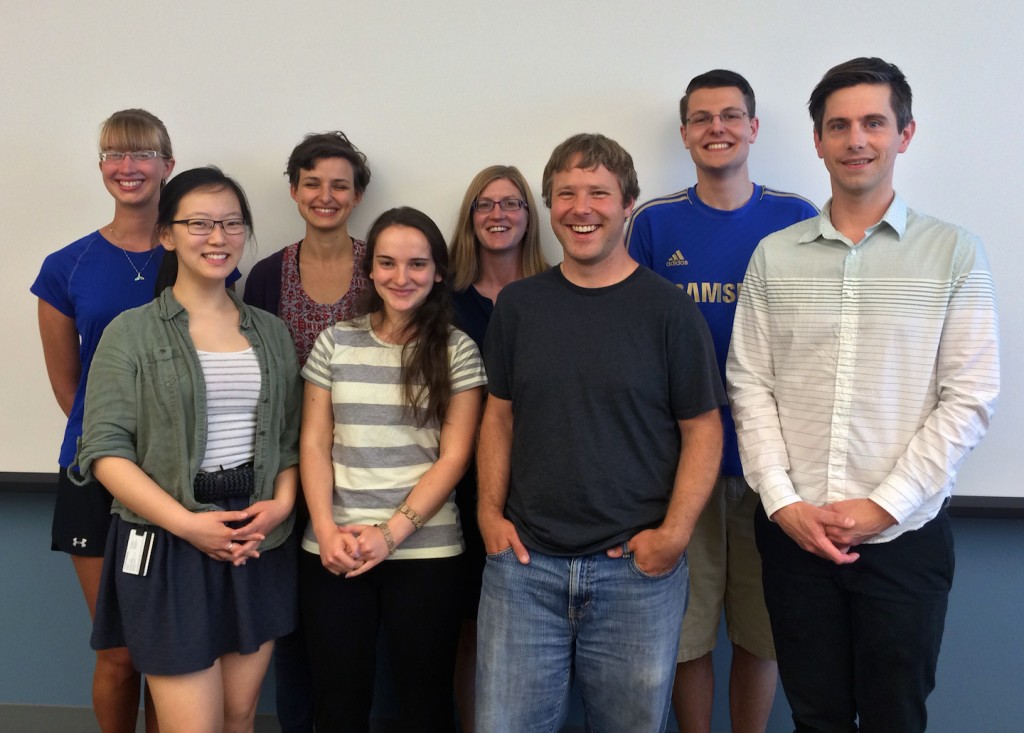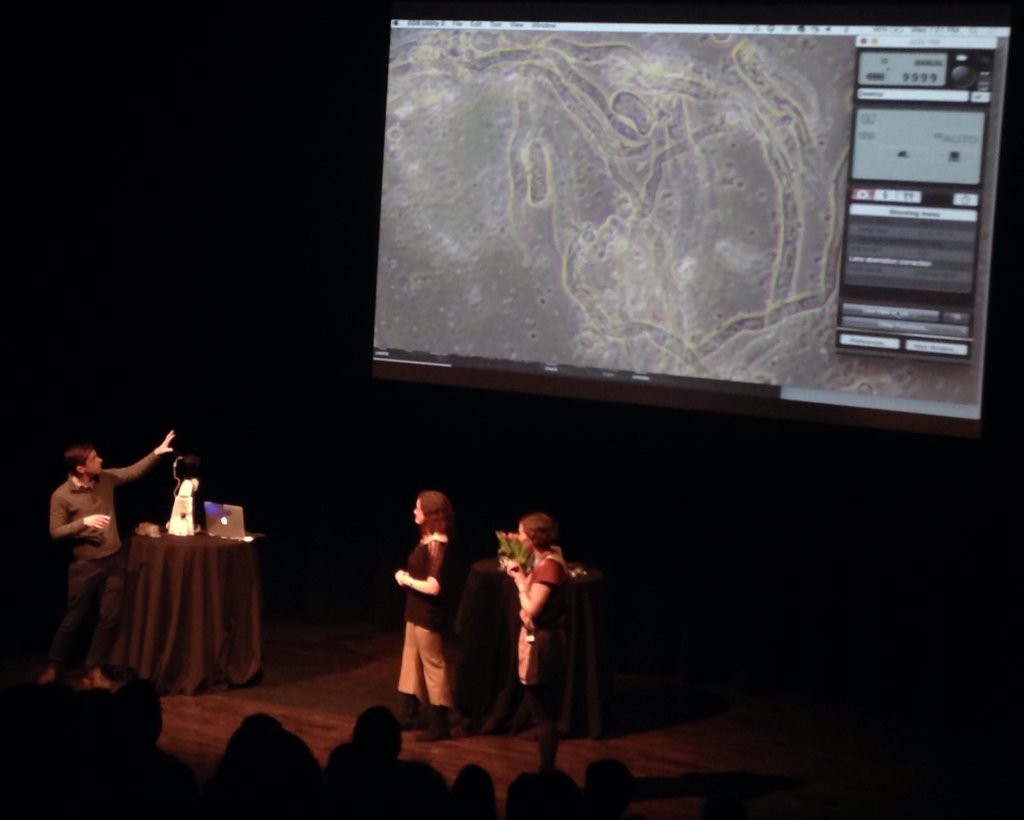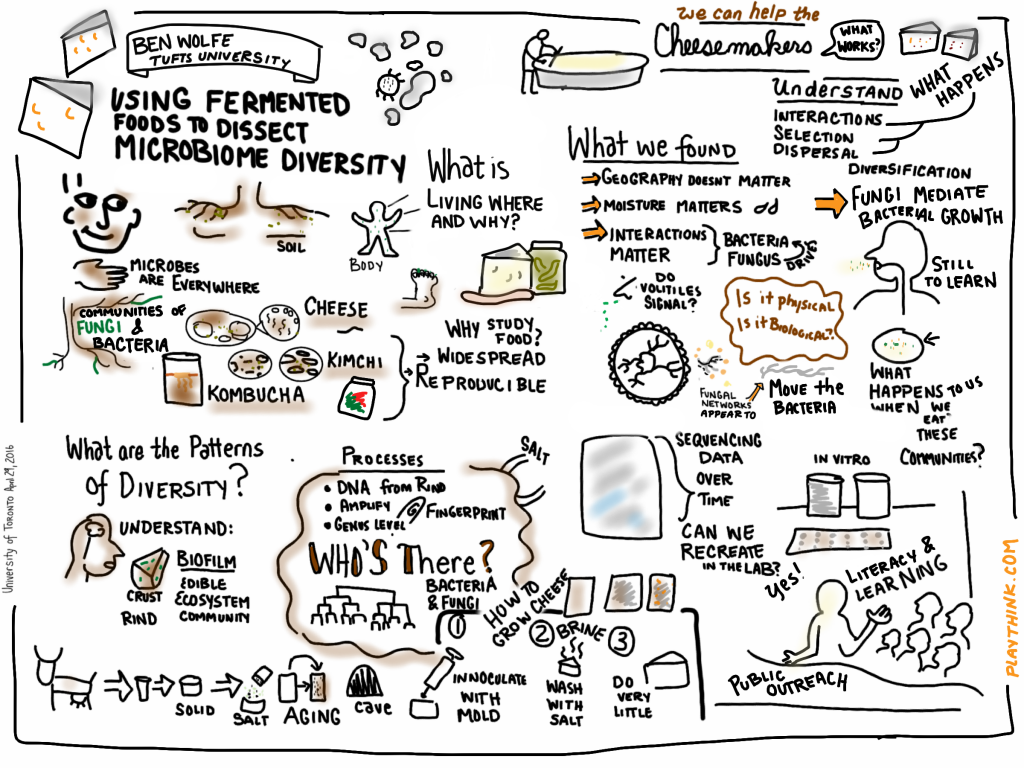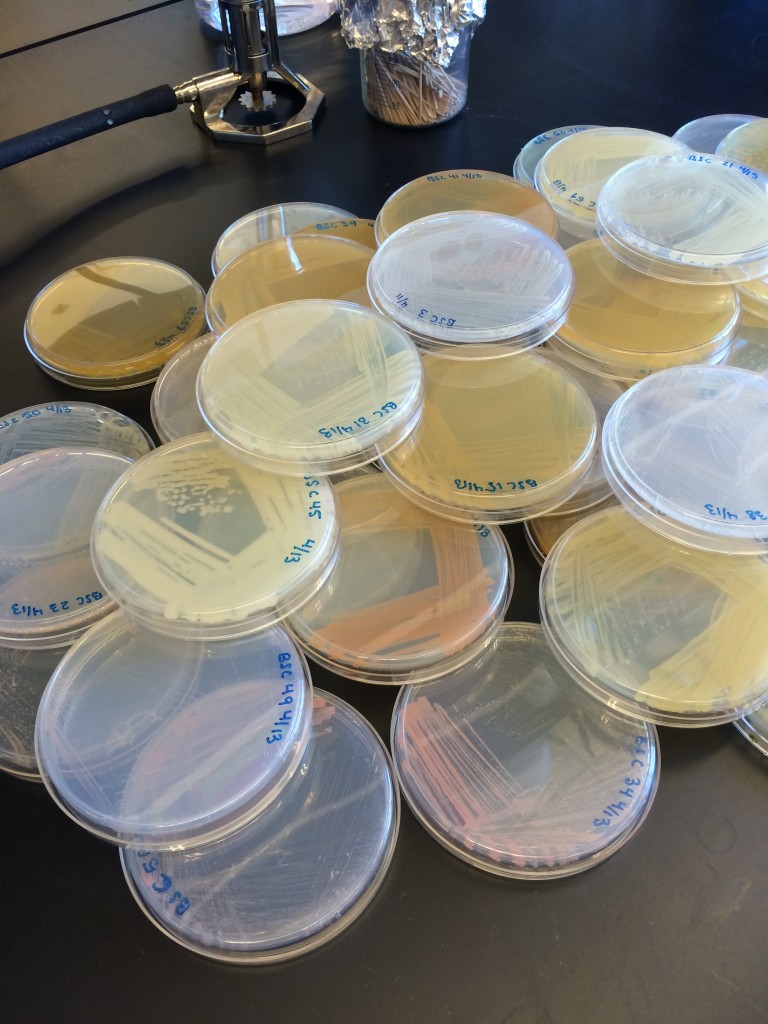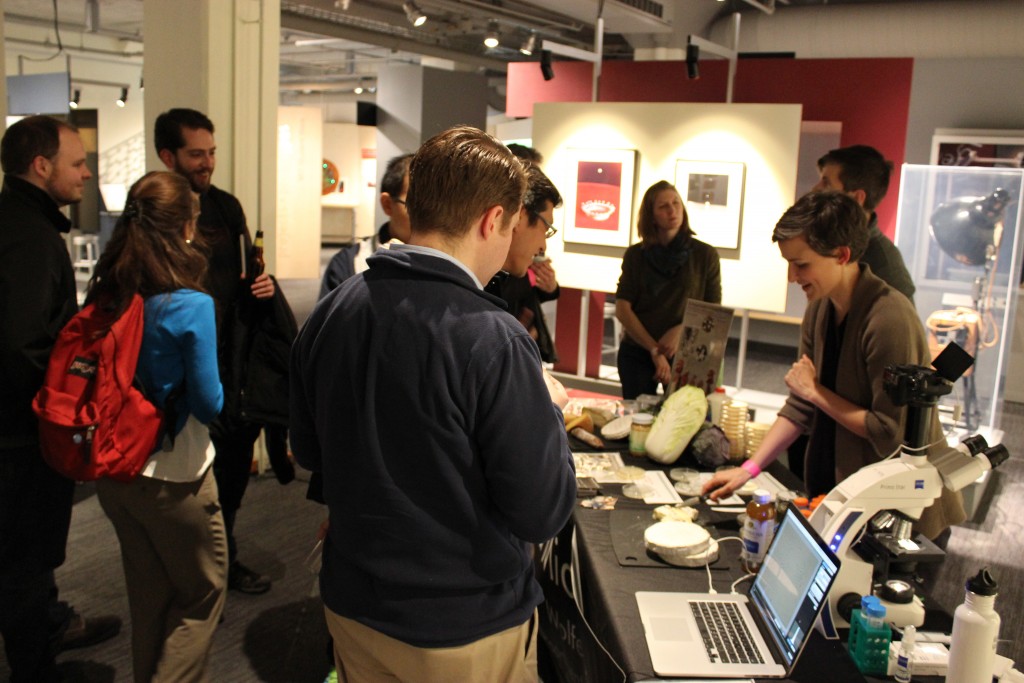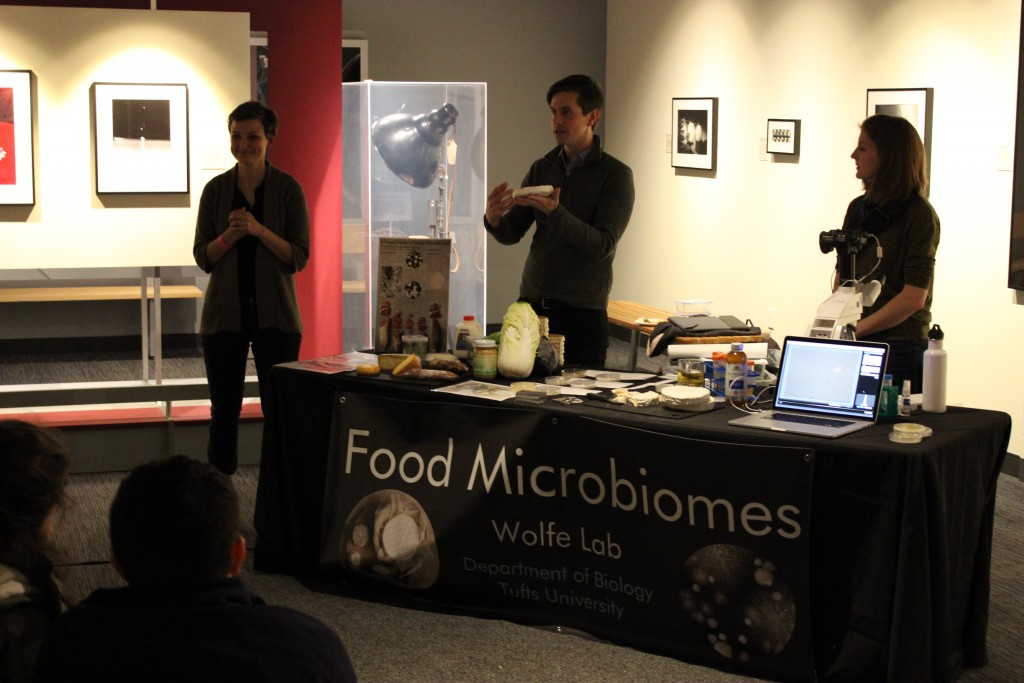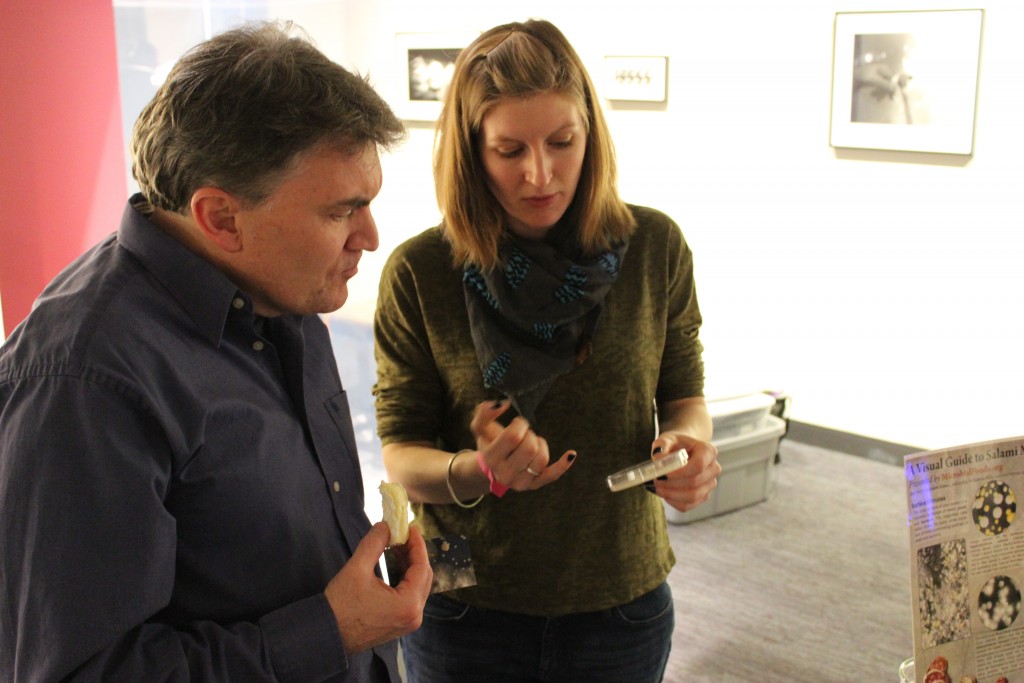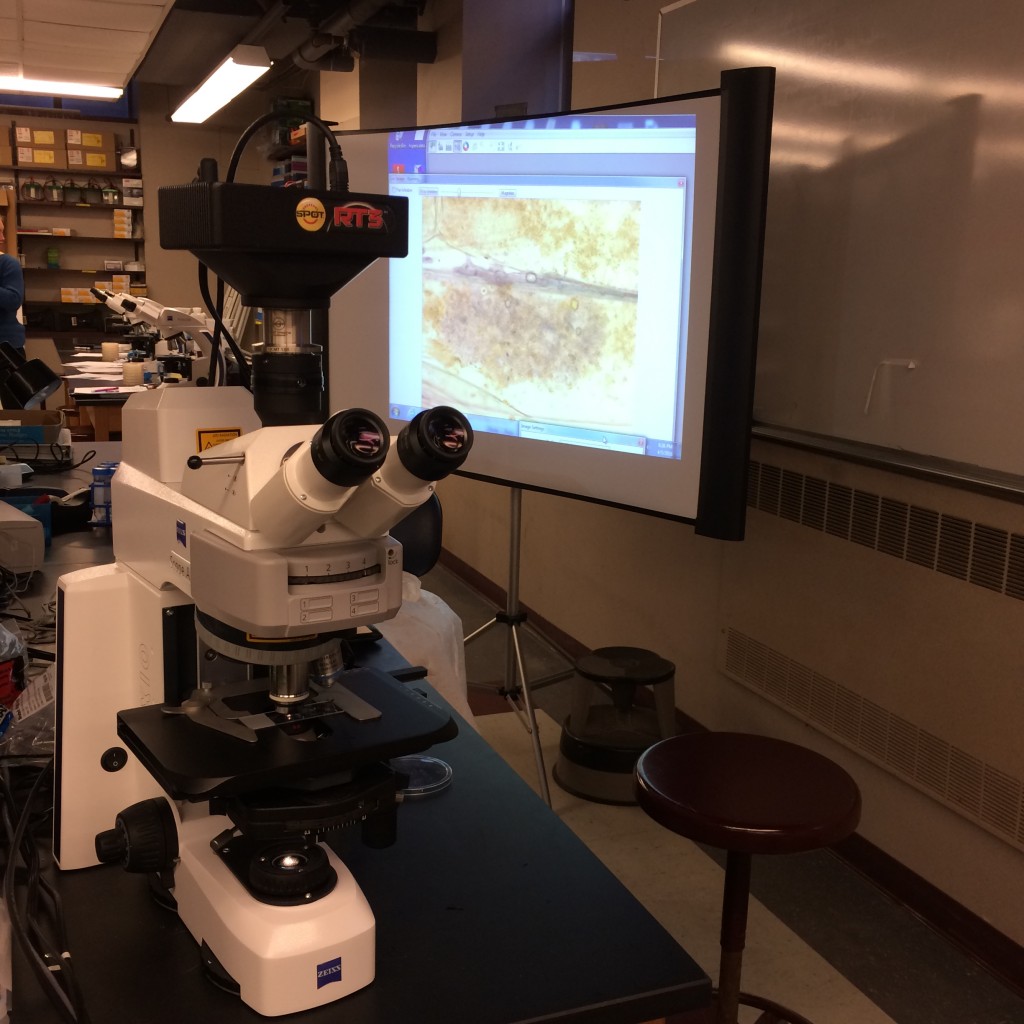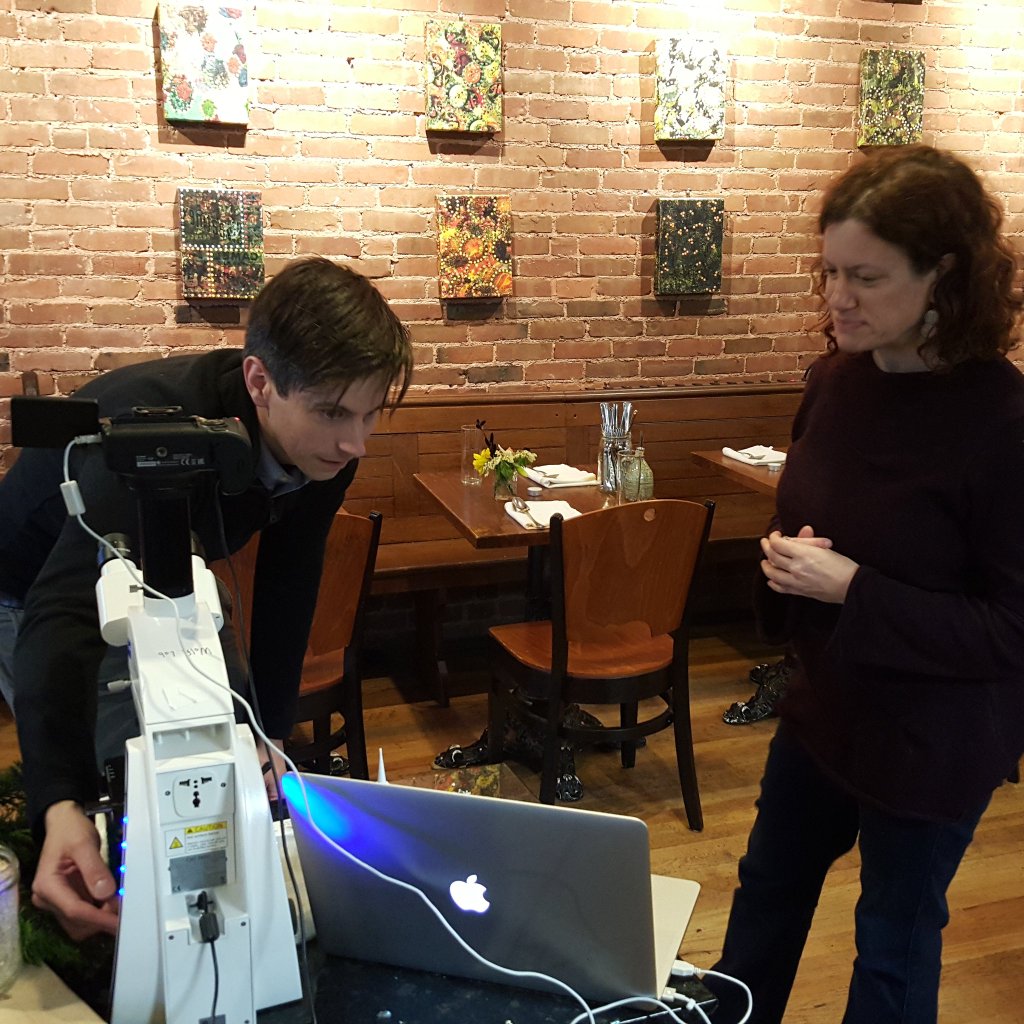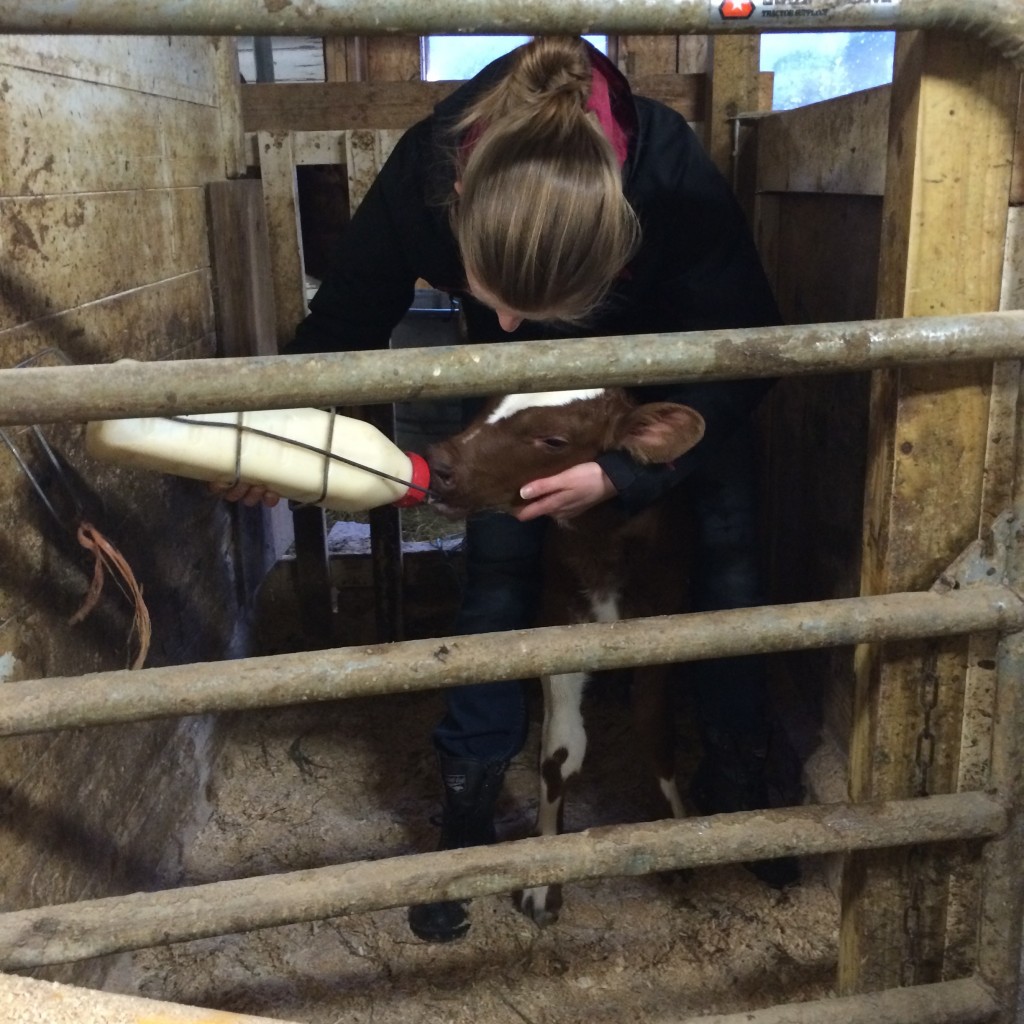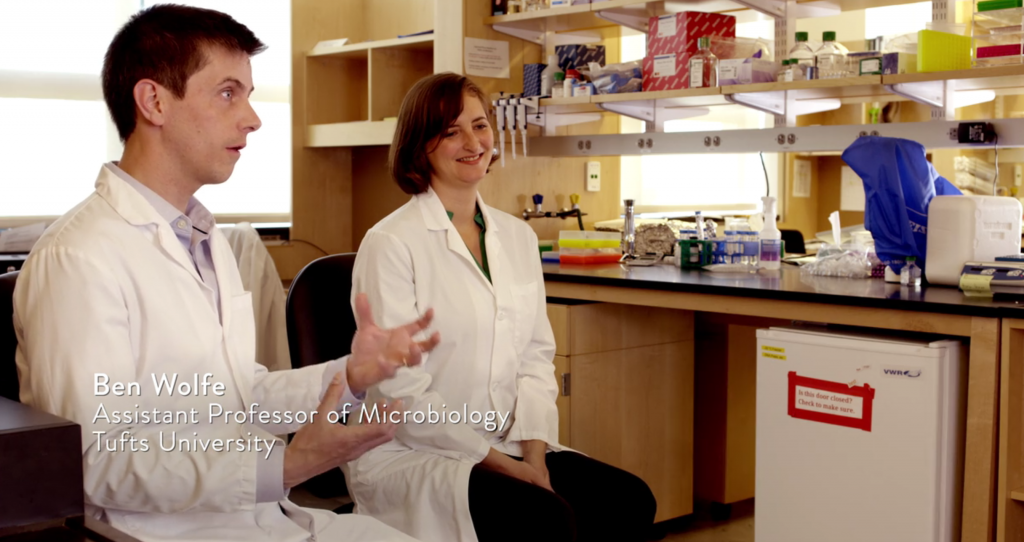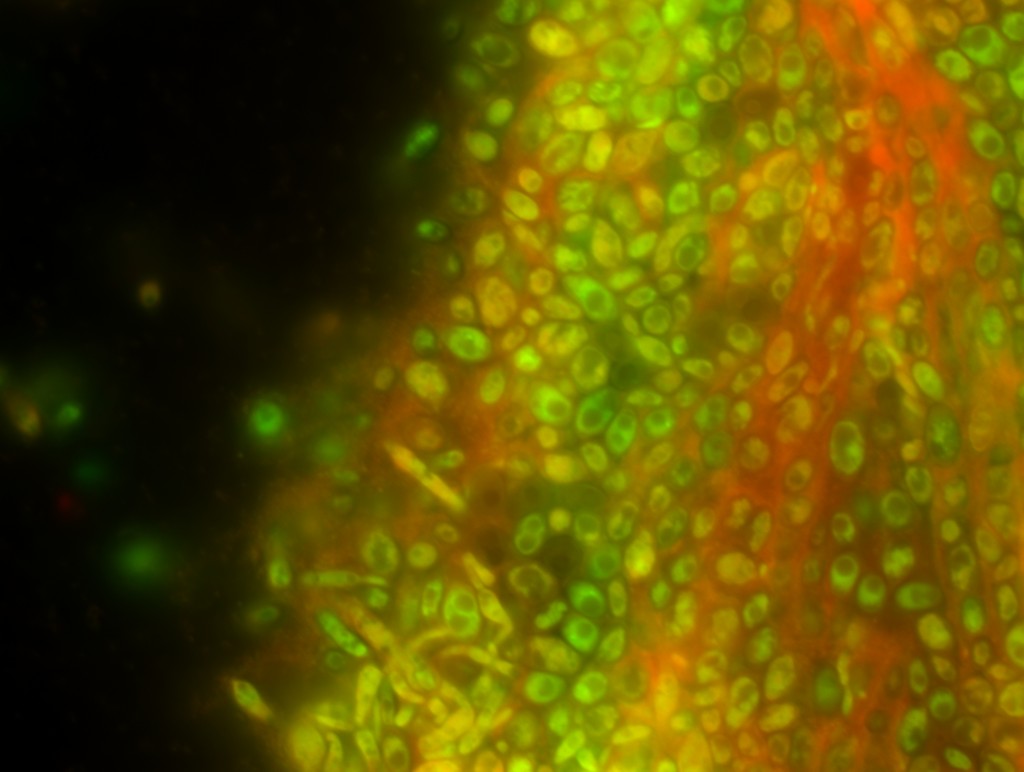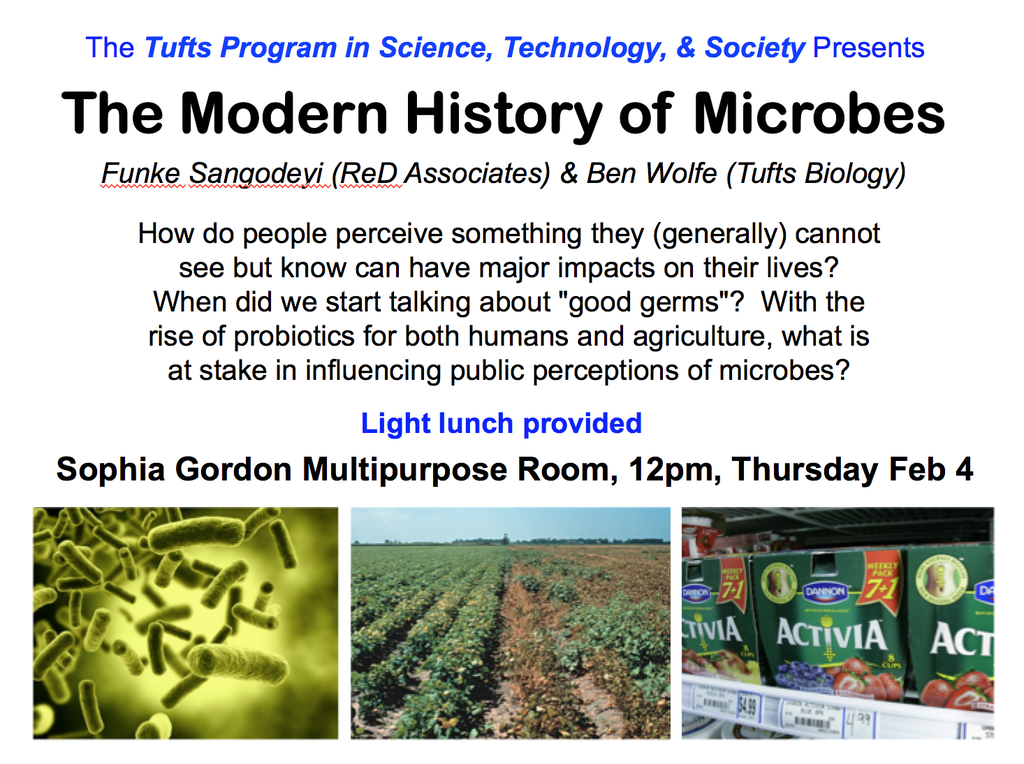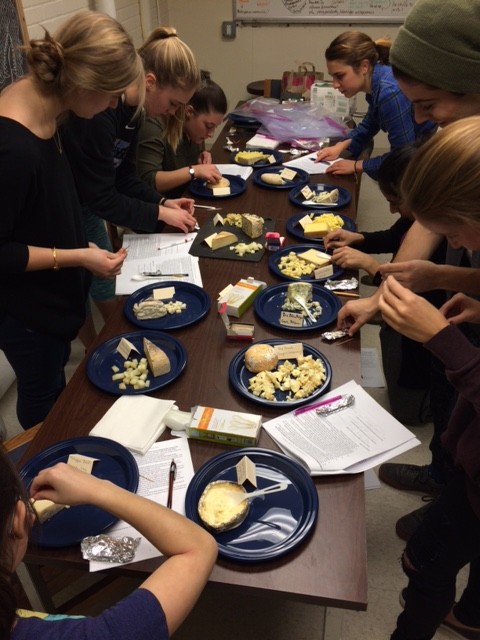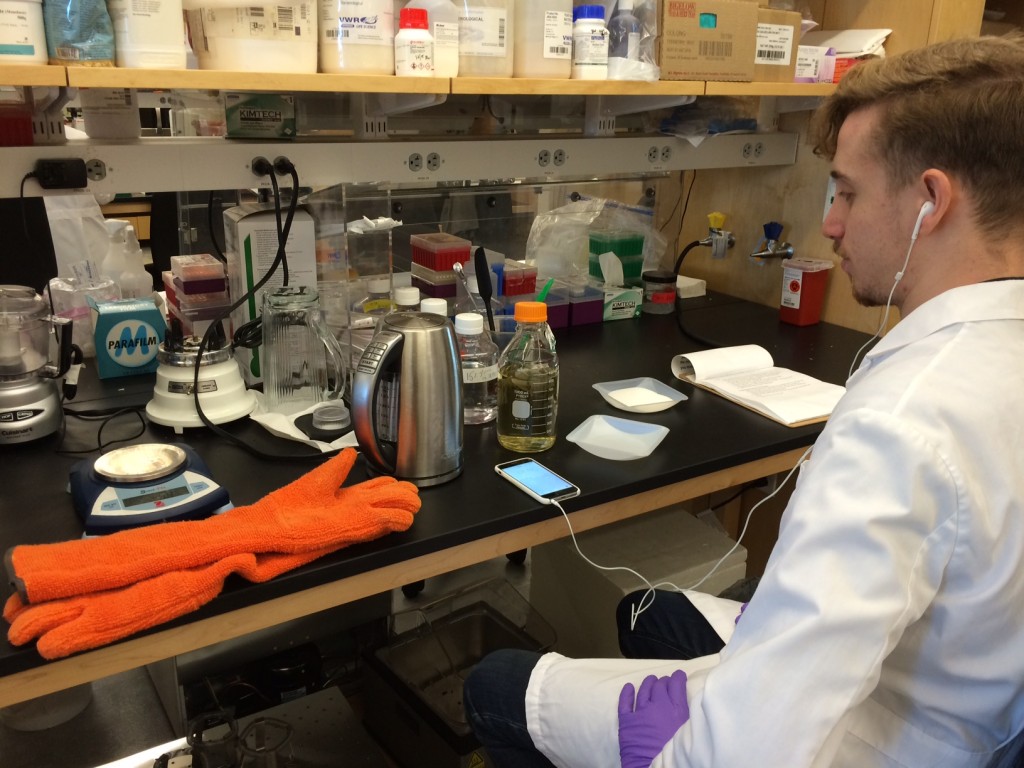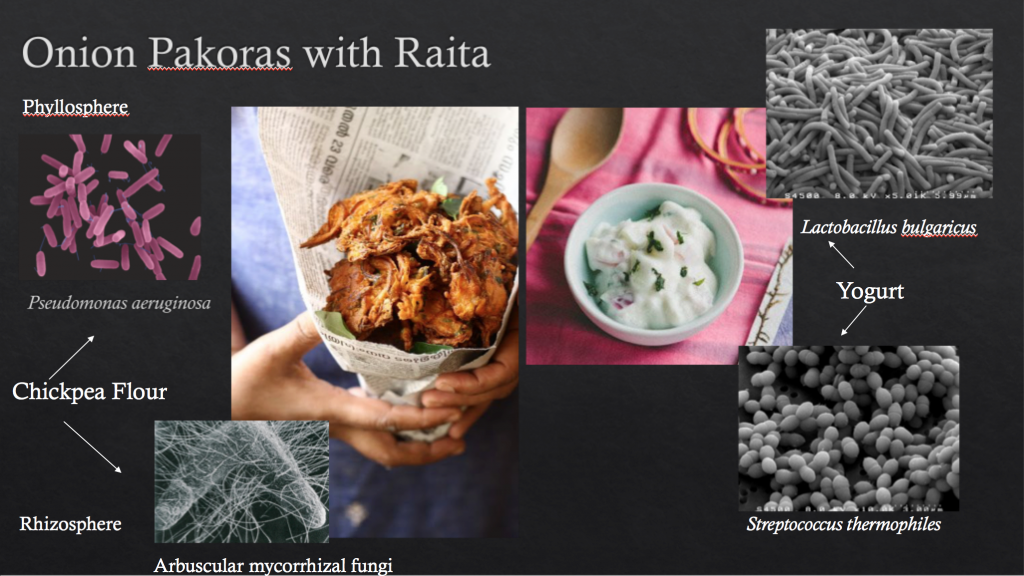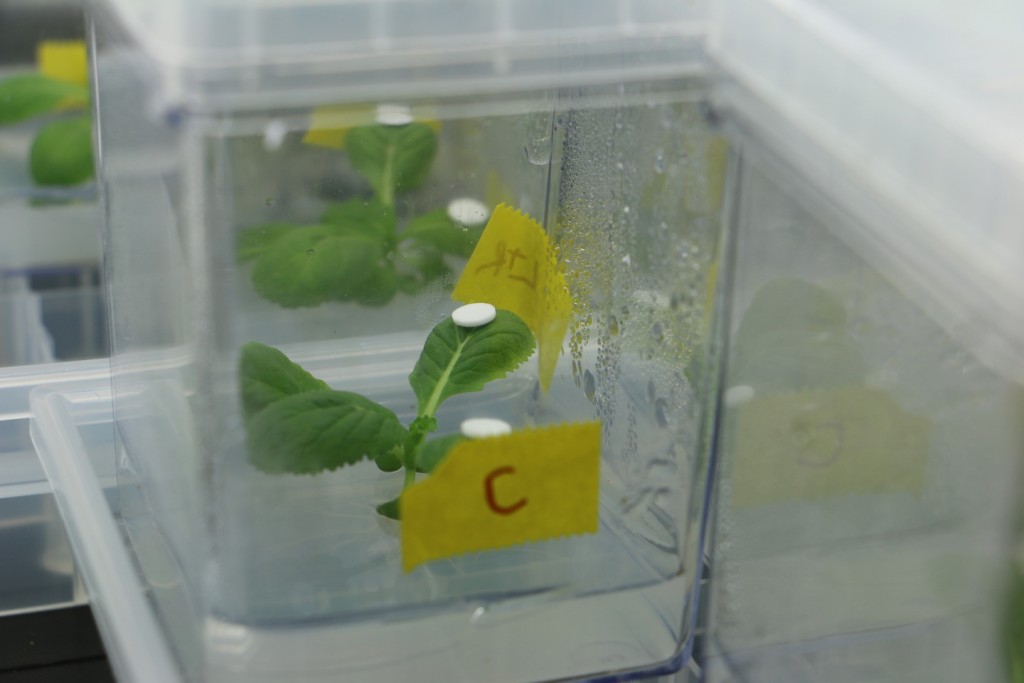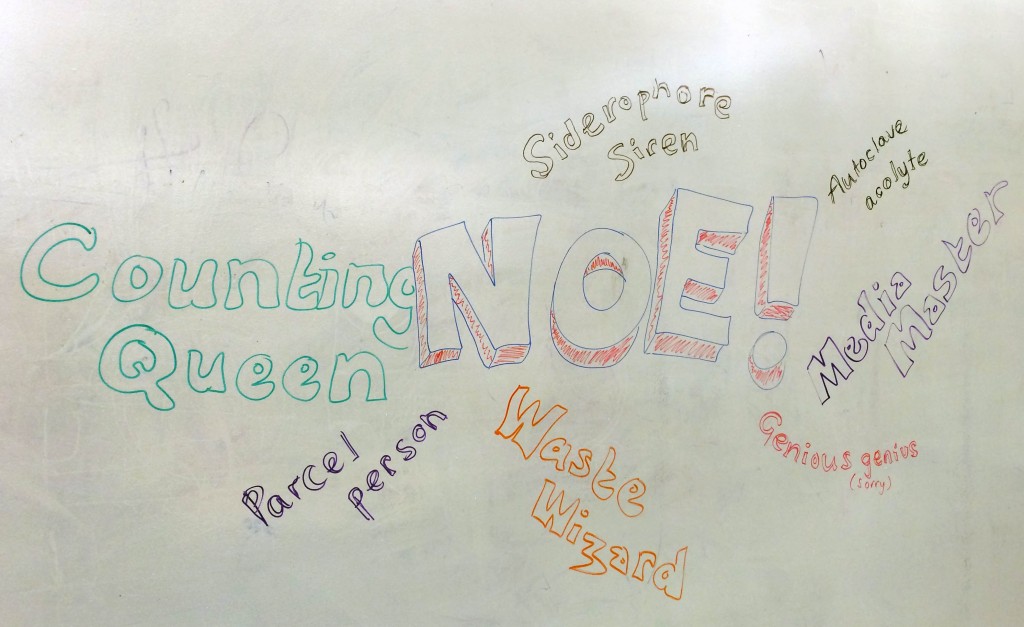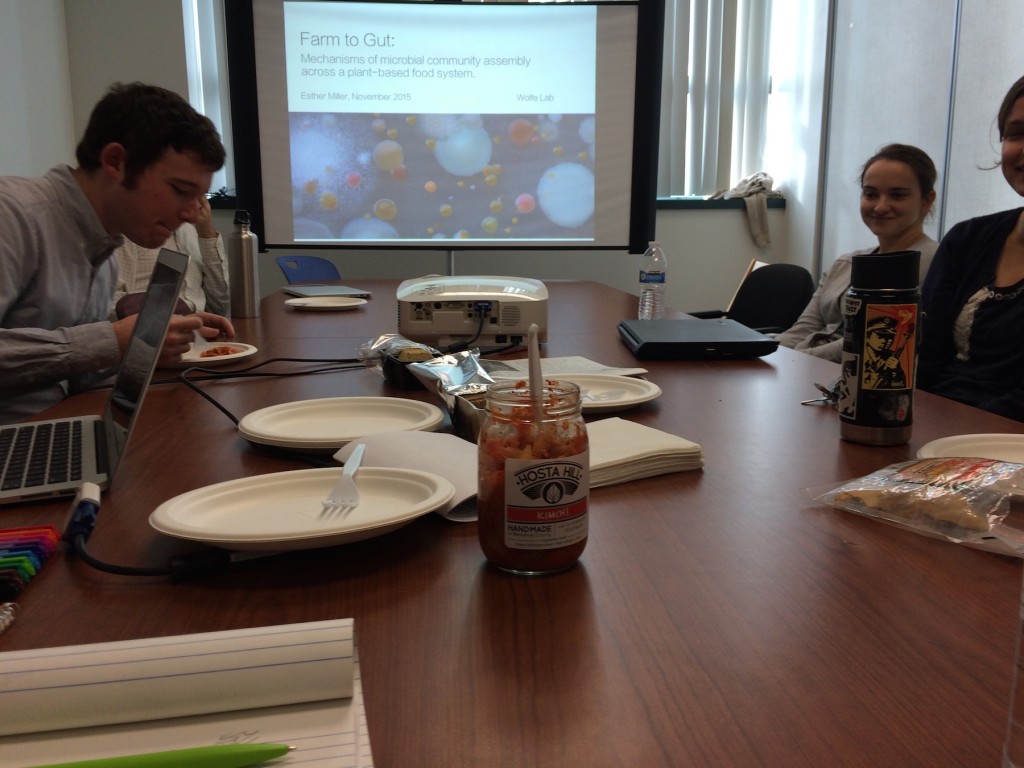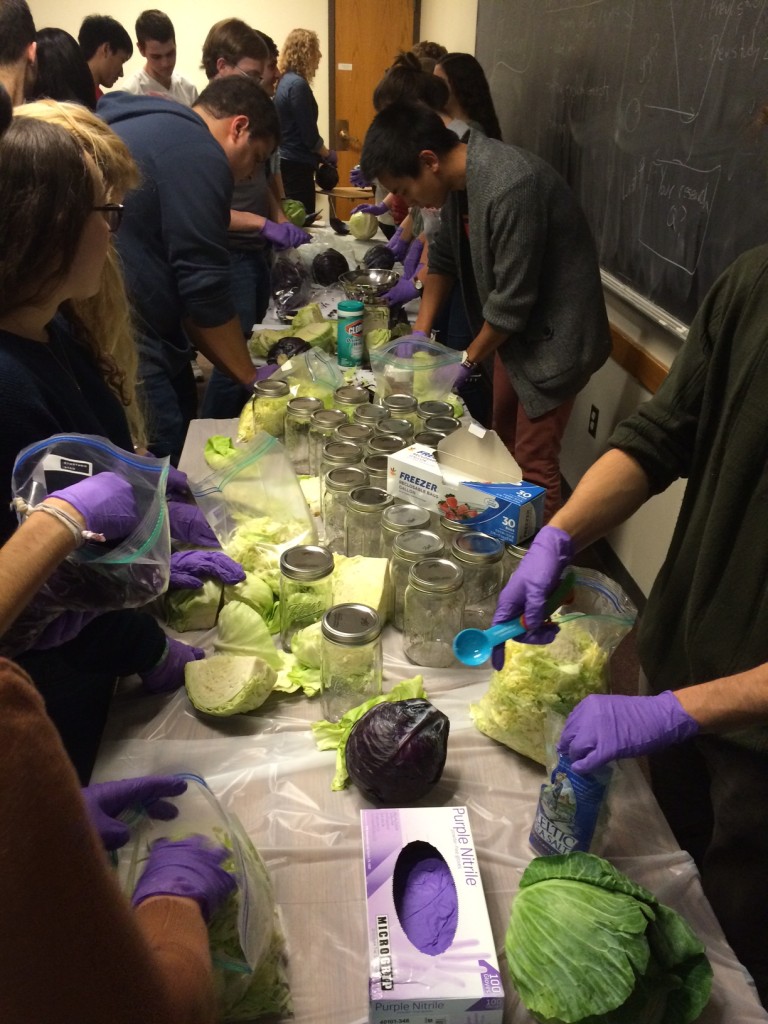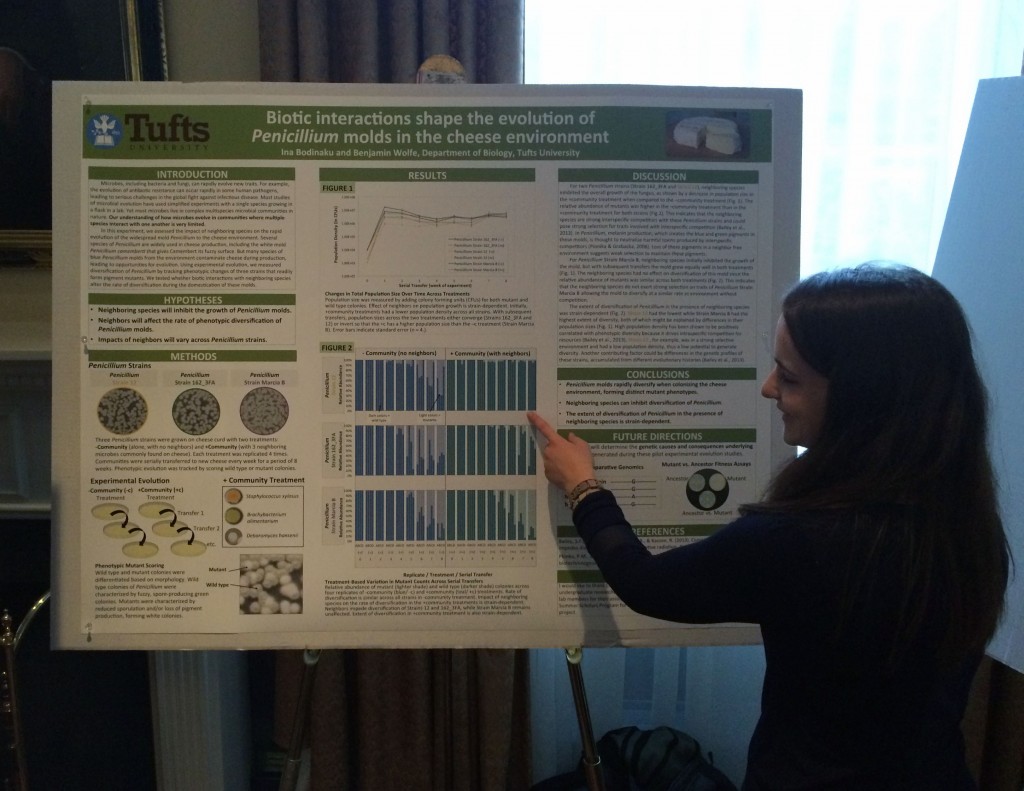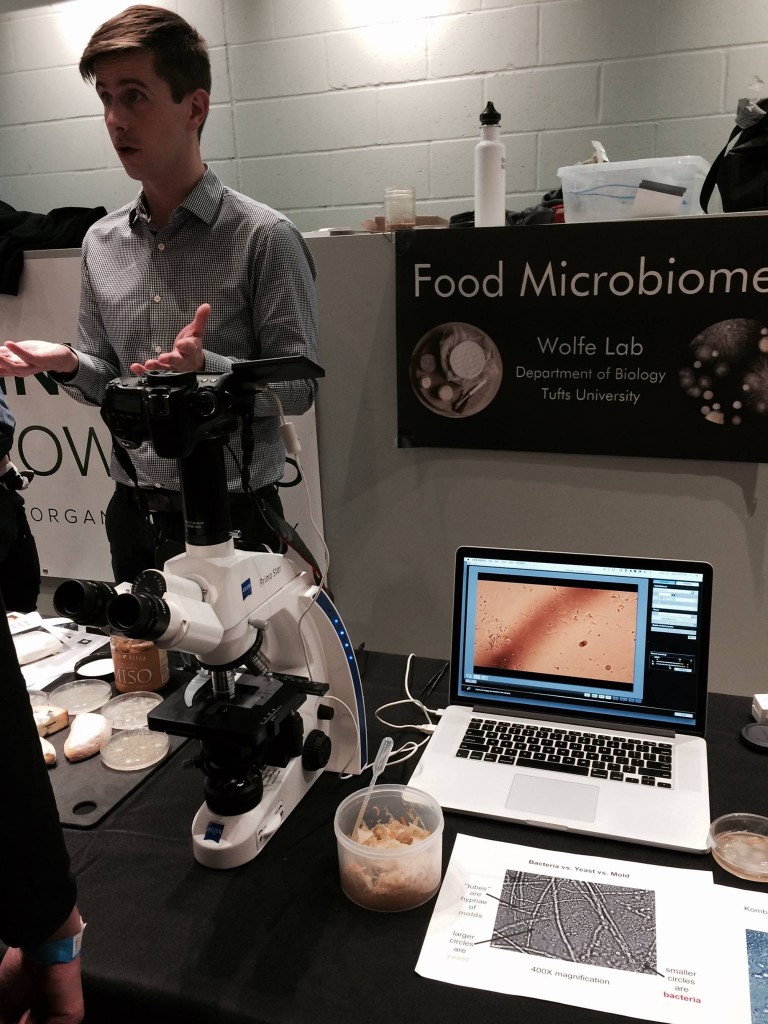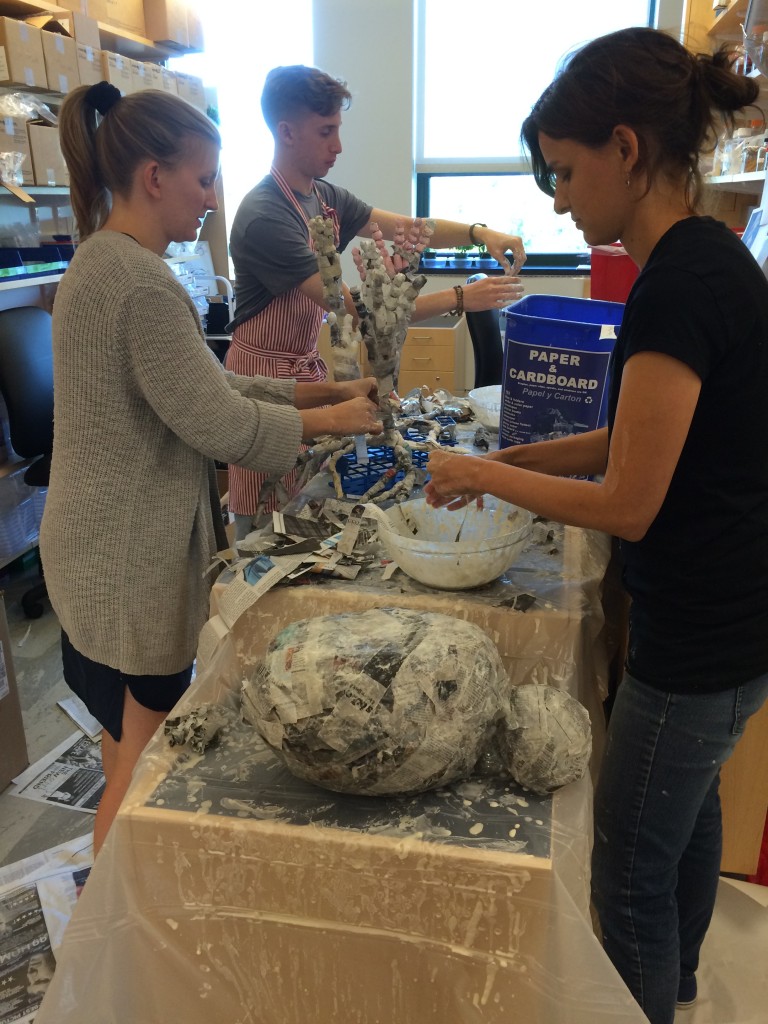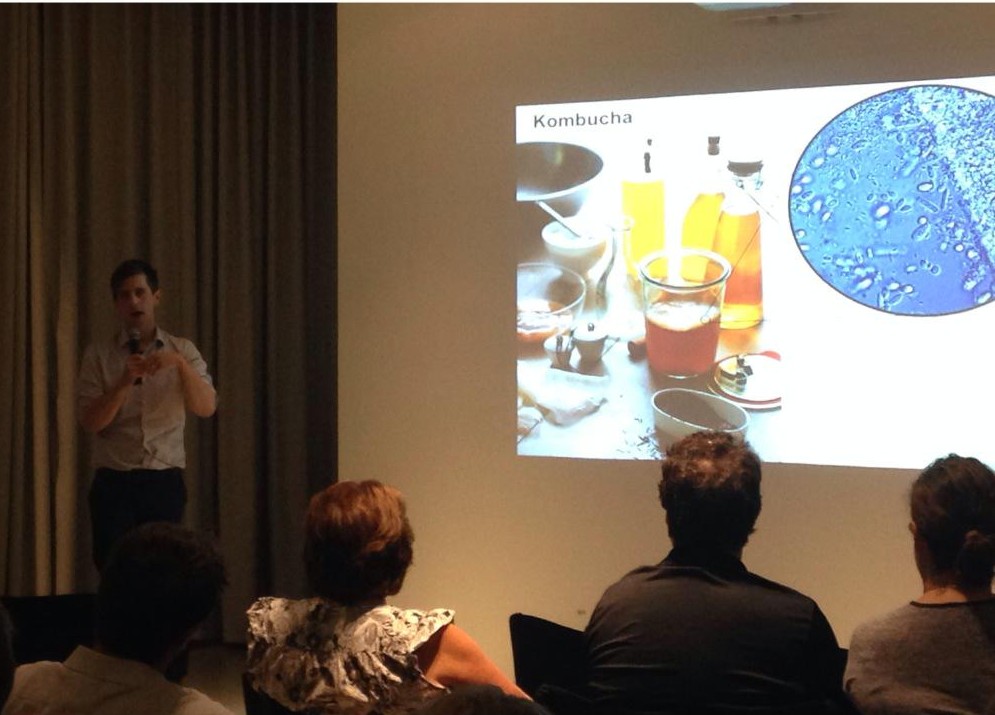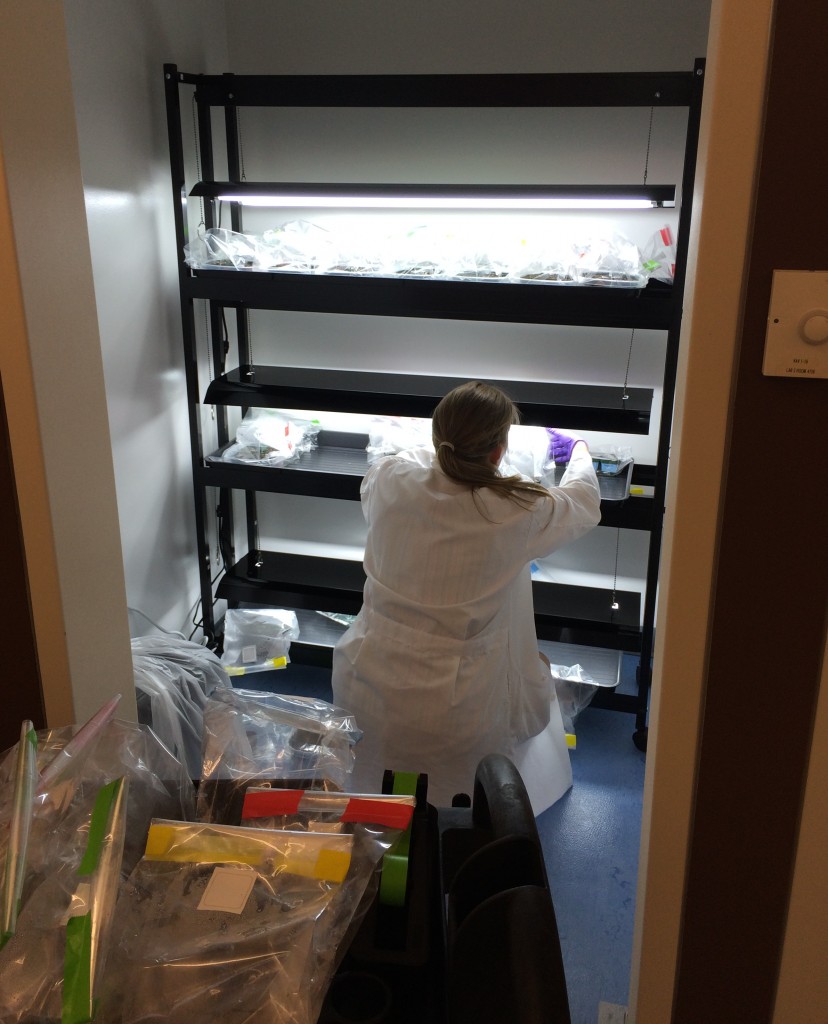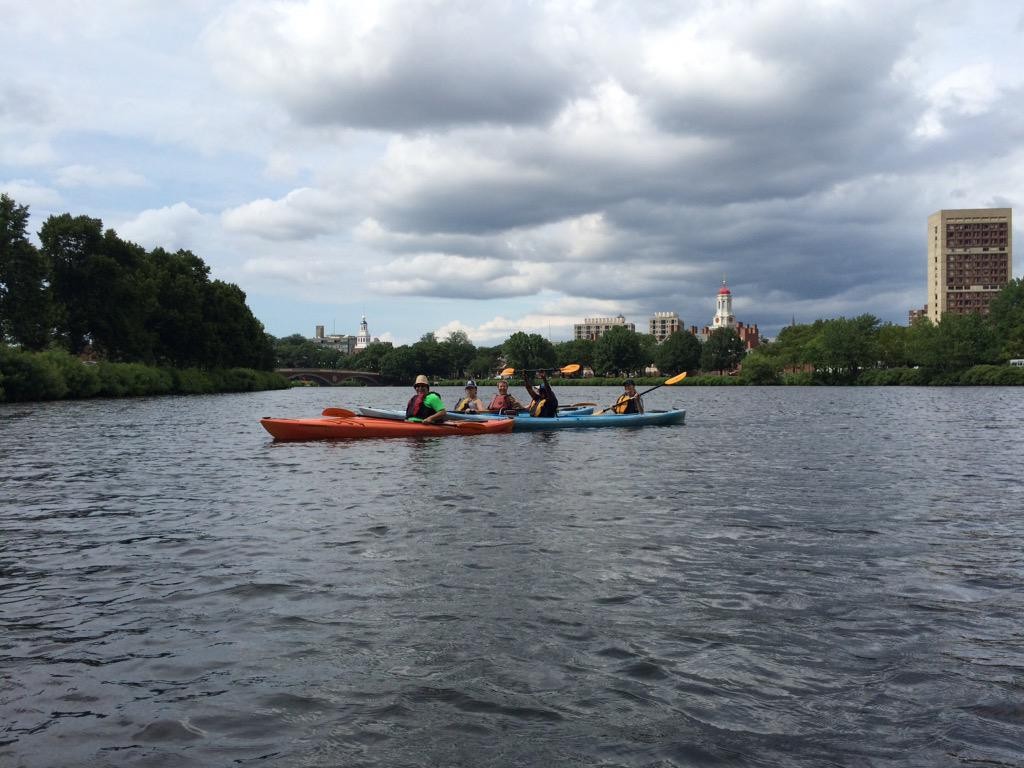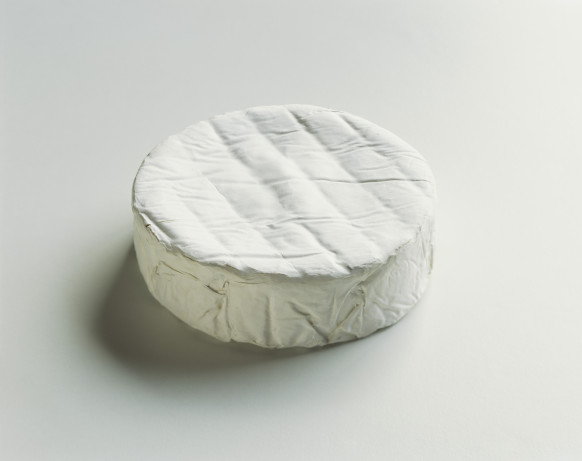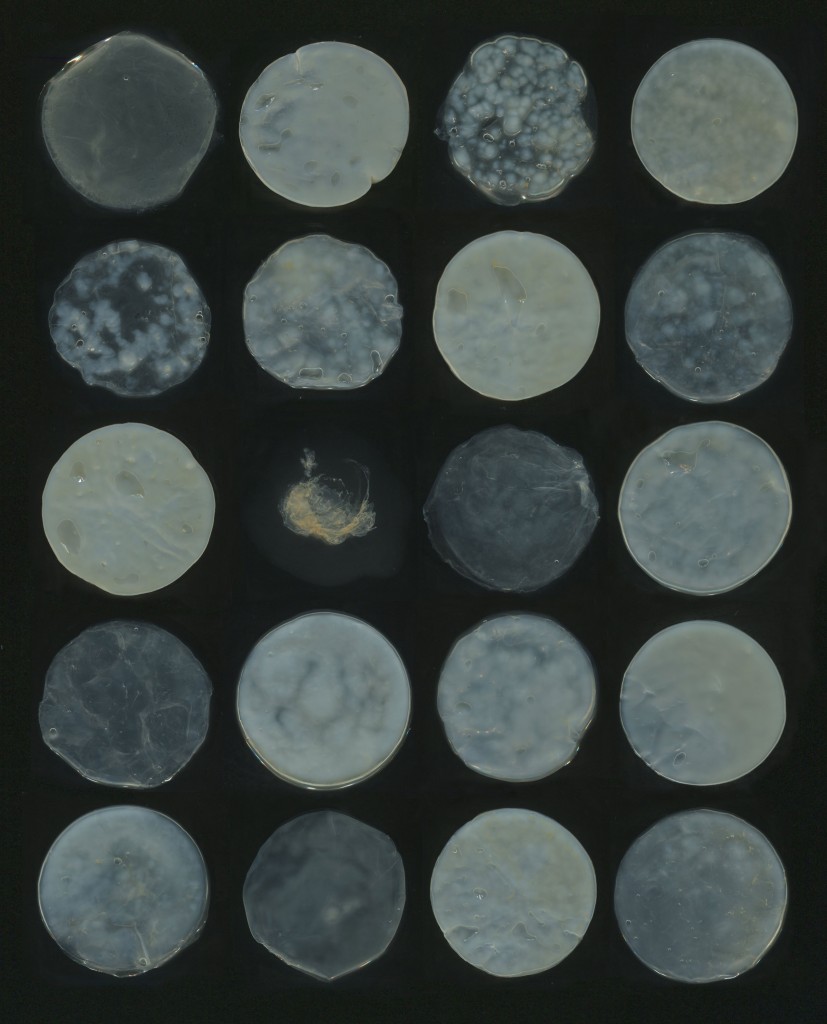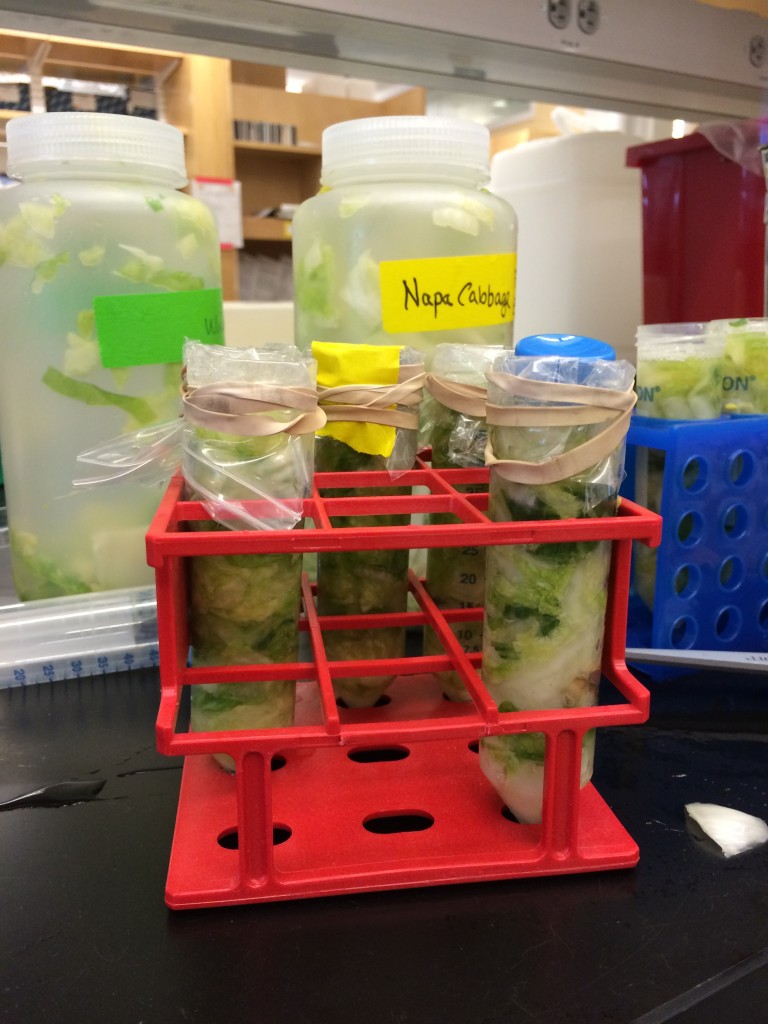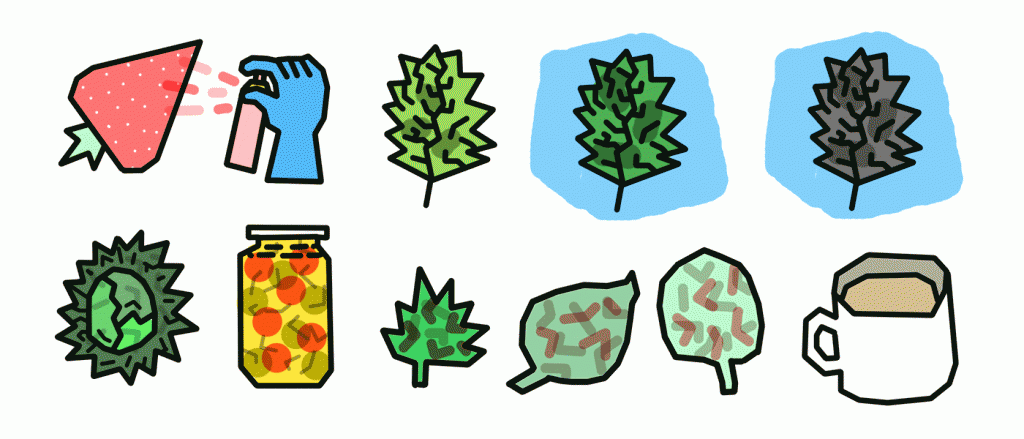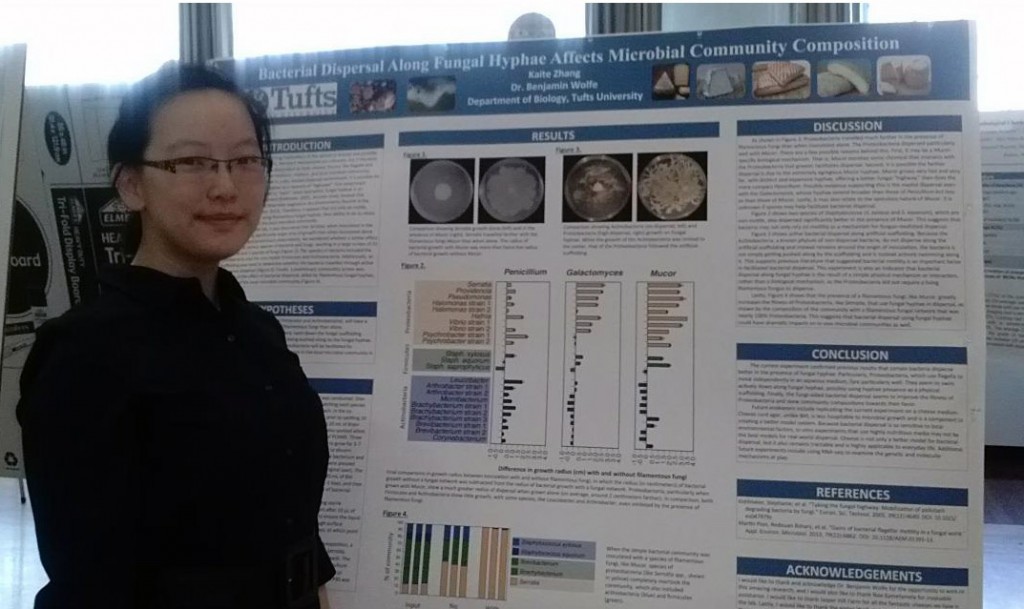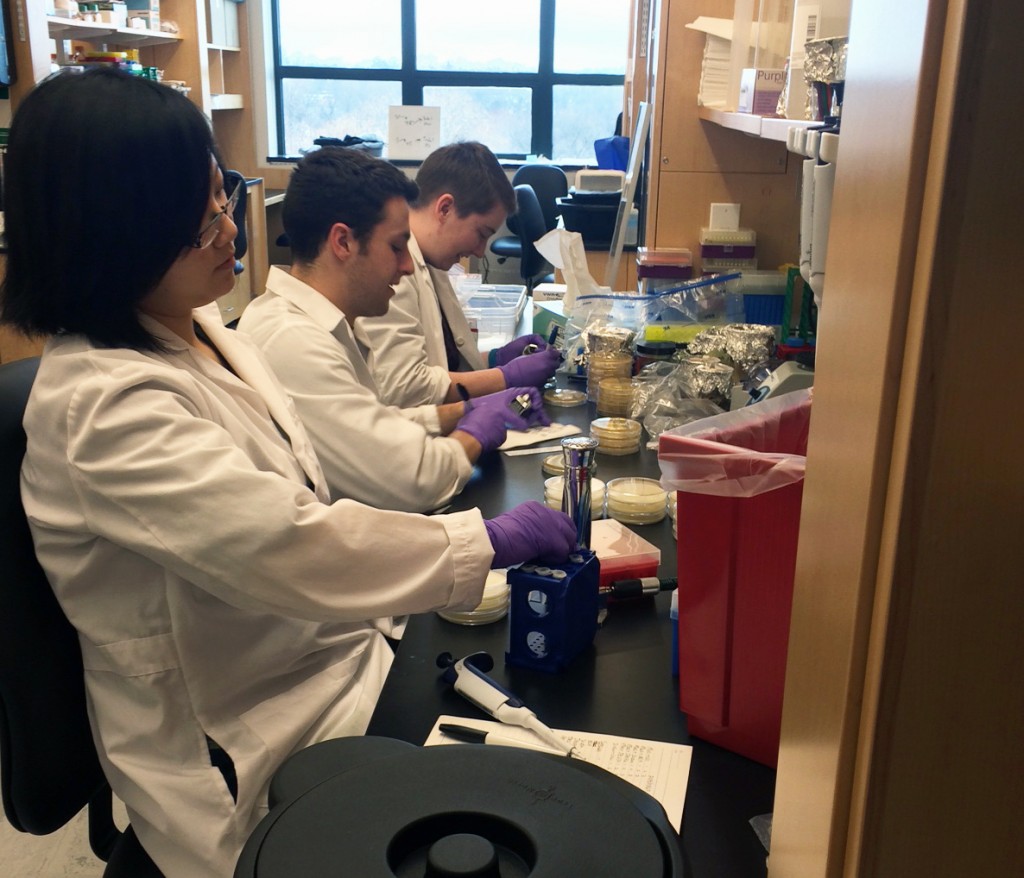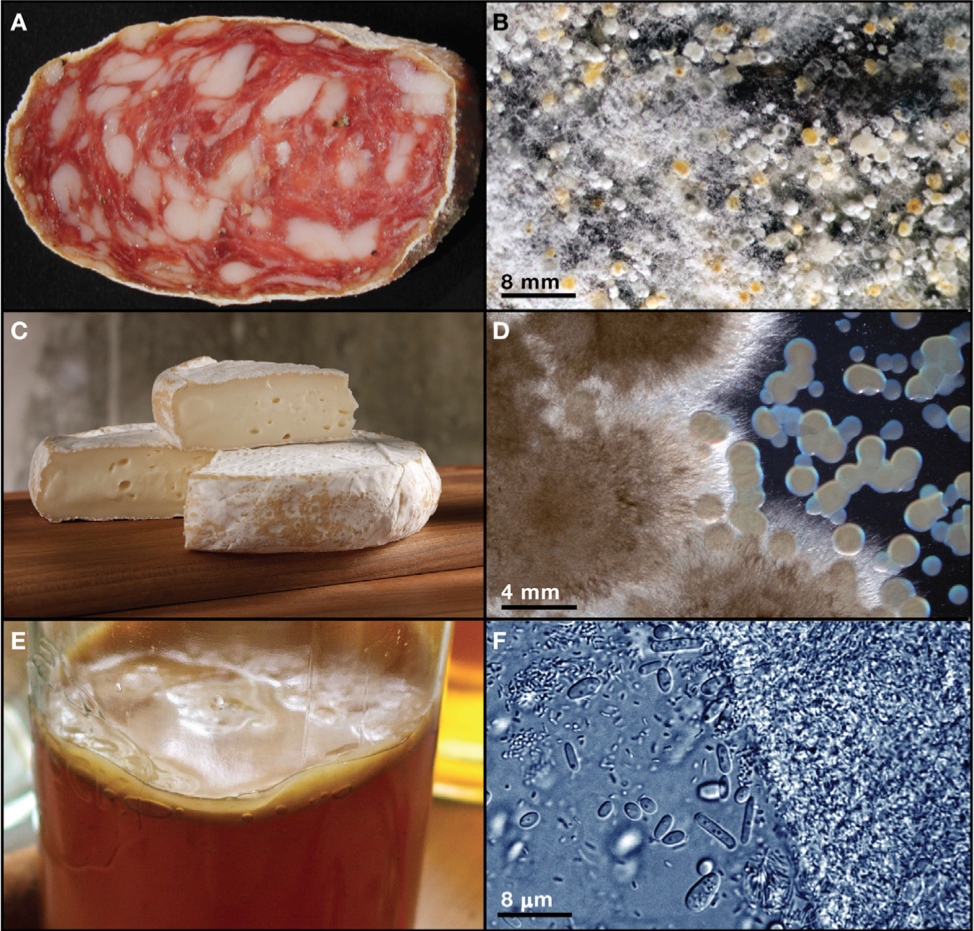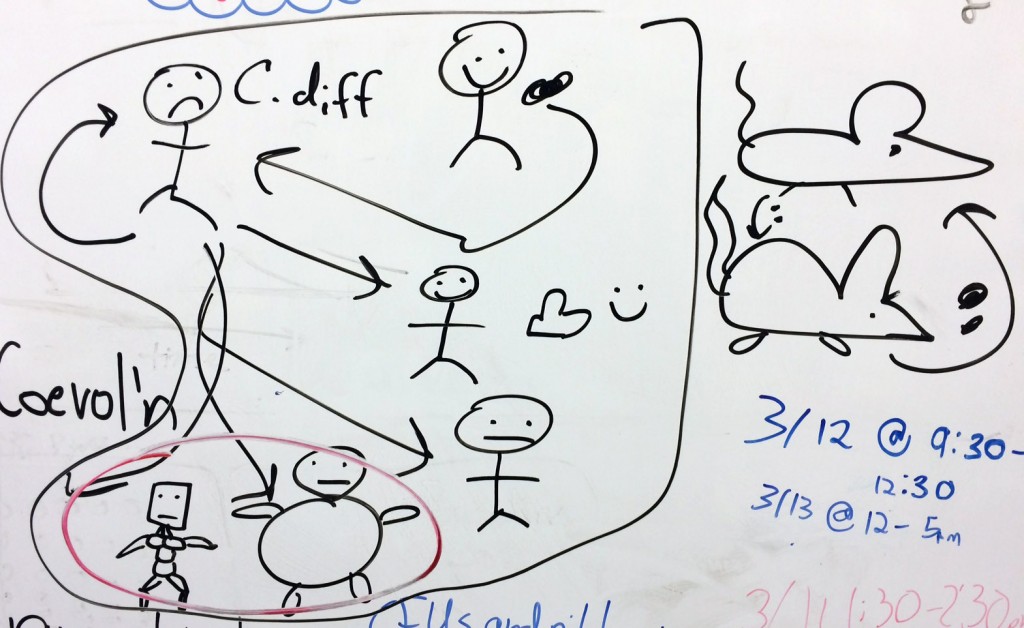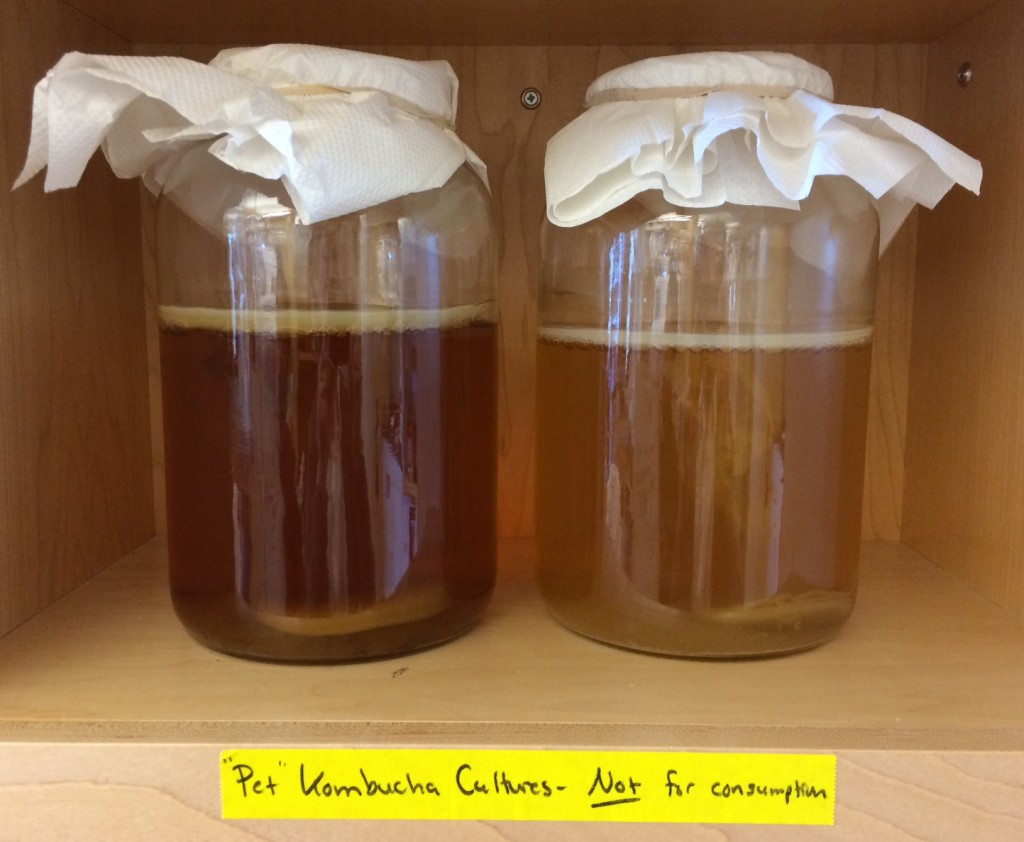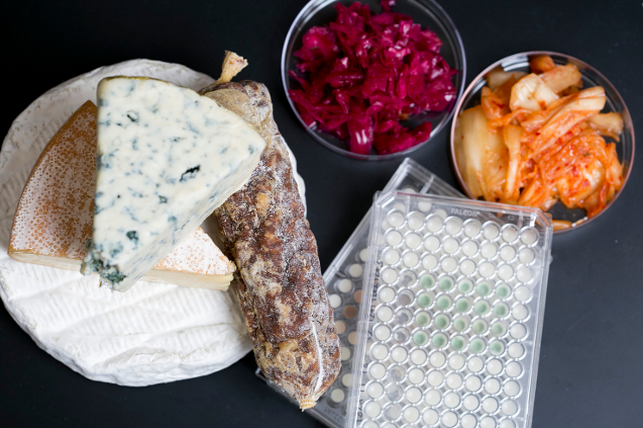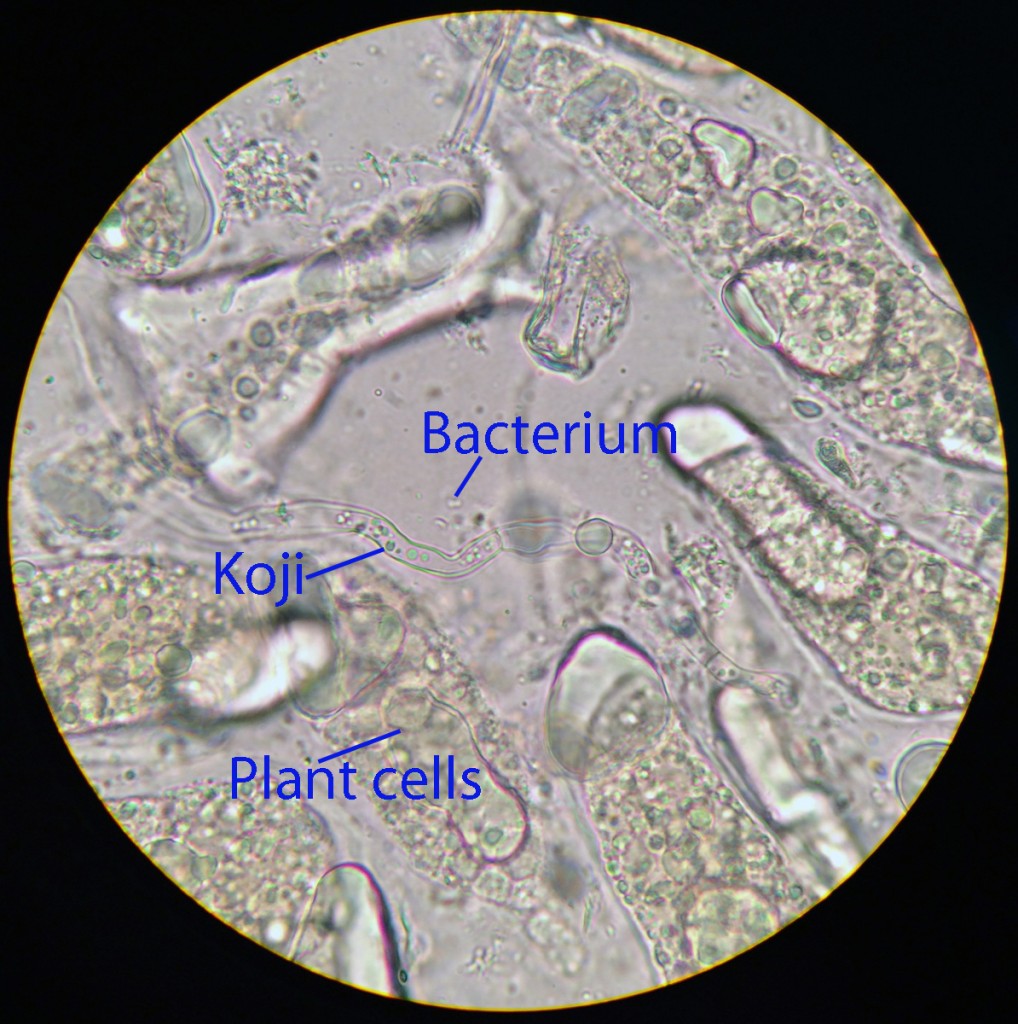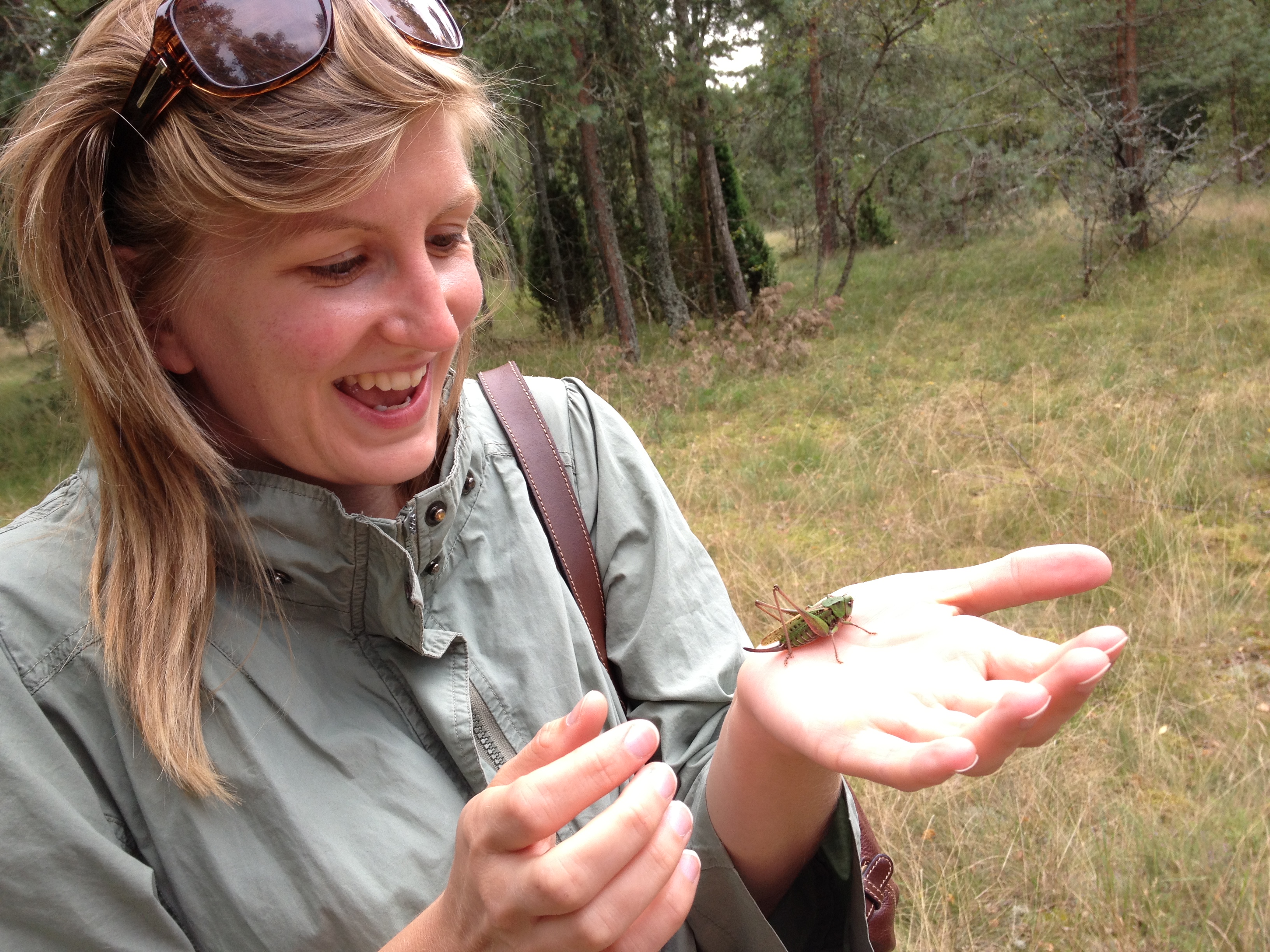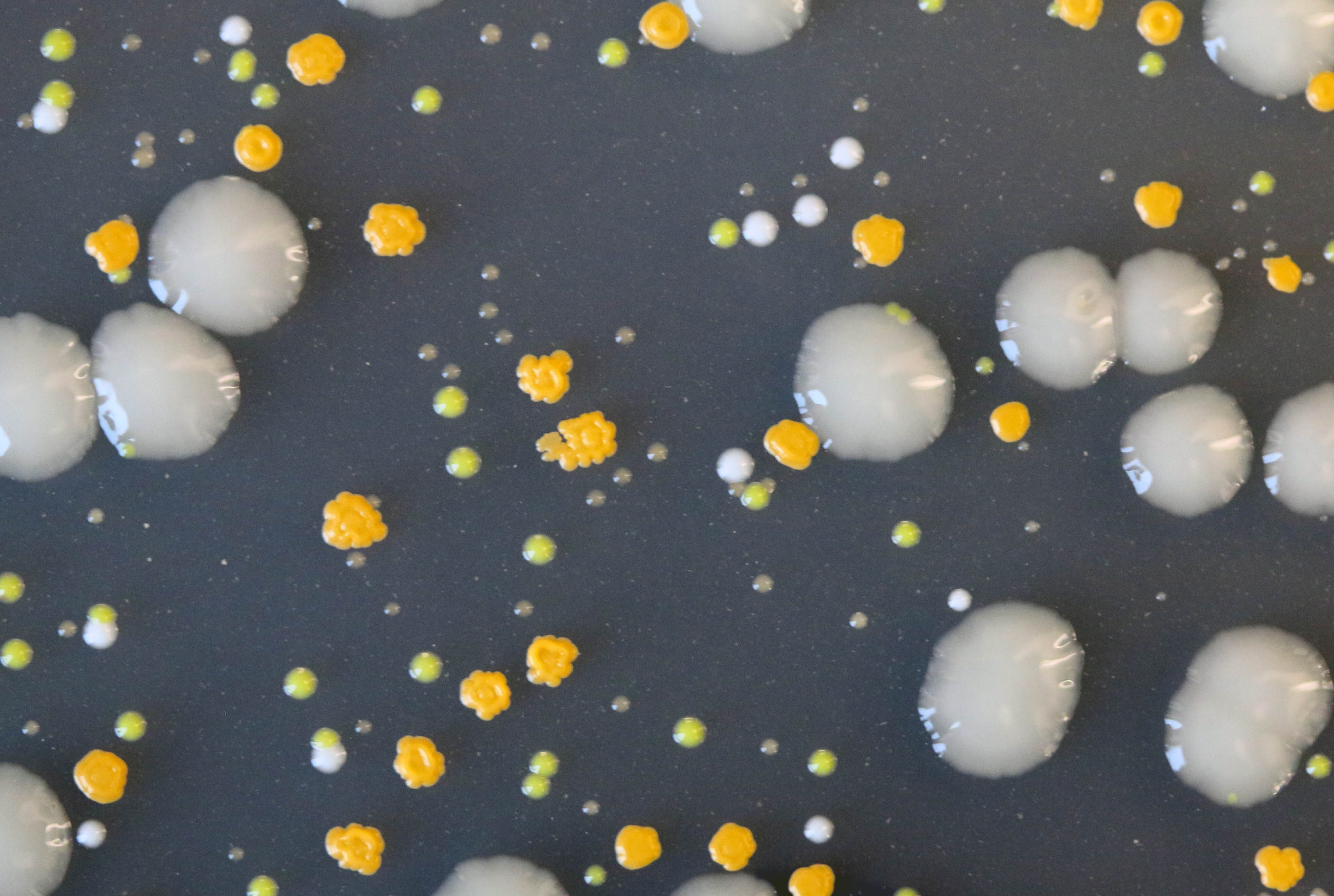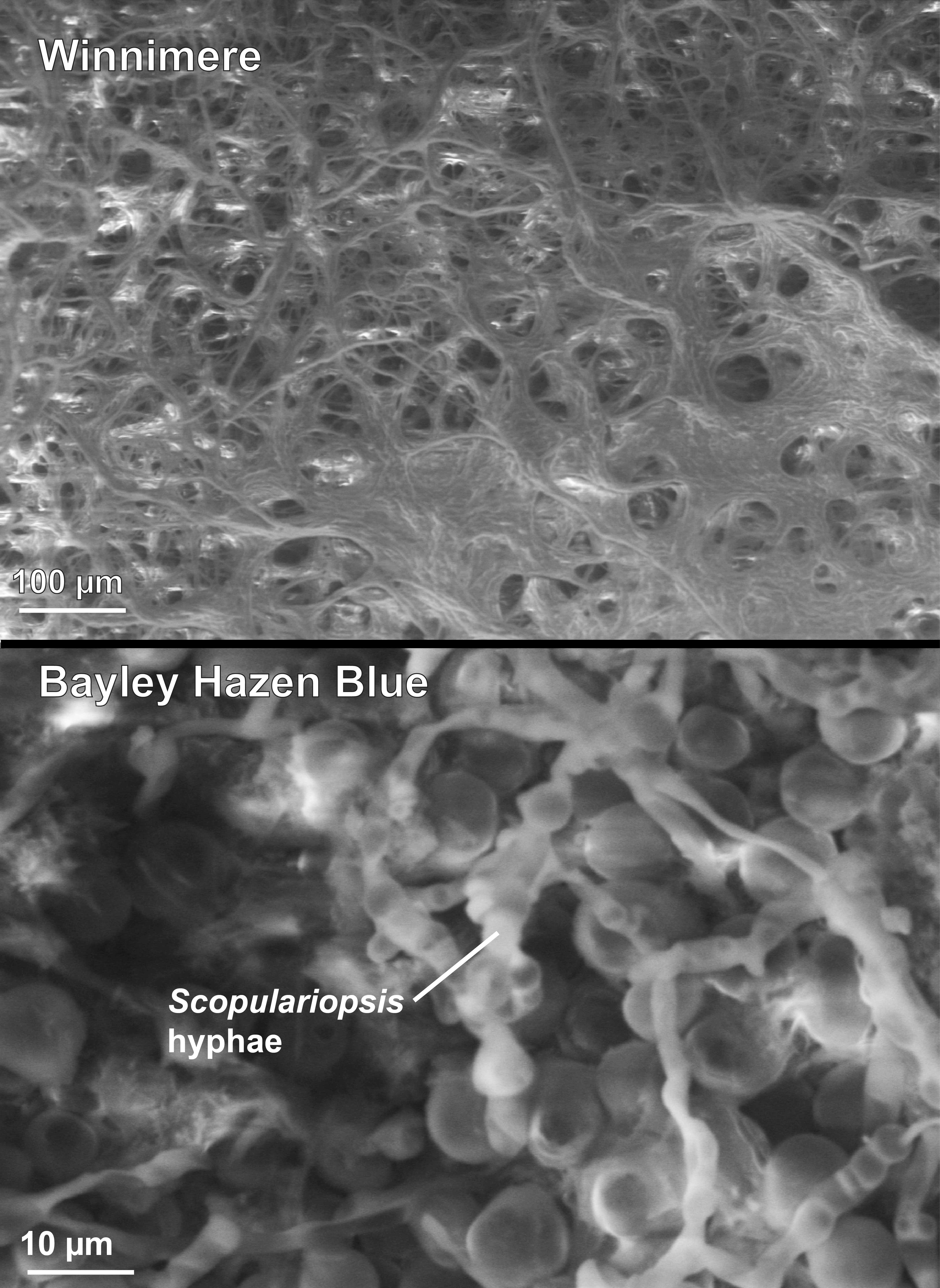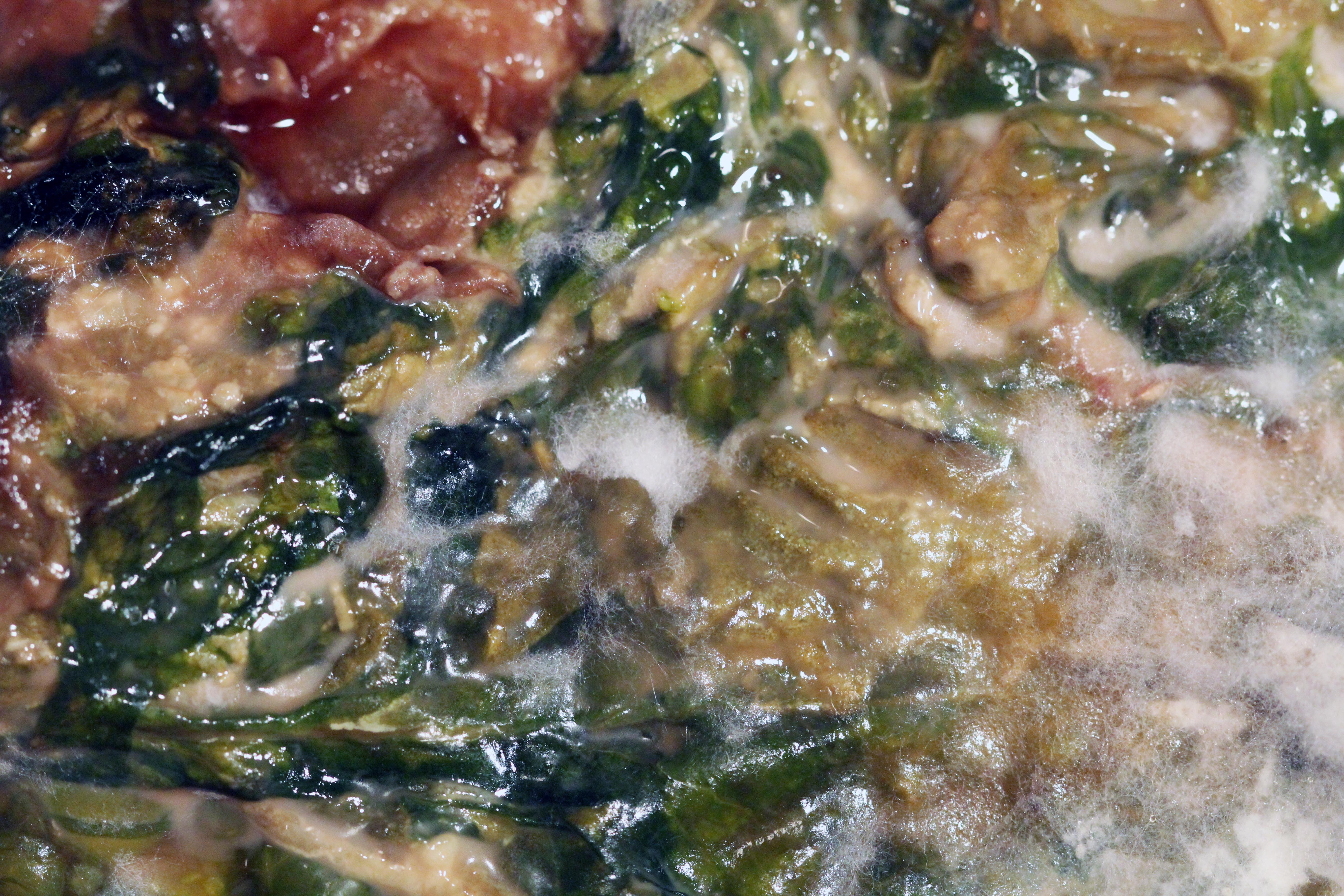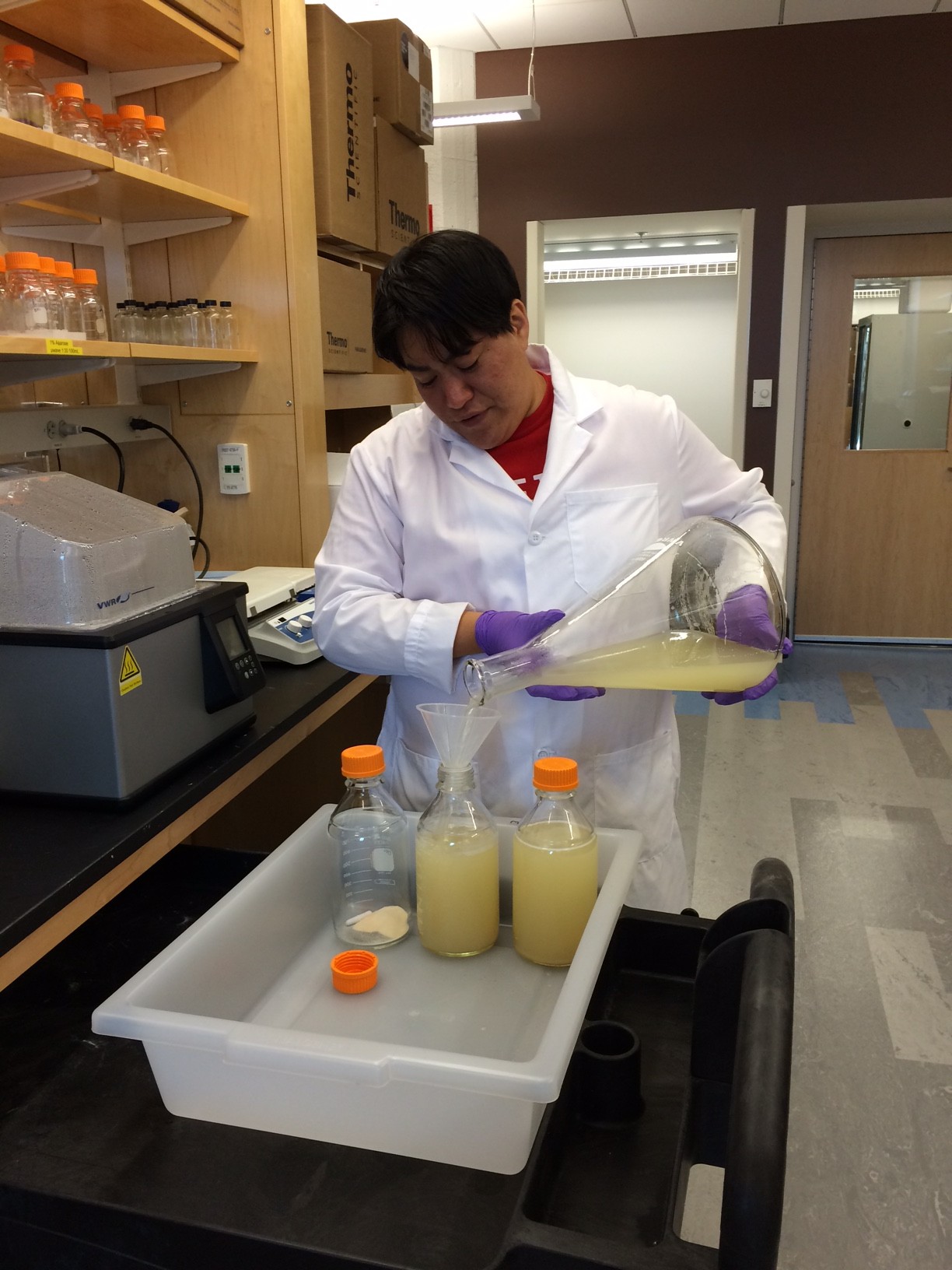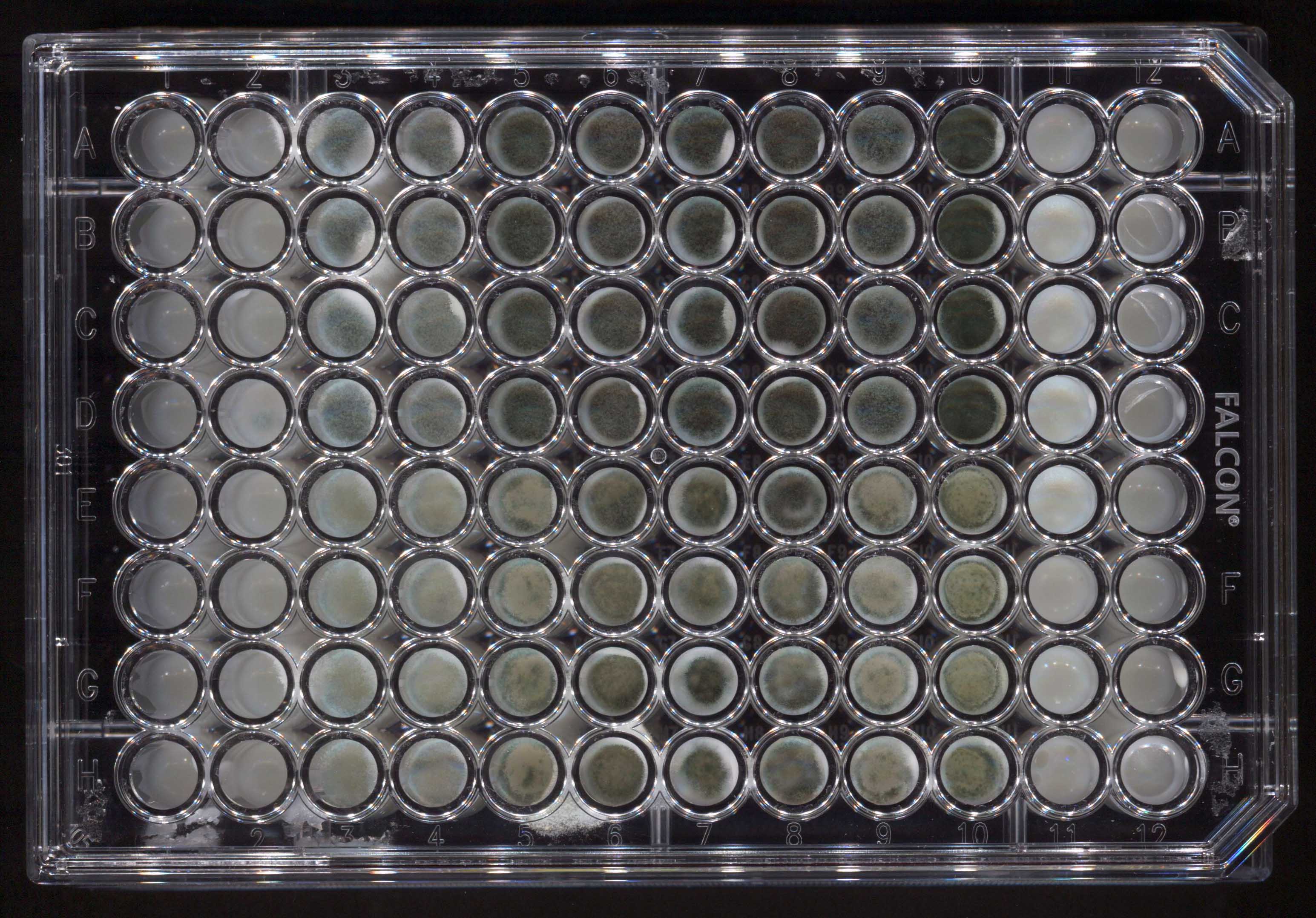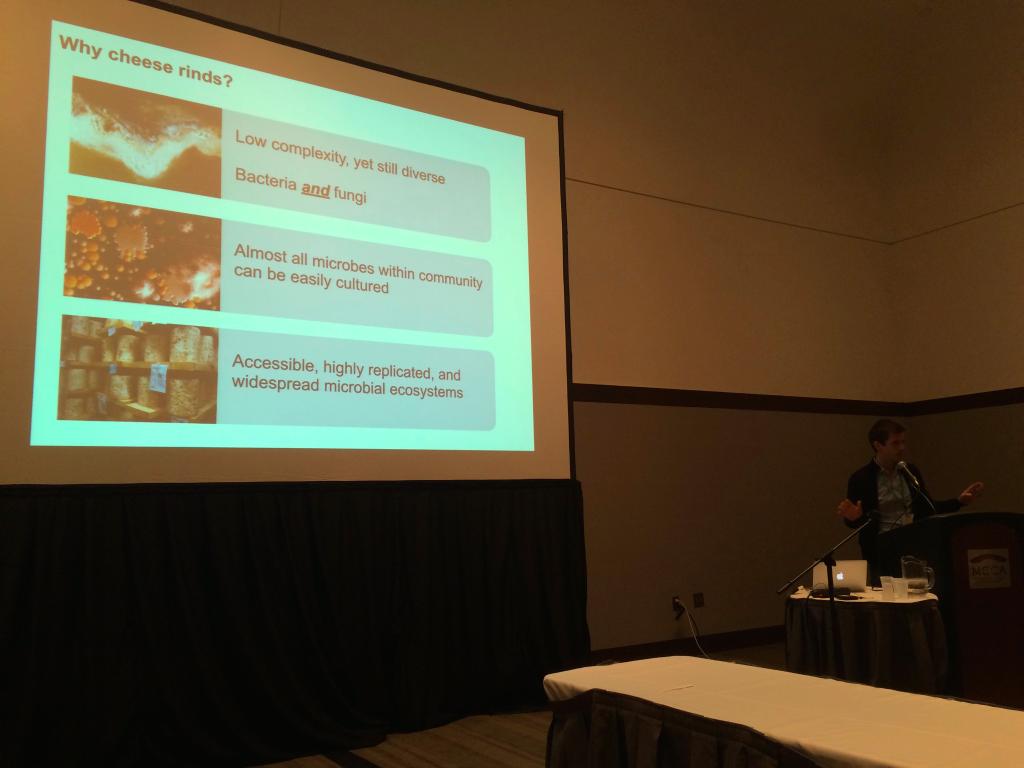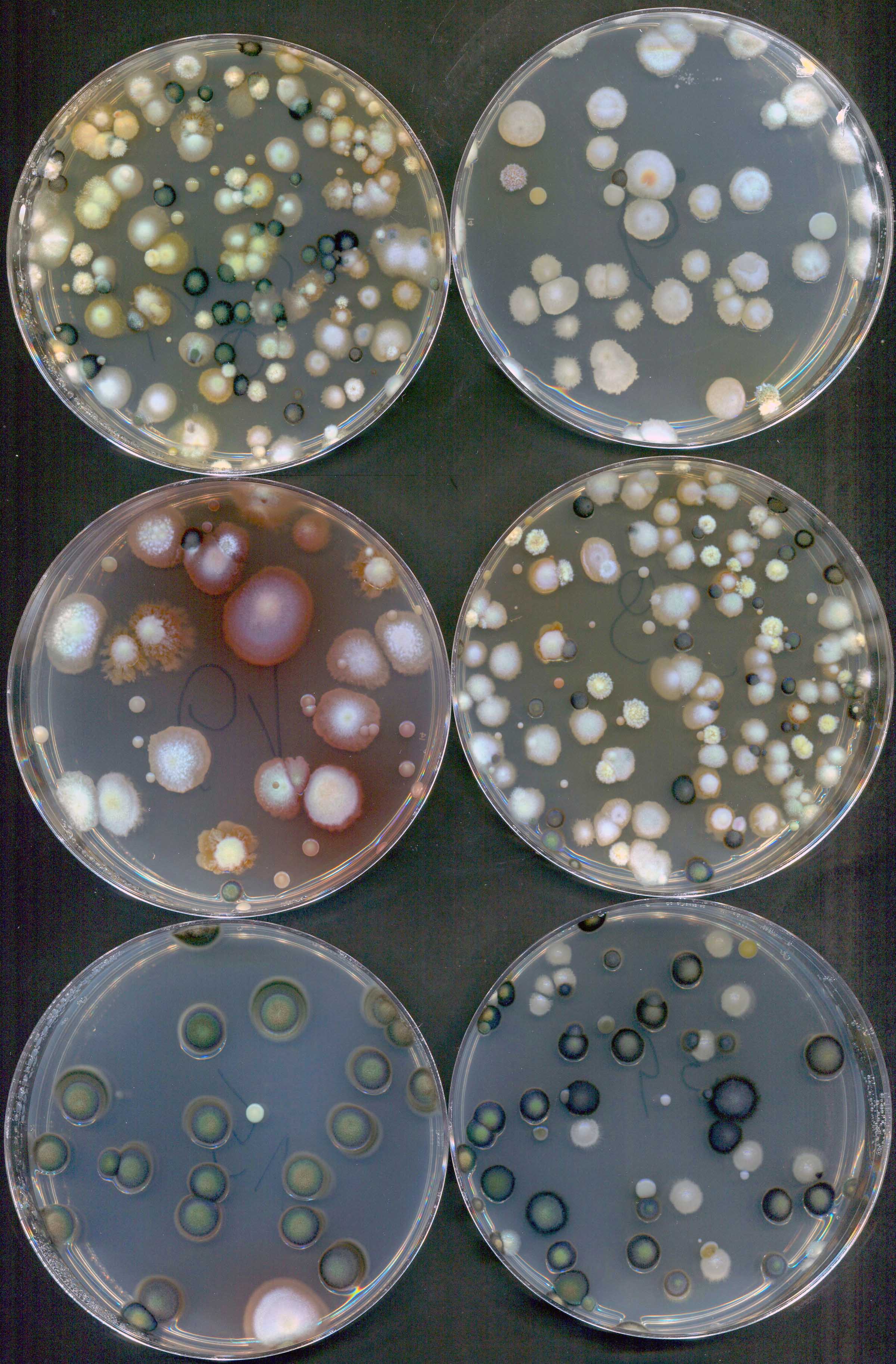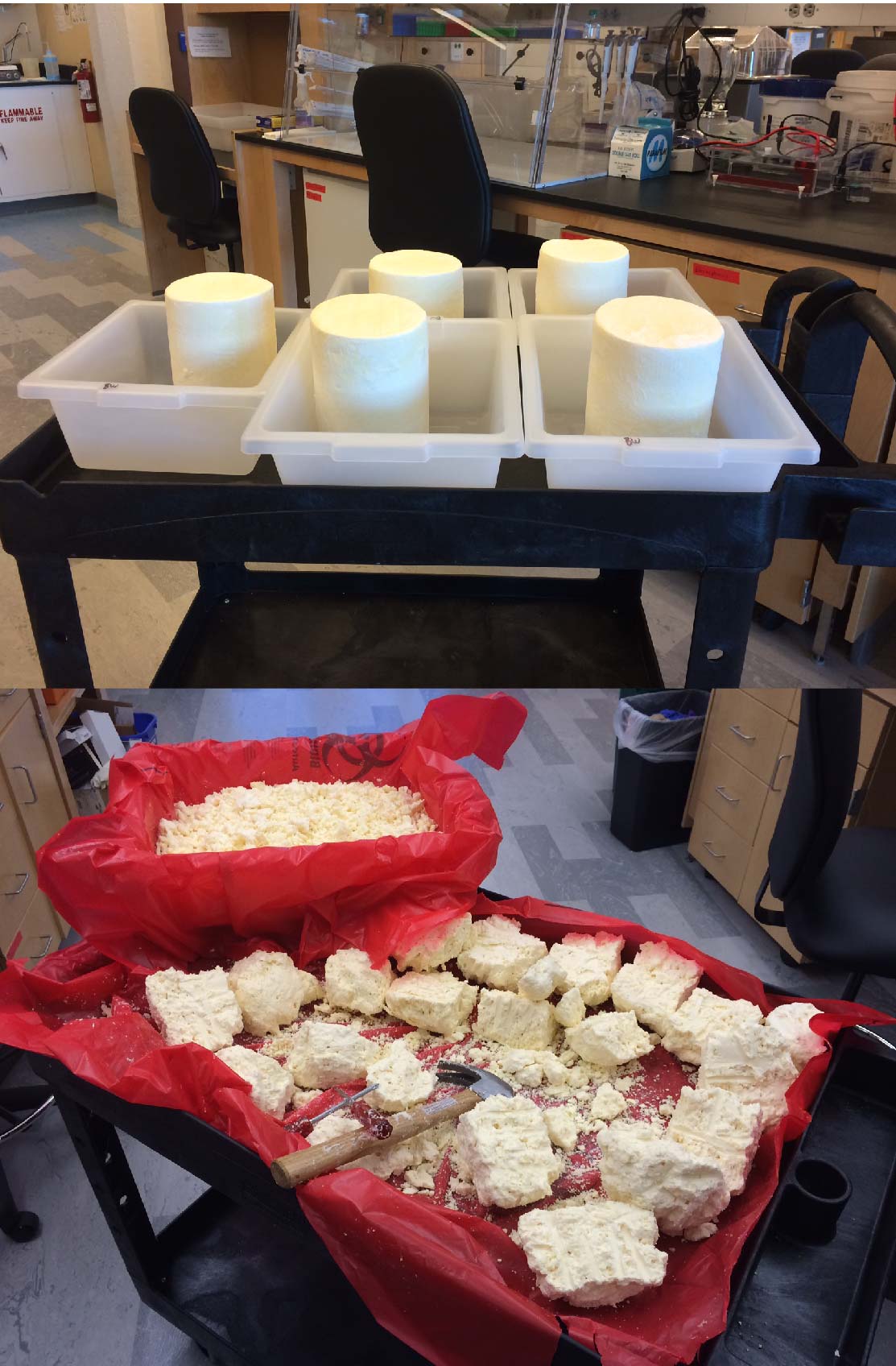We strongly believe that what we do within the walls of our lab should be shared as openly as possible with the rest of the world. On this Open Lab page, we’ll share news, events, publications, and exciting developments so you can follow what we’re working on.
September 2023:
September 6: Here Nicolas is breaking up frozen wheels of fresh (not aged) blue cheese that we will turn into our cheese curd agar medium. For more info about how this is made, please check out our methods paper here (contact Ben Wolfe for a PDF if you cannot access this article).
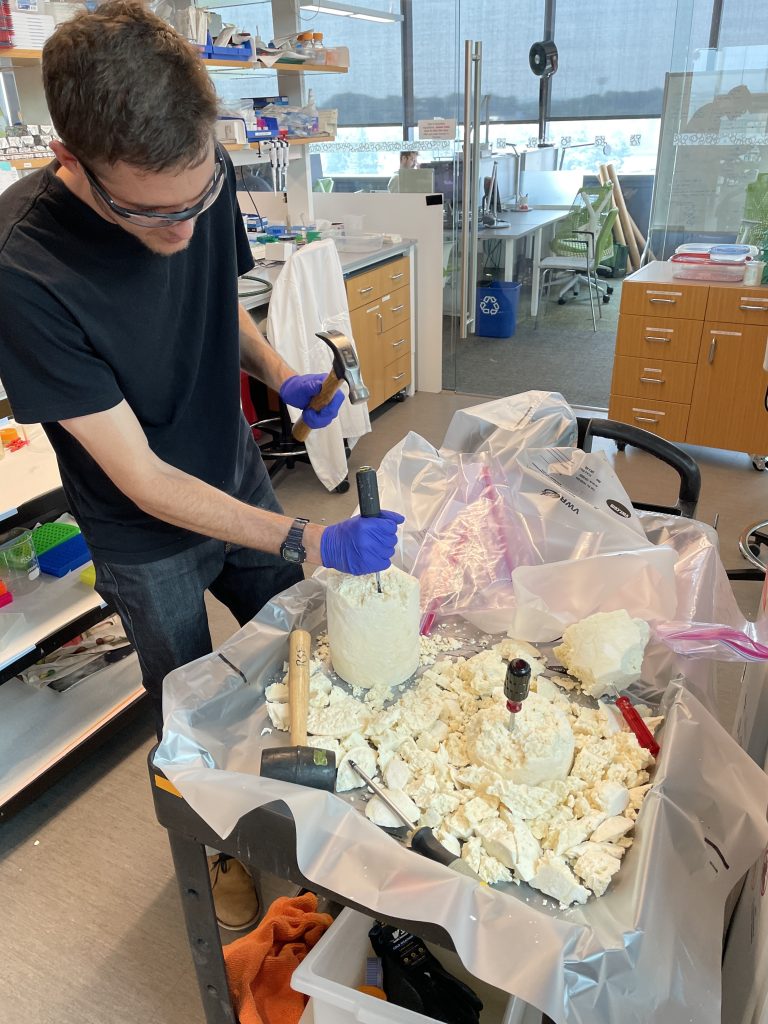
October 2023:
October 30: We are delighted that visiting post-doc Caroline Kothe is working in the lab this semester. Coming from the group of Joshua Evans at the Danish Technical University, Caroline is working on the microbial ecology and evolution of plant-based cheeses.
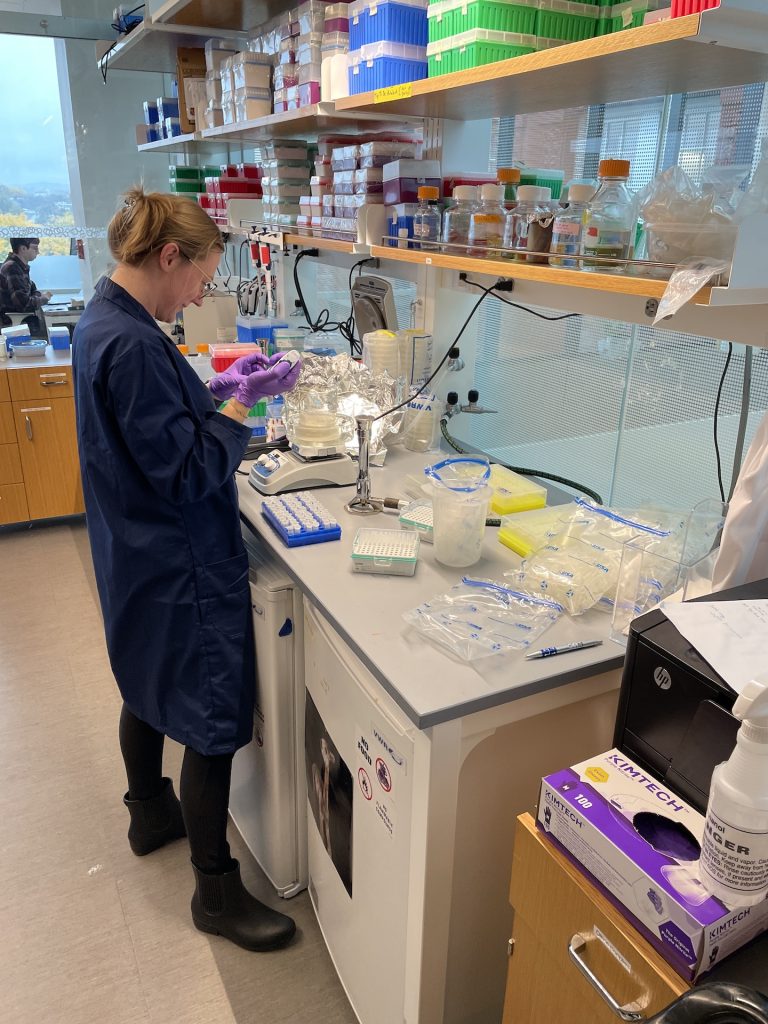
August 2022:
August 15: Ben wrote an article about what you can learn from home microbiome testing kits for The Conversation. The quick take-home message: kits from different companies can give you varied results and may not be able to help you dramatically improve your microbiome as promised.
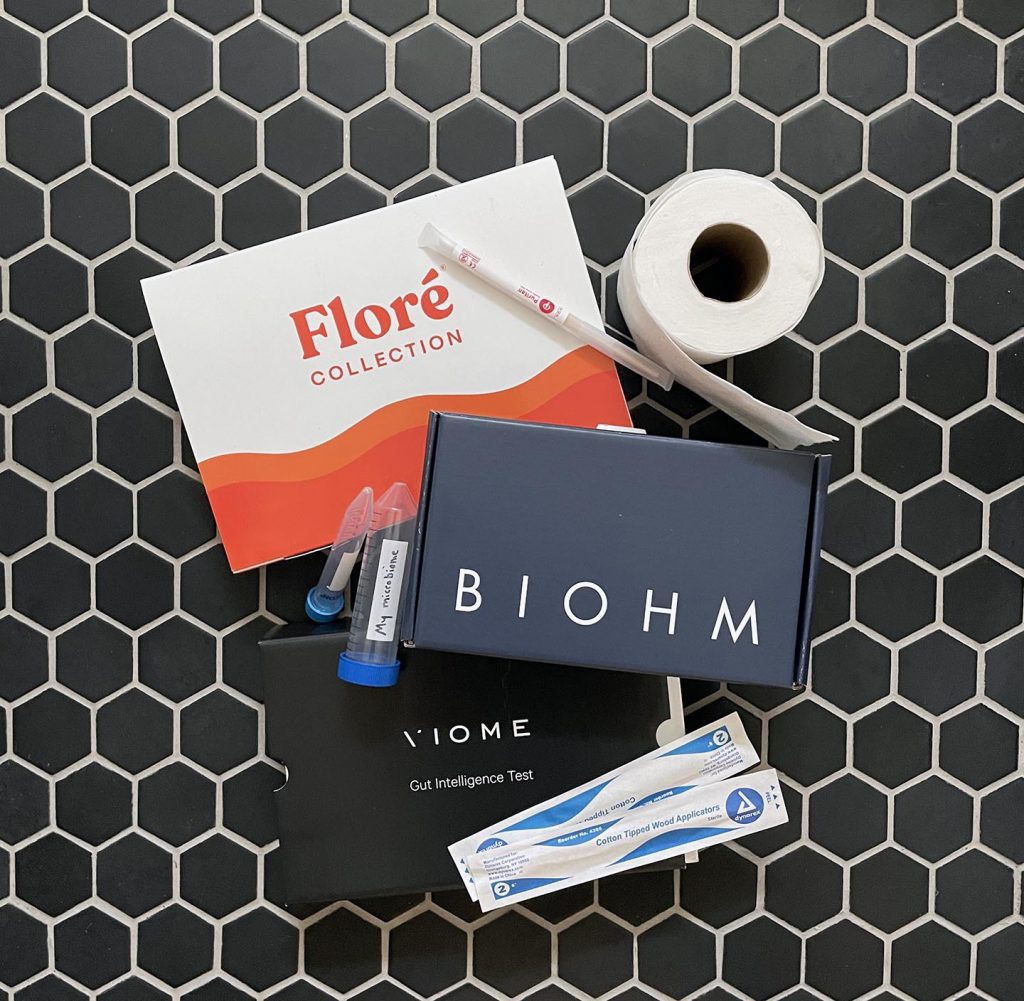
August 8: As part of our collaborative grant from the Northeast Dairy Business Innovation Center, we have been working to link microbial, chemical, and sensory properties of artisan cheeses made in Vermont. Here you can see Shayna, Roy (UVM collaborator), Nicolas, and Scott Frost (post-doc in the Orians lab at Tufts) picking up a batch of cheese from Spring Brook Farm in Reading, Vermont.
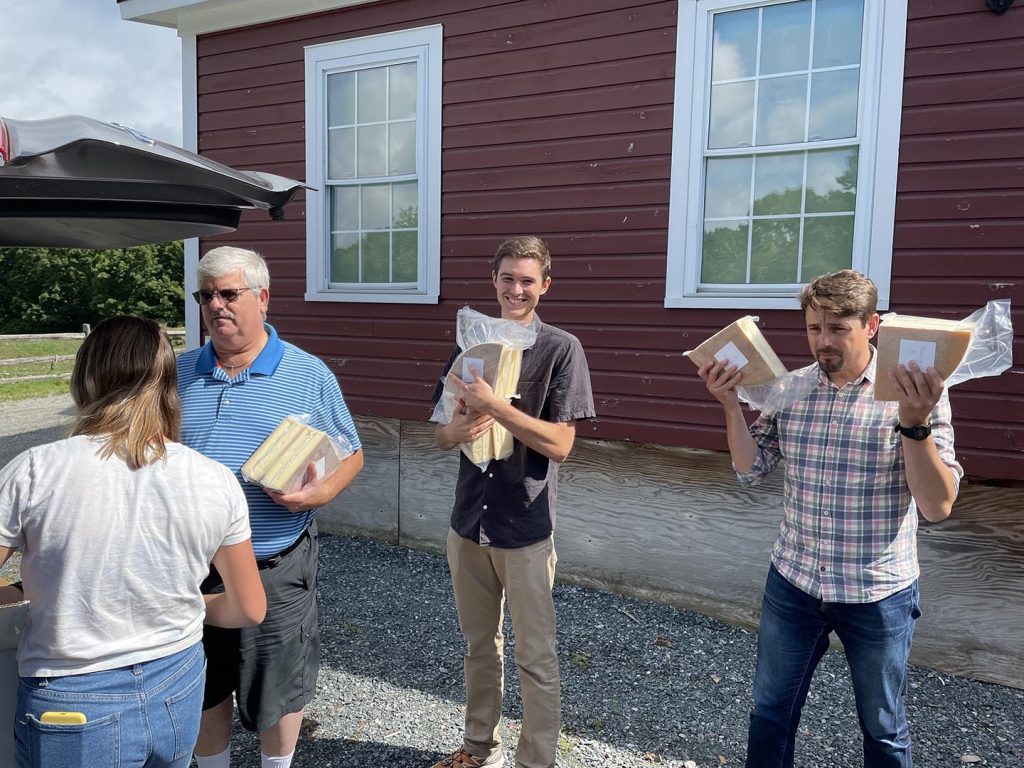
July 2022:
July 5: We are genotyping a lot of Pseudomonas colonies that were competing with each other in fitness experiments. This is part of our NSF CAREER grant examining how biotic interactions impact the evolution of bacterial species. Here you can see Mak isolating colonies for PCR by tapping the colonies with wooden dowels and then suspending the colonies in water for DNA extraction.
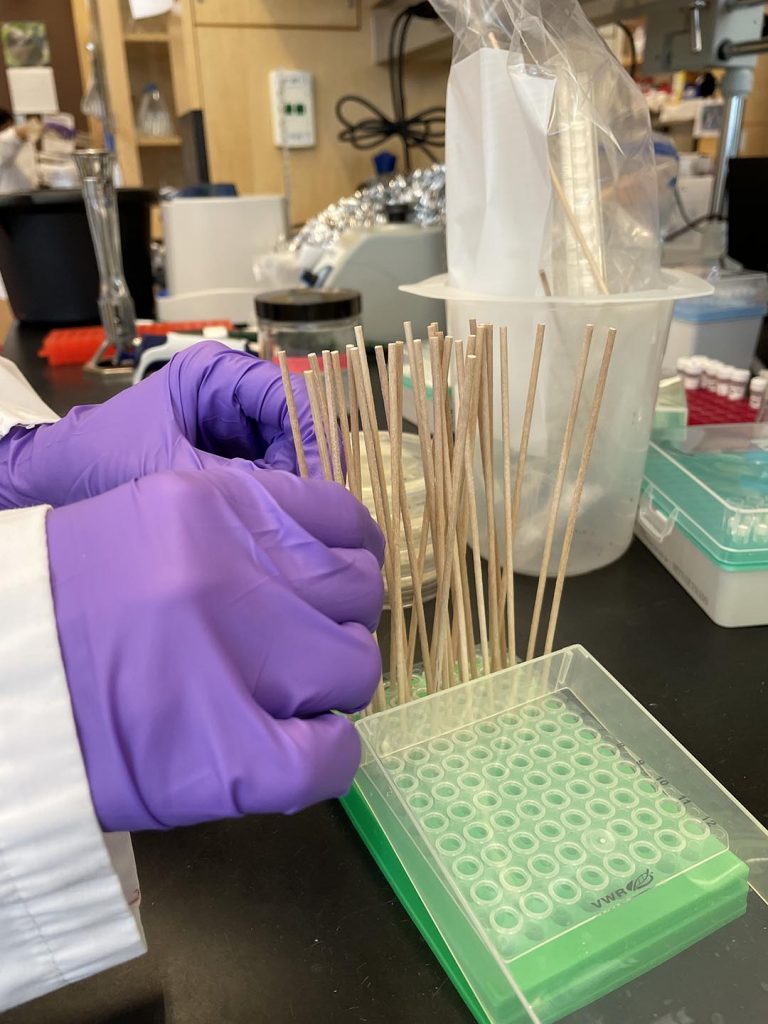
June 2022:
June 11: The lab attended ASM Microbe in Washington, DC. Emily and Ben gave talks and Nina and Ruby gave posters. We were thrilled to be at an in person meeting! The science was fantastic and it was great to reconnect with colleagues.
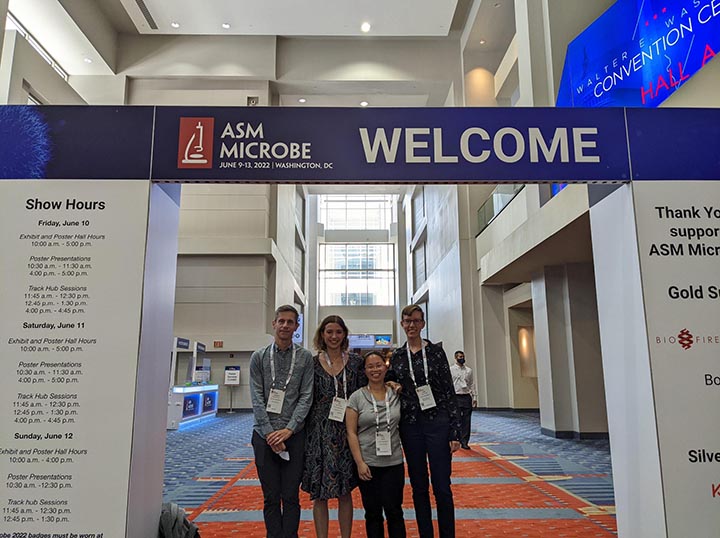
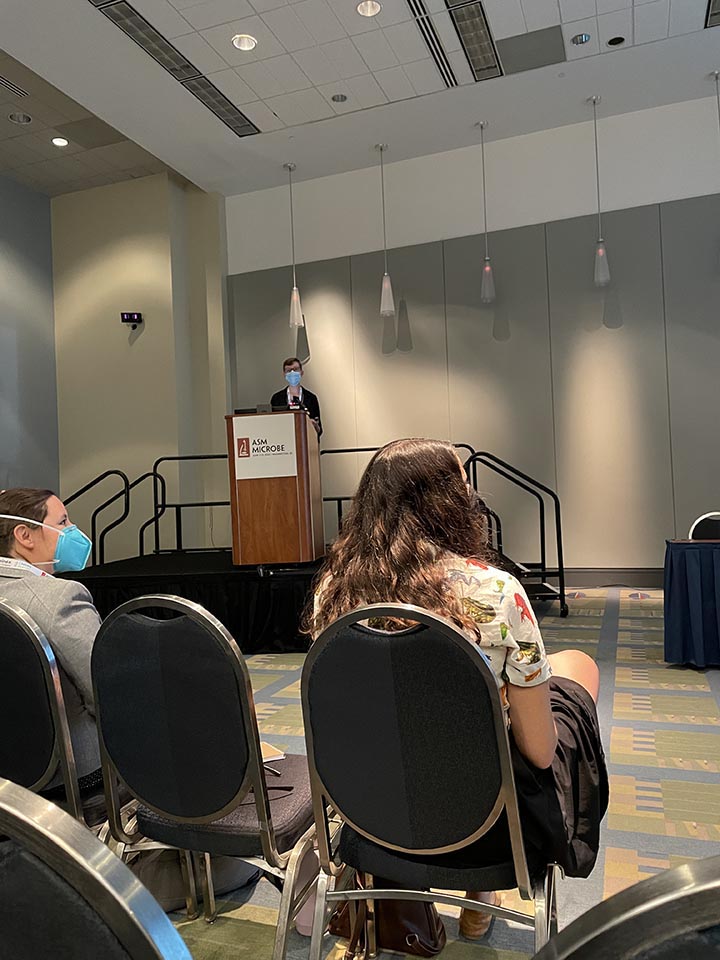
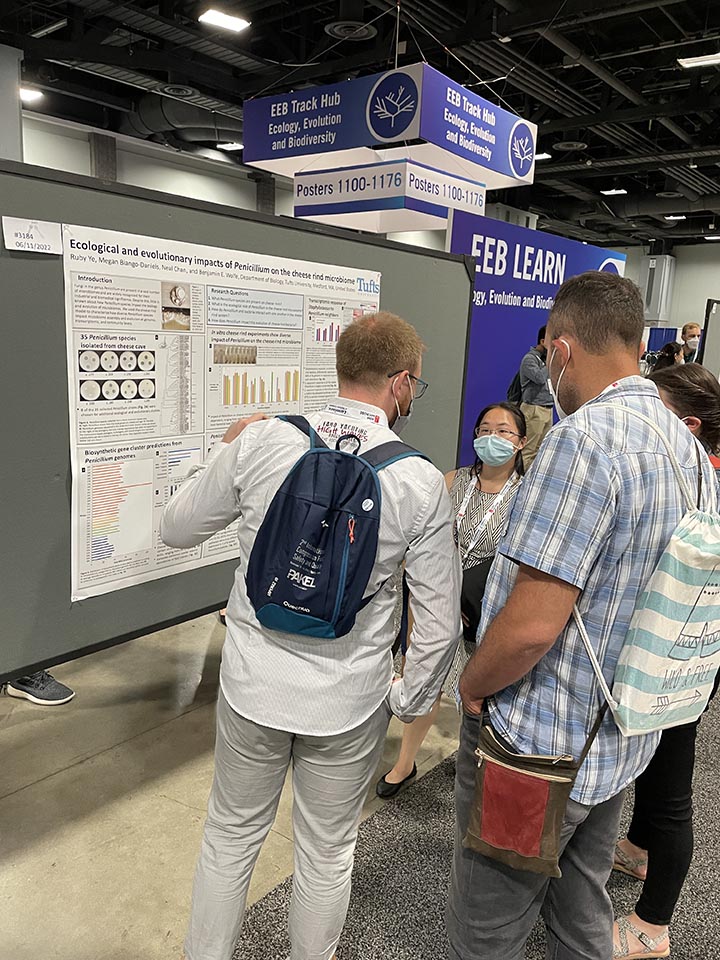

June 7: We kicked off the start of the summer research season with a new lab photo. We are thrilled to have Amelia, Axel, Dillon, Laura, Mak, and Shayna join us this summer to work on undergraduate research projects. From measuring the VOCs of cheese to sequencing Penicillium genomes, it will be a busy and exciting summer!
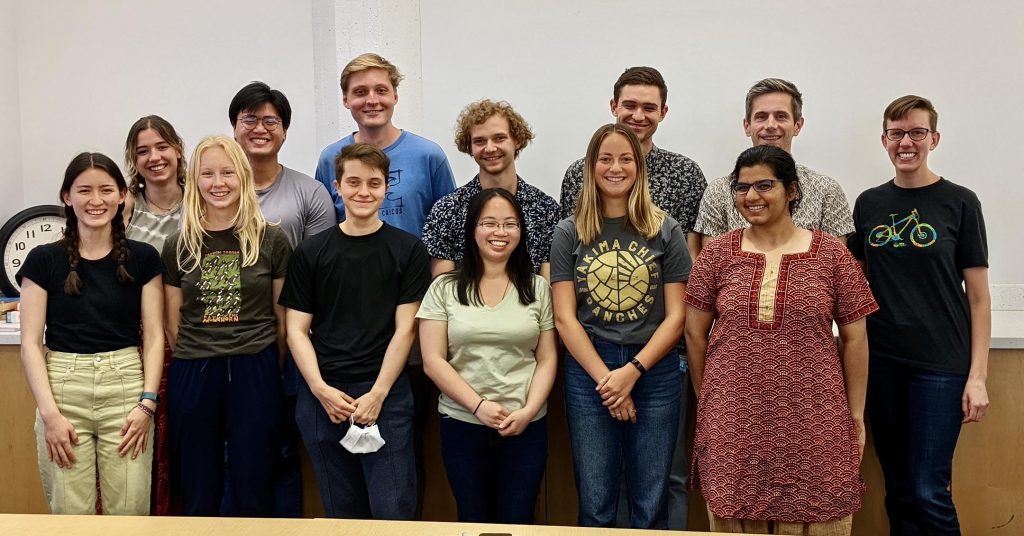
April 2022:
April 1st: We were lucky to visit our friends and collaborators at Jasper Hill Farm to sample cheese rinds. Here you can see Nina, Emily, Ben, and Ruby in the vault where clothbound Cheddar cheese is aged.
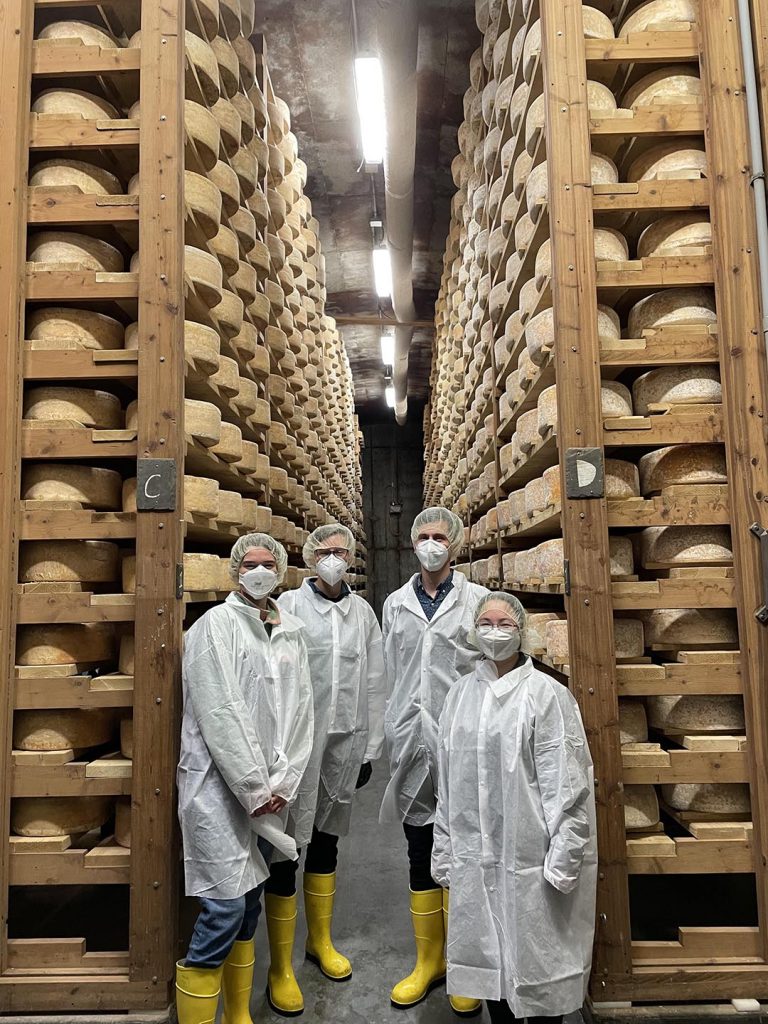
July 2021:
July 1: We are exploring new ways to study mechanisms of interactions between fungi and bacteria across space. In this photo, Ruby and Nina are checking out a trial with Penicillium molds growing with cheese rind bacteria. The dark patches in the Petri dishes are the molds. Three different mold species are being testing here, each with a different pigment profile. The medium used is our cheese curd agar.
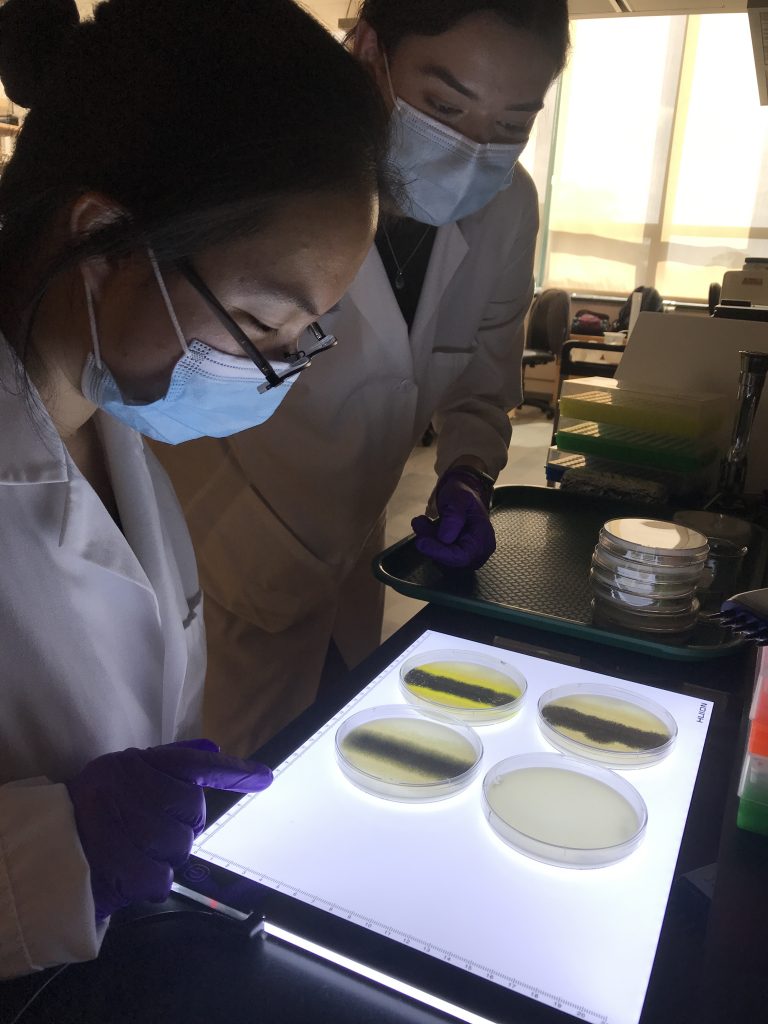
June 2021:
June 16th: Ben and Professor Maria Marco of UC Davis presented an overview of methods for microbiome analysis of fermented foods in a webinar for The Fermentation Association. This webinar is perfect for fermented food producers and enthusiasts who are curious about how microbiome data could be used to study or monitor their ferments.
June 14th: As part of his summer research project, undergraduate researcher Robert May has been studying fluorescence Pseudomonas bacteria that live in cheese rind microbiomes. In the photo below, Robert is pointing to several isolates of Pseudomonas that are glowing brightly under a blacklight
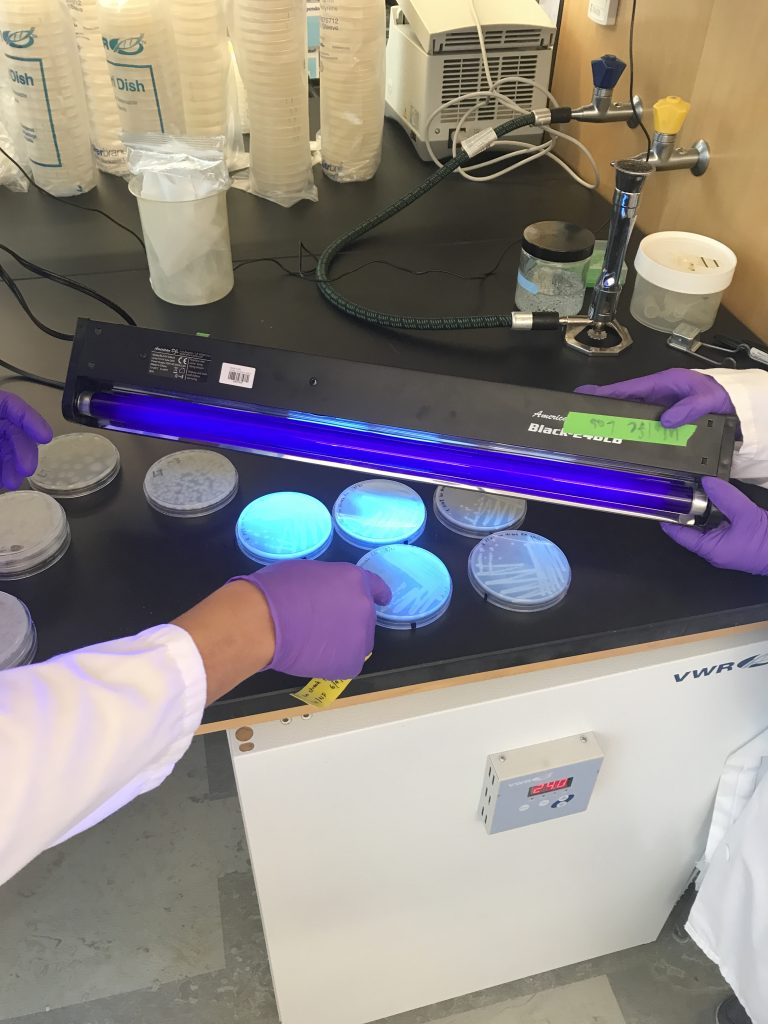
January 2021:
January 26th: Our large study of sourdough starters, headed by Liz Landis (and with many awesome collaborators!), is now out in eLife. Humans have relied on sourdough starter microbial communities to make bread for thousands of years, but only a small fraction of global sourdough biodiversity has been characterized. Our paper describes the bacterial and fungal diversity of 500 (!) sourdough starters sent to us by an incredible network of community scientists. Starters were mostly from the US (429/500), but also included Canada, Europe, and some of Australasia.

January 15th: We are very excited to have Chef Cortney Burns visiting the lab to learn about fermented food microbiomes.
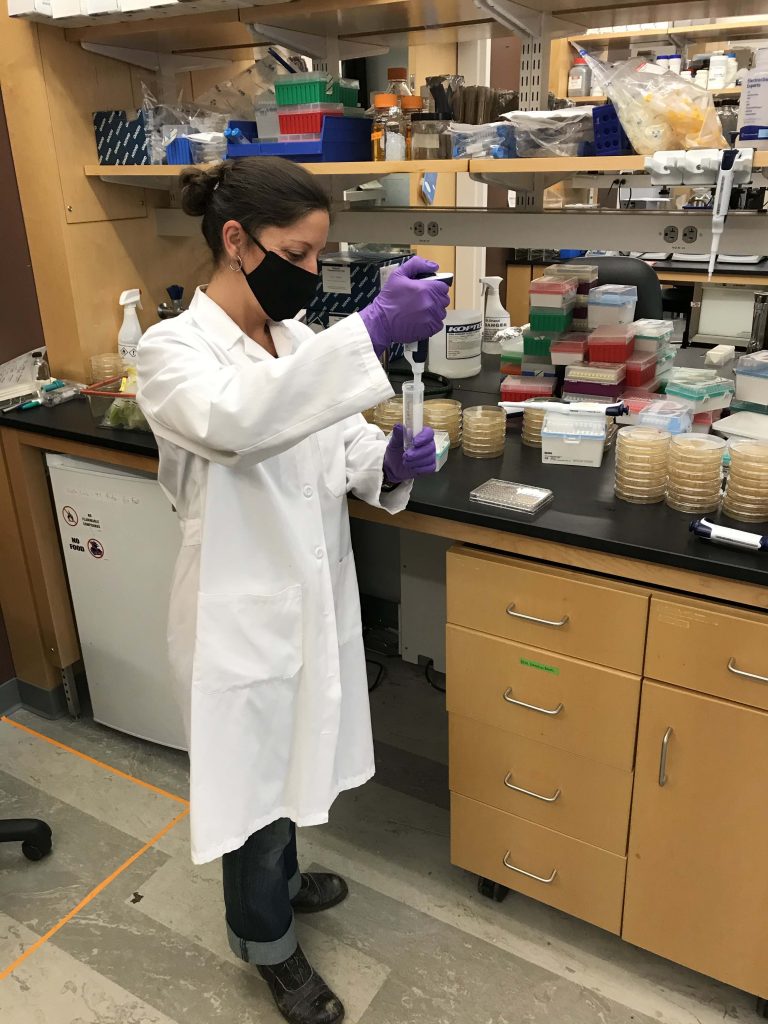
November 2020:
November 23rd: Students in Ben’s course Microbiome Research Lab are exploring how fungi in cheese rinds produce antibiotic compounds. Here is a plate showing some fungi with strong antibacterial activity! The orange “lawn” is a bacterium spread across a Petri dish containing nutrients. Each circle on the plate is a “plug” of either fungi (top left and bottom plugs) or a control plug with just media (top right). The areas around the fungi where the bacterium is not growing are due to something the fungi secrete into the medium that can kill bacteria. We are excited to work with chemistry collaborators to better understand what those compounds might be!
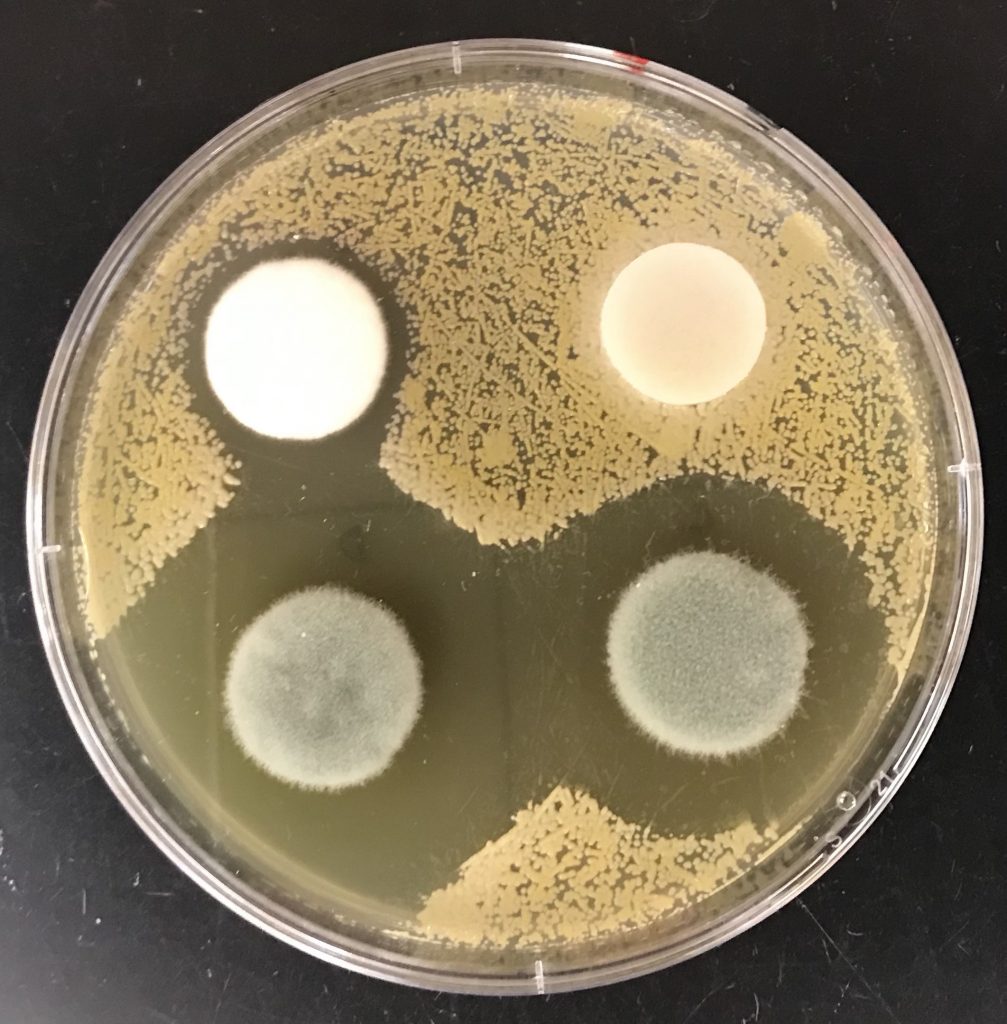
September 2020:
September 27th: Casey Cosetta’s paper on how fungal volatiles can mediate interactions and community development in our model cheese rind system is out in Environmental Microbiology.
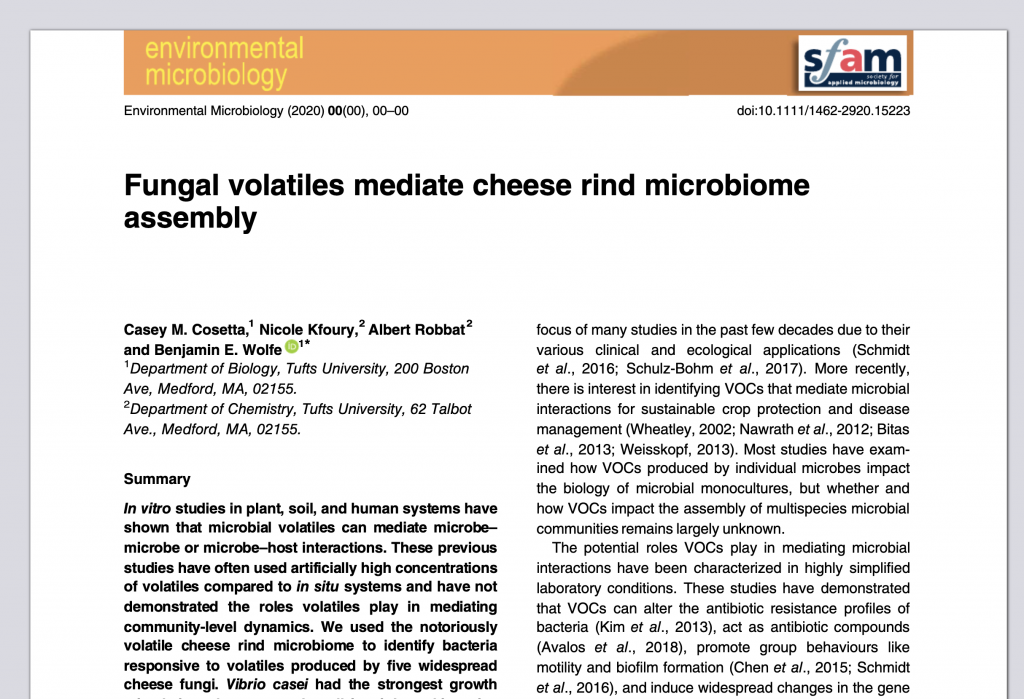
September 25th: Liz Landis just finished up harvesting a big kombucha experiment. Lots of tea and biofilms!
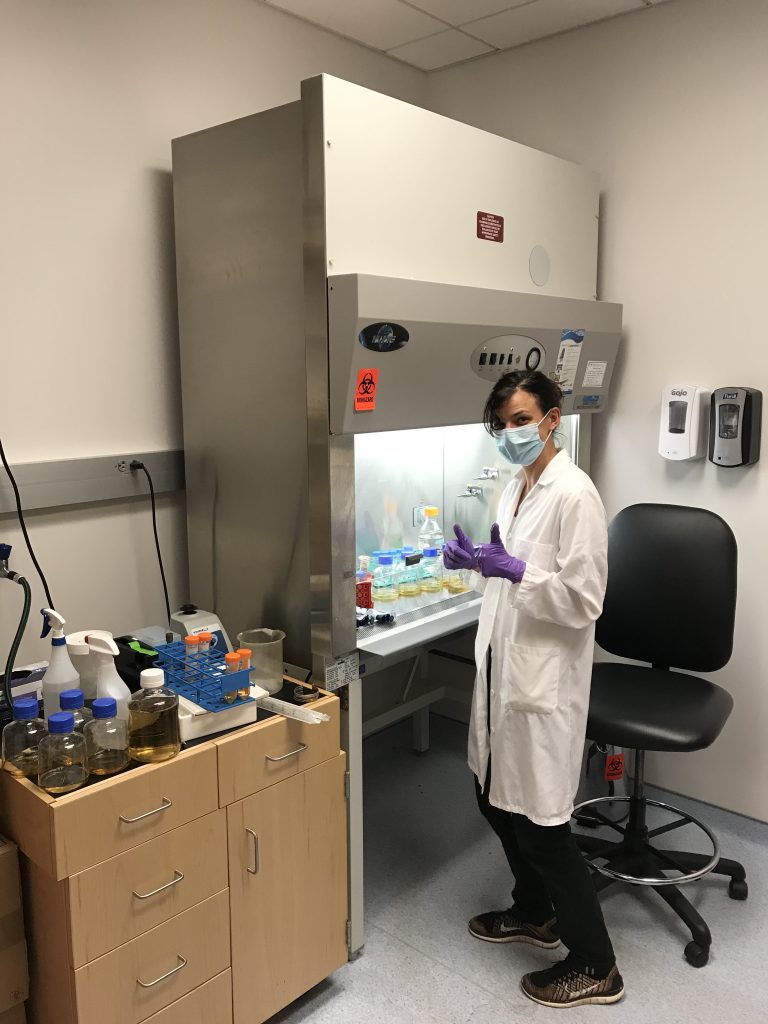
August 2020:
August 7th: We think mold is beautiful! Here are three colonies of a Penicillium mold isolated from a cheese cave. The yellow pigment is secreted from the mold into the cheese curd agar medium. The white wiggly areas are sectors that have developed as the mold grew out from a central point. We are using this and many other Penicillium species to understand how fungi respond to competition from neighboring microbes.
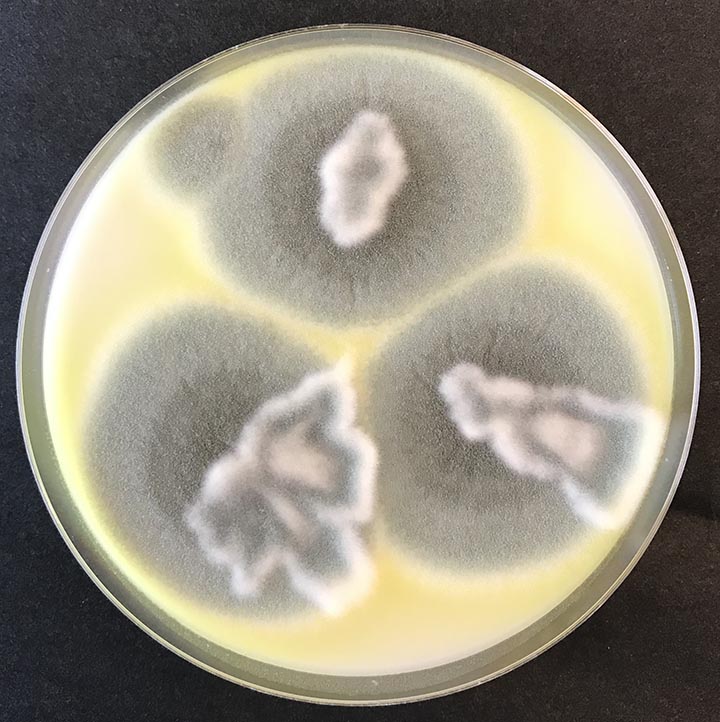
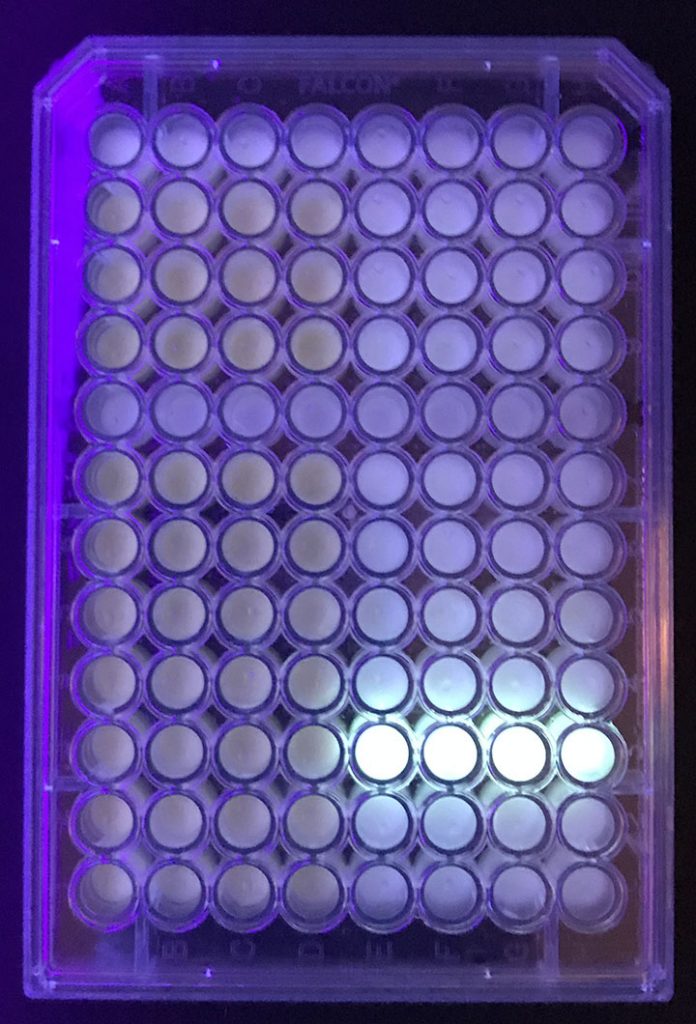
August 5th: Did you know that some cheese bacteria can glow in the dark? Here is a 96-well plate containing different cheese rind microbes. When we place the plate under a blacklight, some of the microbes glow because they produce compounds that fluoresce. Emily Putnam is a post-doc in the lab trying to understand how these bacteria interact with other microbes in cheese rinds.
May 2020:
May 11: Ben chatted with King Arthur’s Martin Philip on Instagram Live about the microbial communities in sourdough starters. You can watch the conversation here: https://www.instagram.com/tv/CAESGwYHtNi
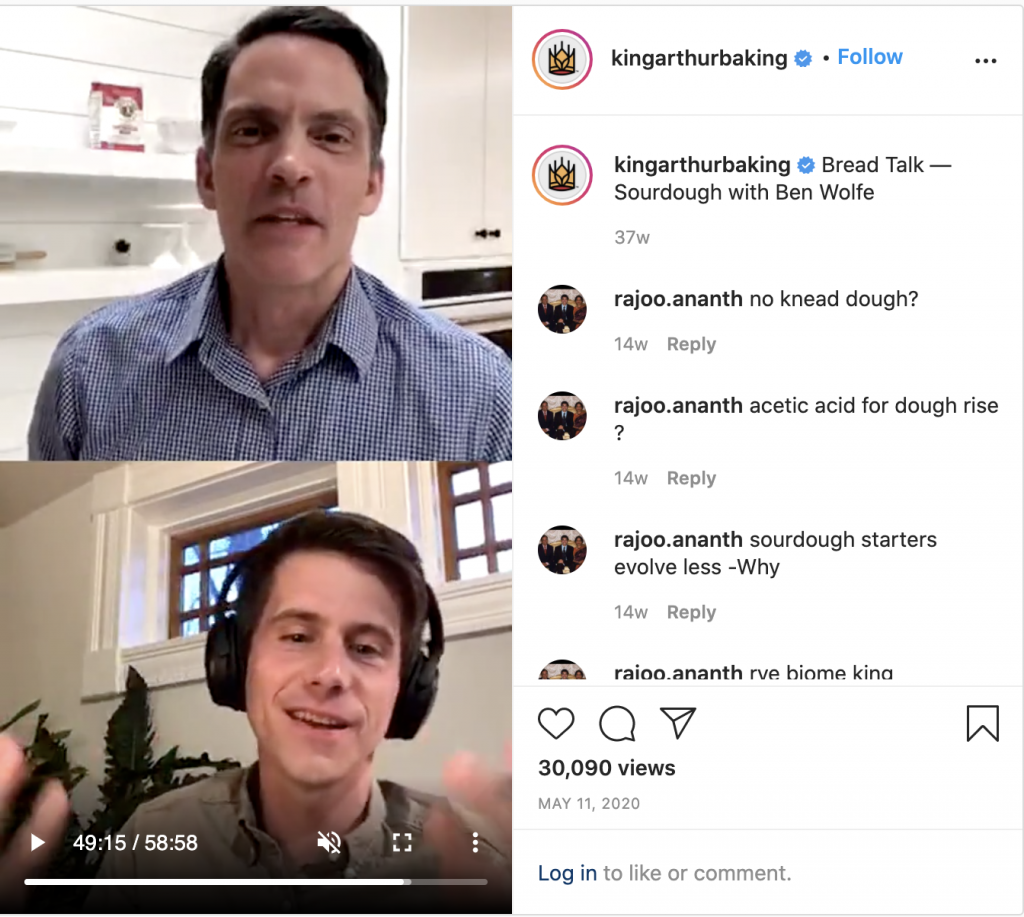
April 2020:
April 14 & 15: Congrats to Esther Miller and Casey Cosetta on successful PhD defenses! We are so proud of everything you have accomplished during your time in the lab. We are excited to see what you do next!
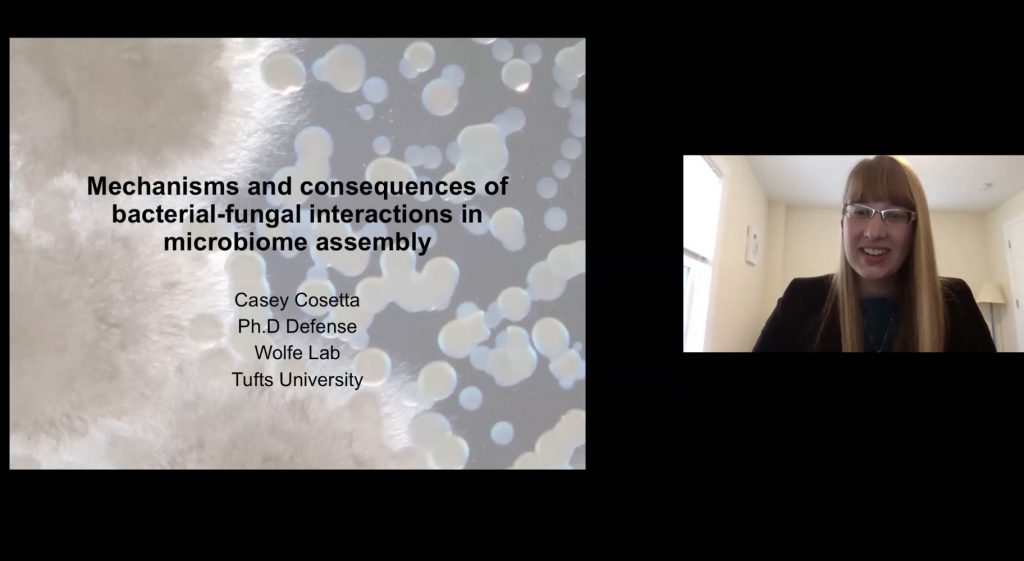
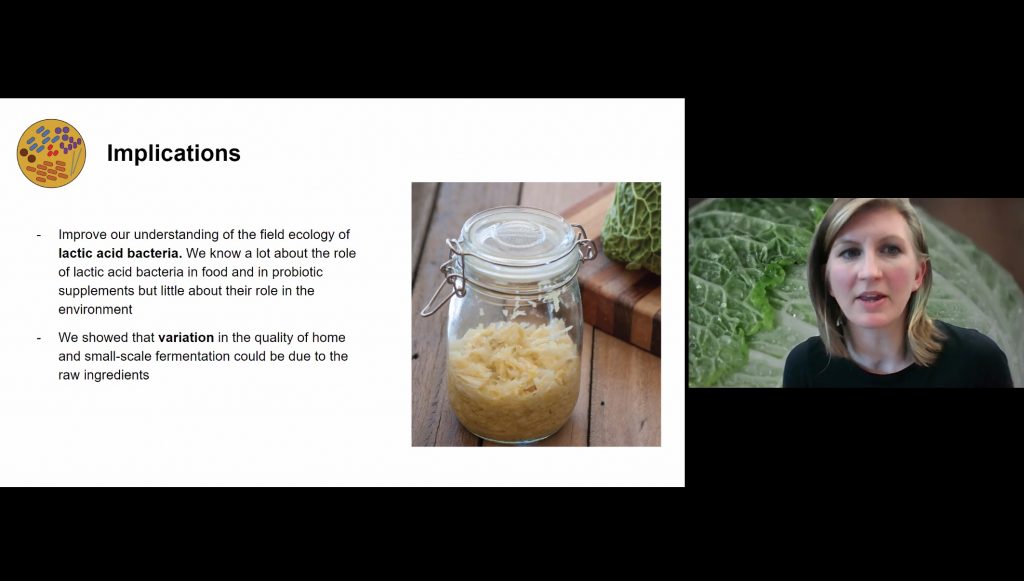
March 2020:
March 17th: Viruses are on everyone’s mind as the coronavirus pandemic intensifies. While we tend to think of viruses that harm humans, viruses can impact all sorts of hosts. Bacteria have viruses that attack them and can cause their cells to die. These bacteria viruses are called bacteriophages. One obvious sign of bacteriophage in a culture is the formation of plaques. These plaques are small ‘holes’ in the culture where the phages have attacked the microbial cells present in the culture and caused them to lyse open and die. Below is a plate of a Staphylococcus species (most likely Staphylococcus xylosus) that we isolated from a salami. The small holes that you can see in the culture represent phage plaques.
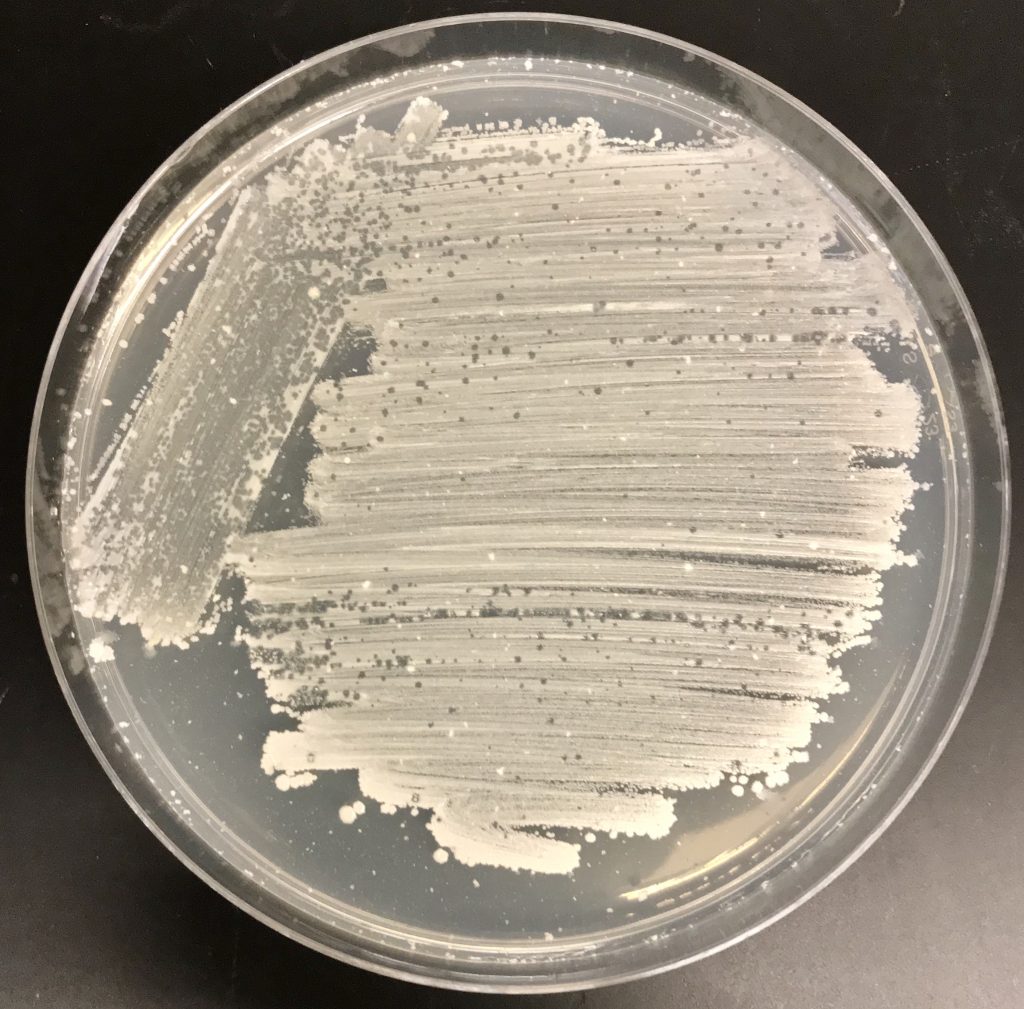
March 1st: Casey and Ben published a paper in Current Protocols in Microbiology that describes in detail how to do experiments with the cheese rind model microbiome. Cheese made it on the cover of the journal! For a PDF reprint of the paper, please email Benjamin Wolfe (see People).
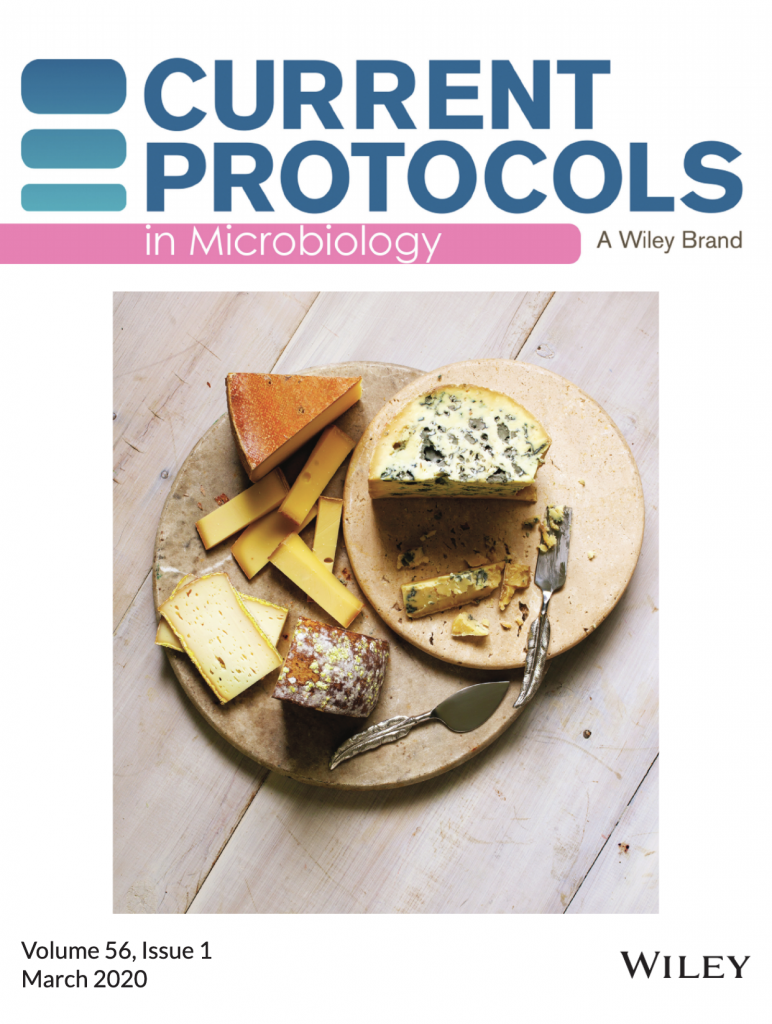
February 2020:
February 24th: Cheese rind microbes are colorful! Check out this array of cheese microbes that Ruby Ye set up in the lab. The orange and yellow strains are various Brevibacterium, Brachybacterium, and Staphylococcus species that are commonly isolated from cheese rinds.
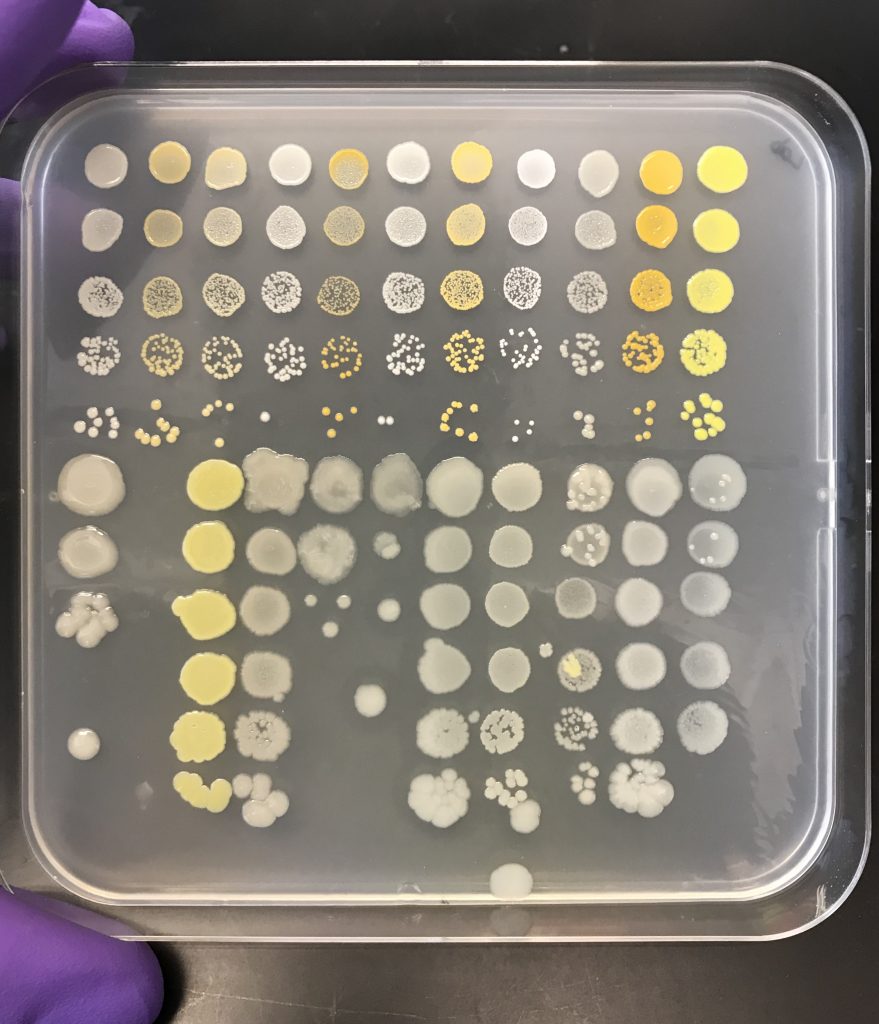
February 14th: Here are some of our mini cheese rind communities growing in 1.5 mL centrifuge tubes. You can see the thin later of the ‘rind’ growing on the cheese curd agar. also note the different pigments being produced across the various treatments. In this experiment, we are examining how fungi can drive the assembly of cheese rind bacterial communities.
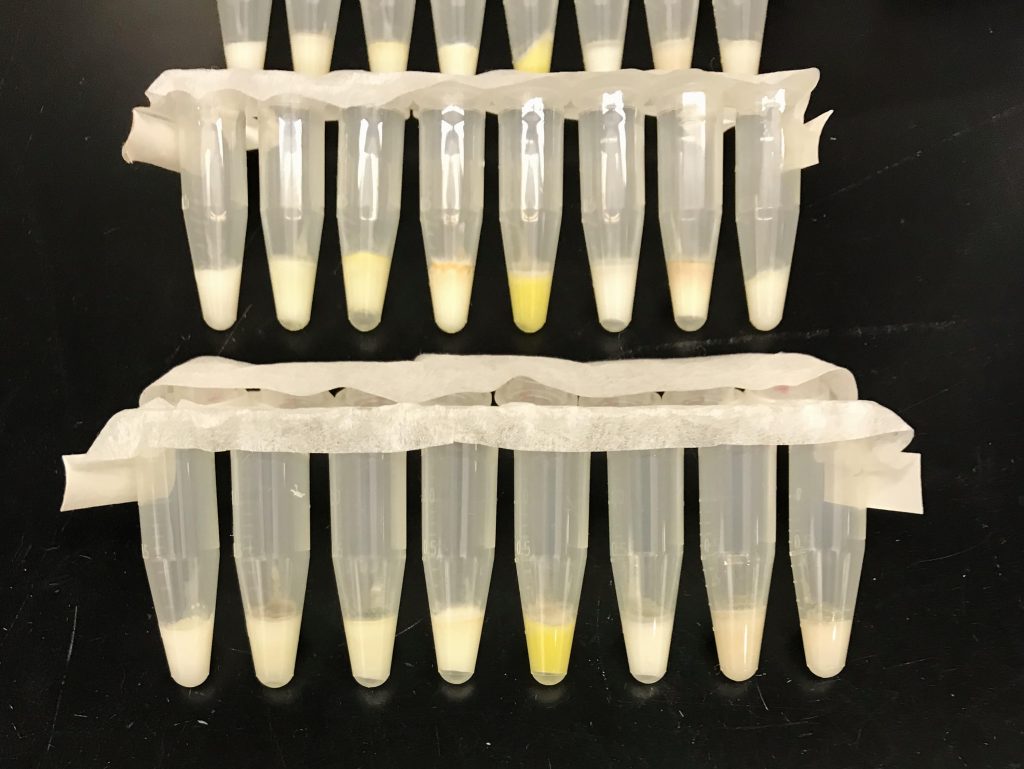
December 2019:
The fantastic folks at Gastropod visited the lab to discuss the microbiology of kimchi. Below Esther explains to Cynthia Graber how kimchi microbes are analyzed. Check out Gastropod’s fantastic kimchi episode here.
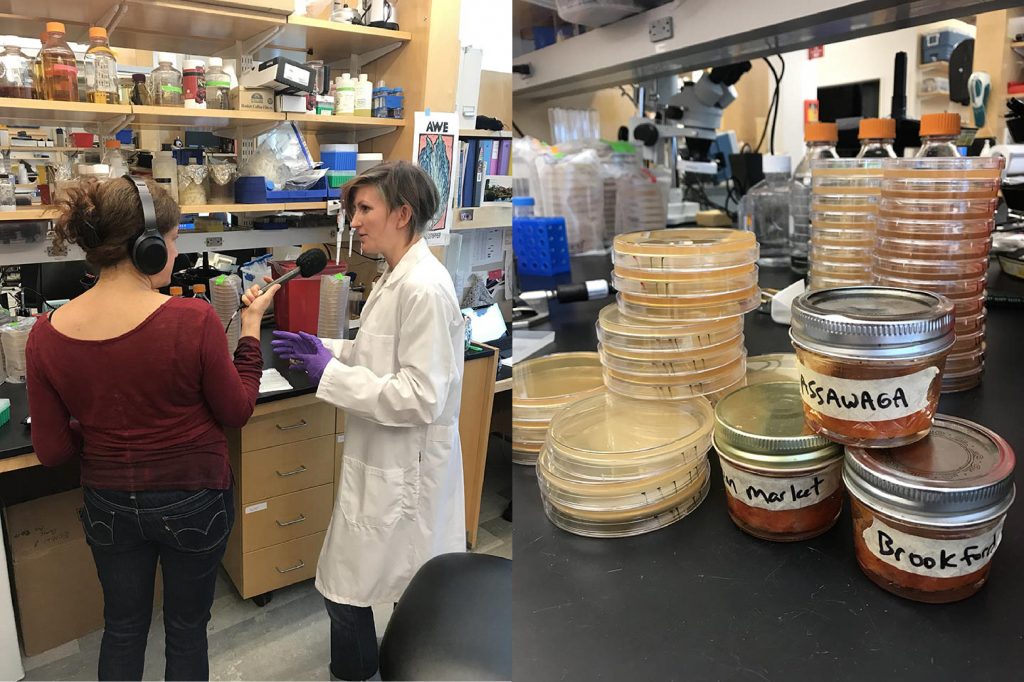
October 2019:
October 15th: Our mBio paper on Penicillium domestication on cheese was highlighted by the New York Times and on PRI’s The World.
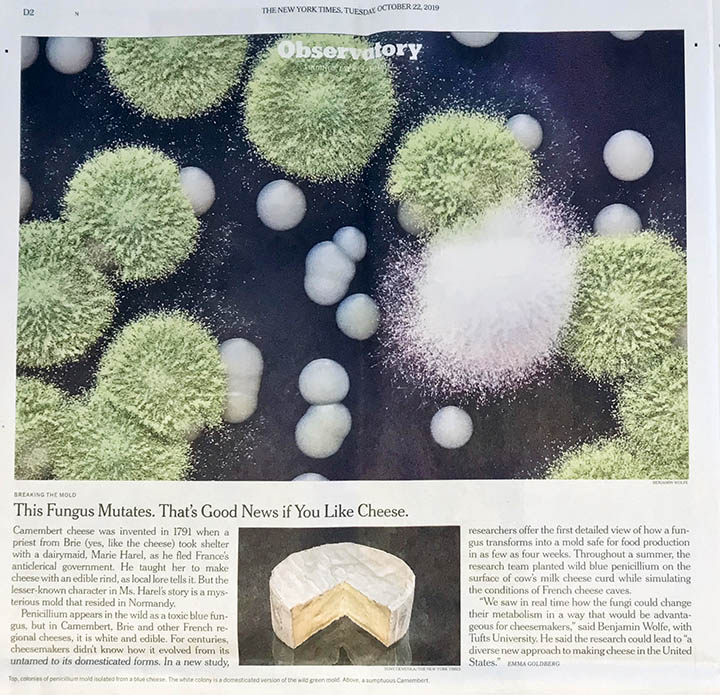
October 31st: Students in Bio 55 (Microbiome Research Lab) have identified a fungus from cheese rinds that can strongly inhibit bacterial growth. Shown below is a panel of fungi (small fuzzy plugs) that were placed on a lawn of a bacterium. Compounds produced by the fungi diffuse into the agar layer below and can inhibit the growth of bacteria. The large zone of inhibition on the bottom left of the plate is caused by the grey/black fungus. We are working to identify the fungus and the potential compound(s) that are causing the antibacterial activity.
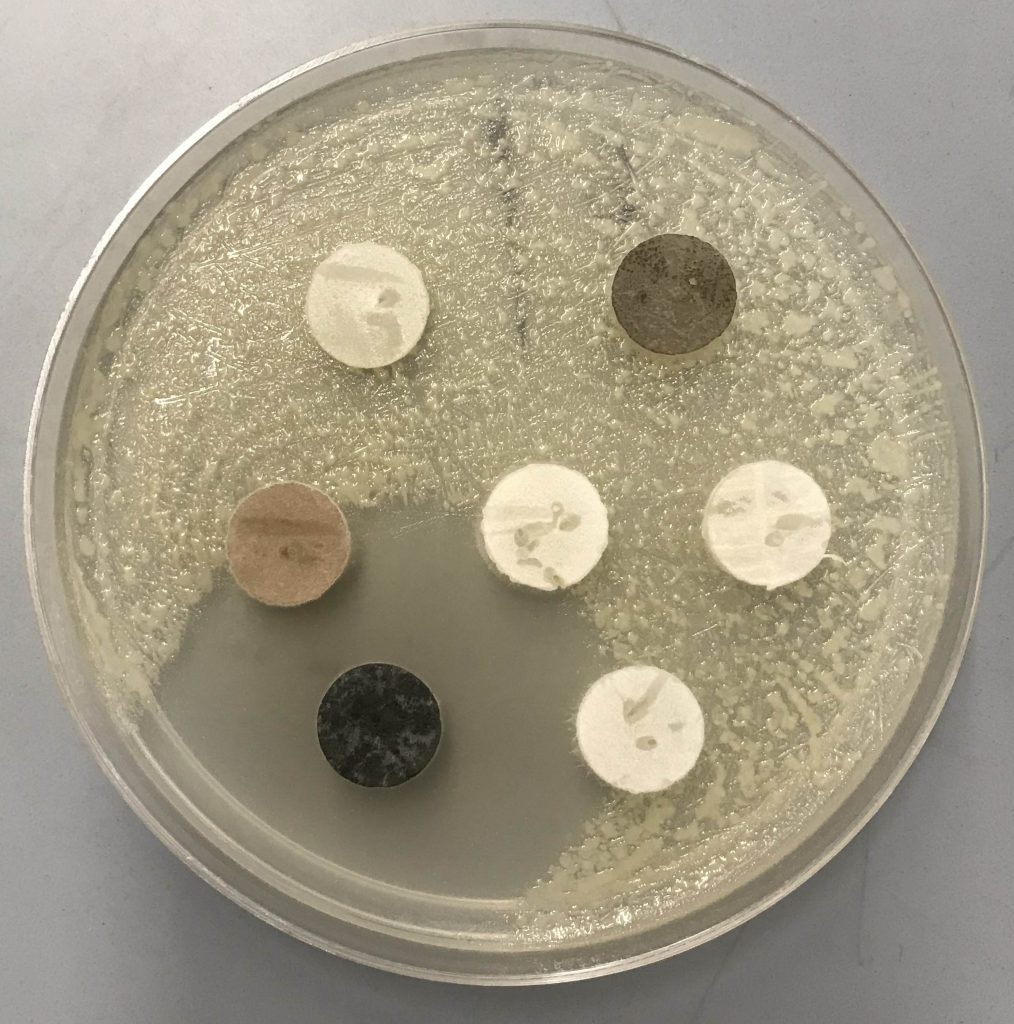
September 2019:
September 30th: The bacterium Pseudomonas fluorescens is beautiful when grown in the lab. Colonies of the bacterium glow when placed near a blacklight due to the production of the compound pyoverdine. This bacterium can be a problem for cheesemakers. When this bacterium colonizes a cheese rind, it can make the cheese taste bitter or can kill desirable fungi that are essential for rind formation. Below is a photo of Pseudomonas fluorescens isolated from a cheese rind alongside colonies of Brevibacterium (orange colonies).
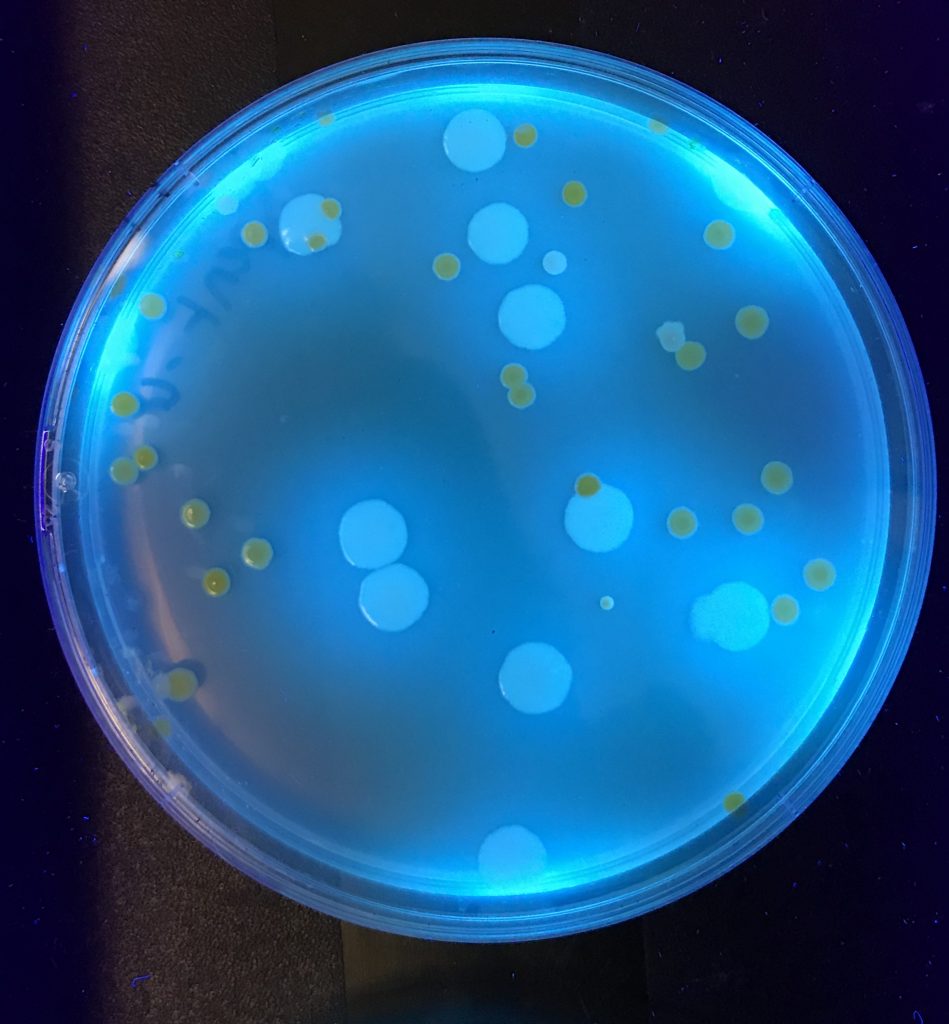
August 2019:
Our review on dissecting microbial interactions within microbiomes has been published in Current Opinion in Microbiology.
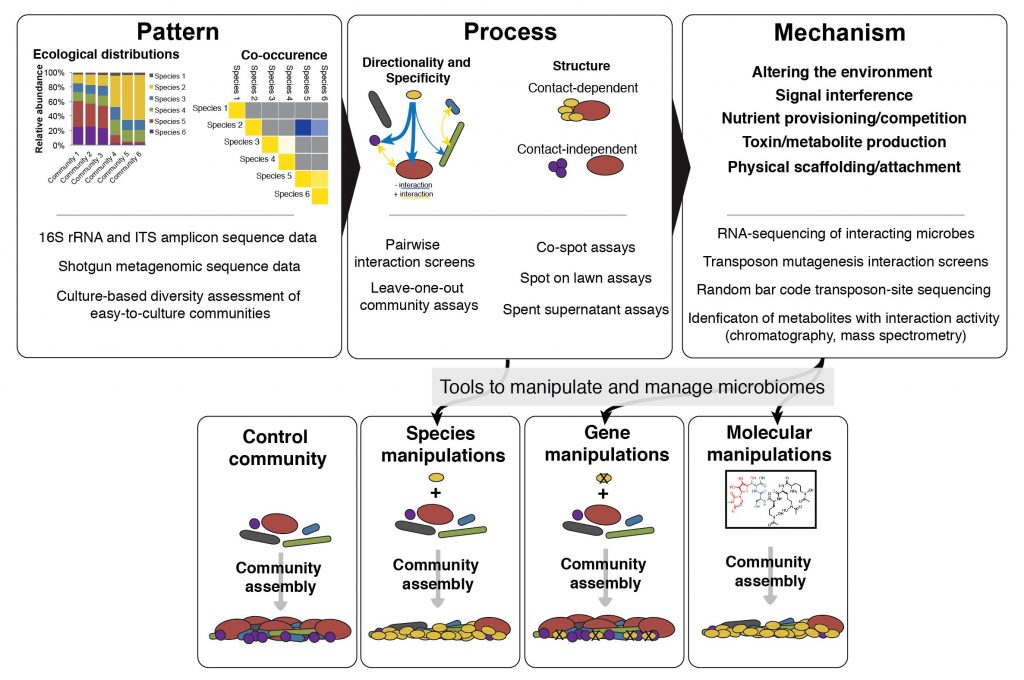
July 2019:
We are excited to welcome Ruby Ye to the lab. She is a Ph.D. candidate that is working on the genetics and ecology of fungal secondary metabolites in microbiomes.
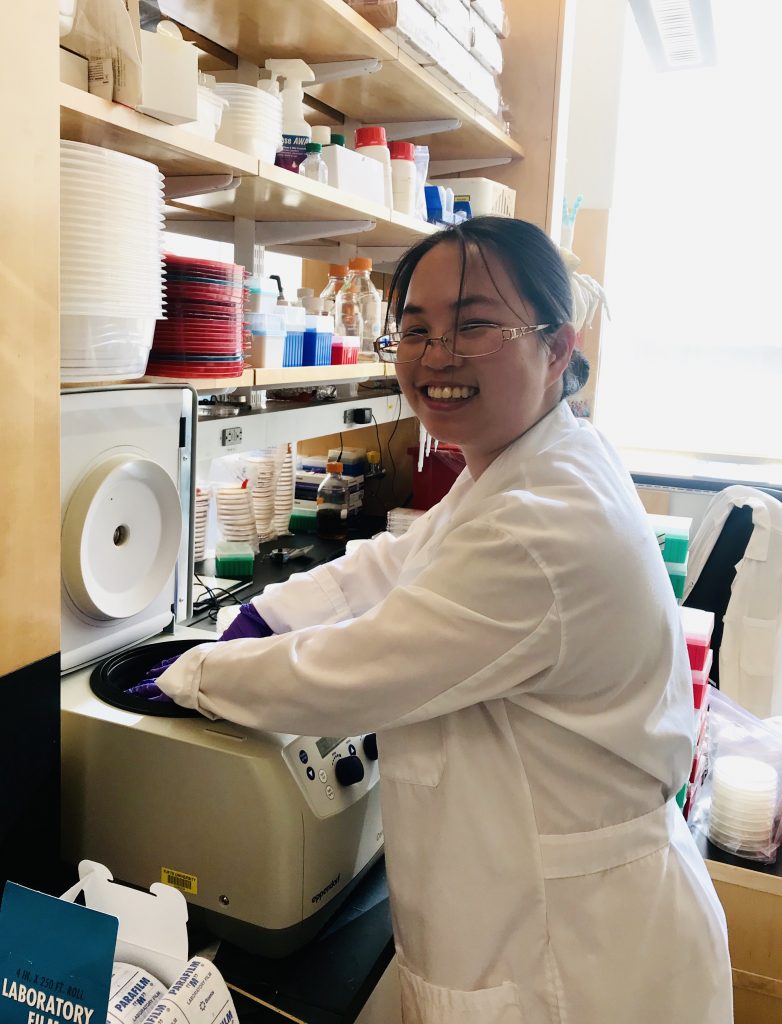
May 2019:
May 22nd: We are excited to welcome Grace Cox to the lab. Grace is a microbiology major at UMass Amherst.
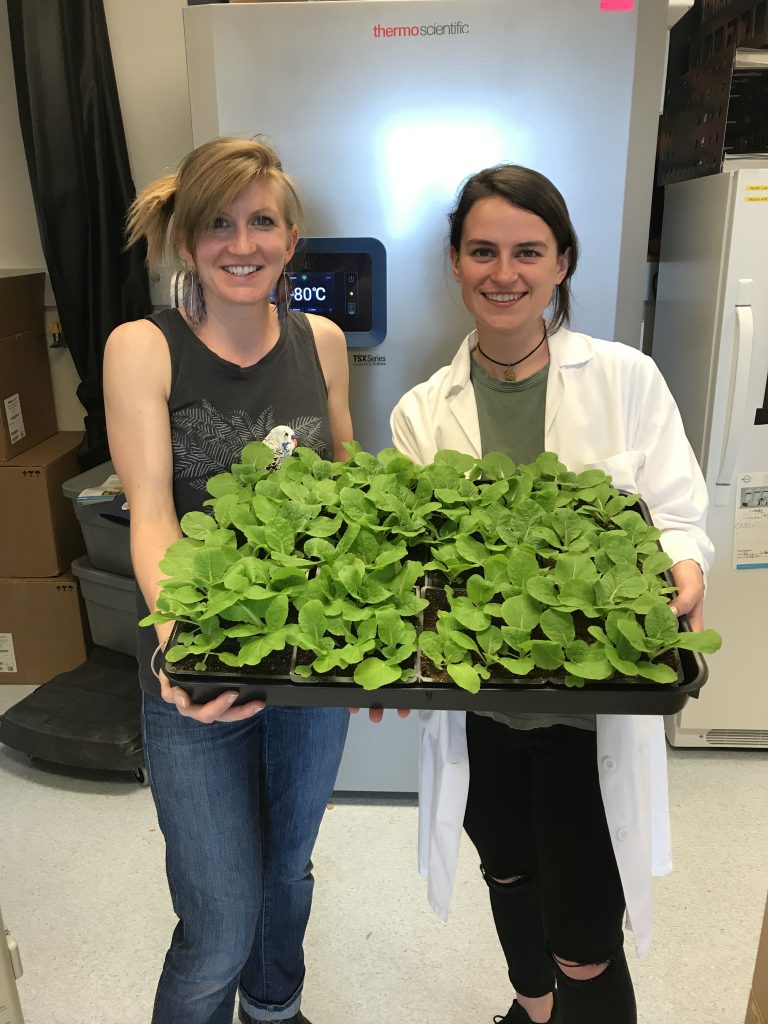
February 2019:
February 15th: Casey gave an excellent seminar for the department on the role of volatile organic compounds in cheese rind microbiomes.
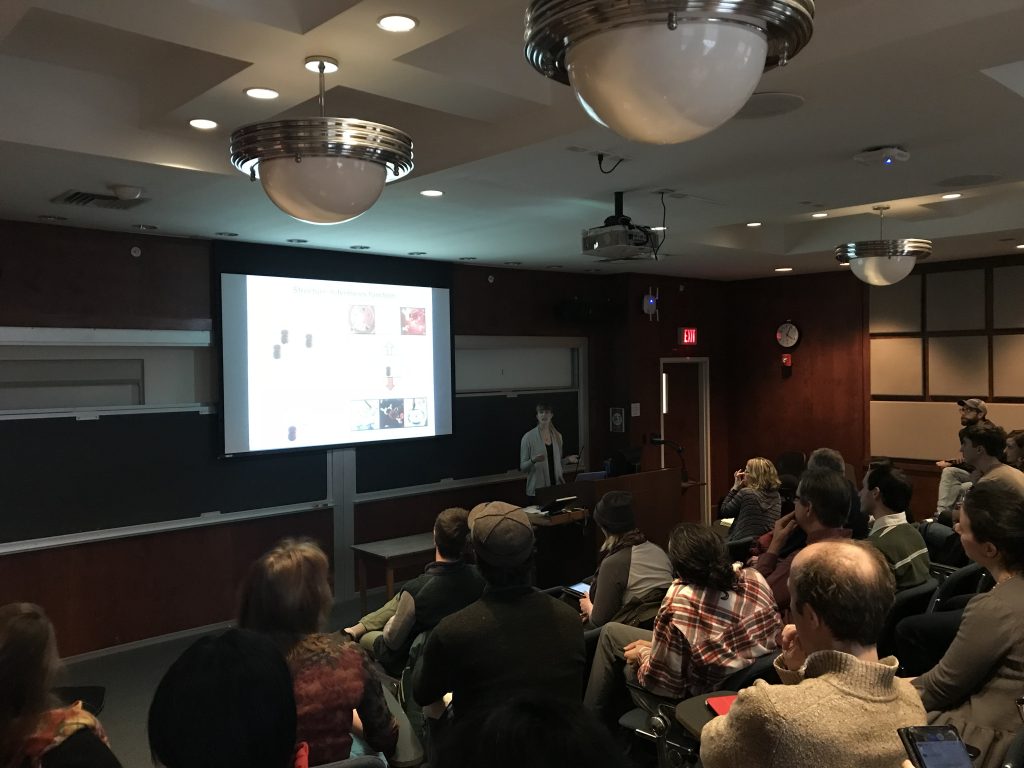
January 2019:
January 9th: We’ve purchased some of our favorite sauerkrauts and kimchis for students in the introductory microbiology course to study this semester. They will be isolating bacteria and yeast from these products to learn about the microbial diversity in fermented vegetables.
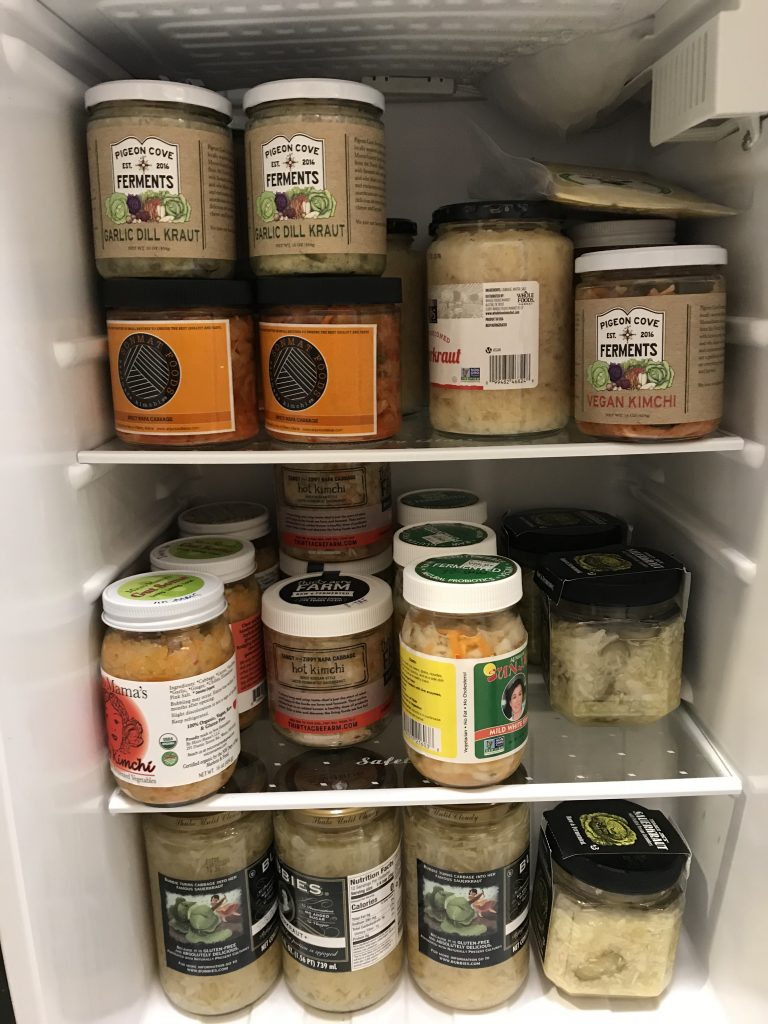
October 2018:
October 26th: Esther and Pat are using these adorably small Mason jars to make lab-scale ferments of cabbage. This project is trying to link the microbial composition of the cabbage phyllosphere with the outcomes of fermentation. Soon we will have hundreds of mini-sauerkrauts fermenting in the lab!

October 16th: It was such an honor to have a virtual chat with author and journalist Maryn McKenna in Ben’s Microbiology of Food course. Students were able to hear about Maryn’s experience writing Big Chicken. This book explores the role of the chicken industry in causing the emergence of antibiotic resistance in animal agriculture.
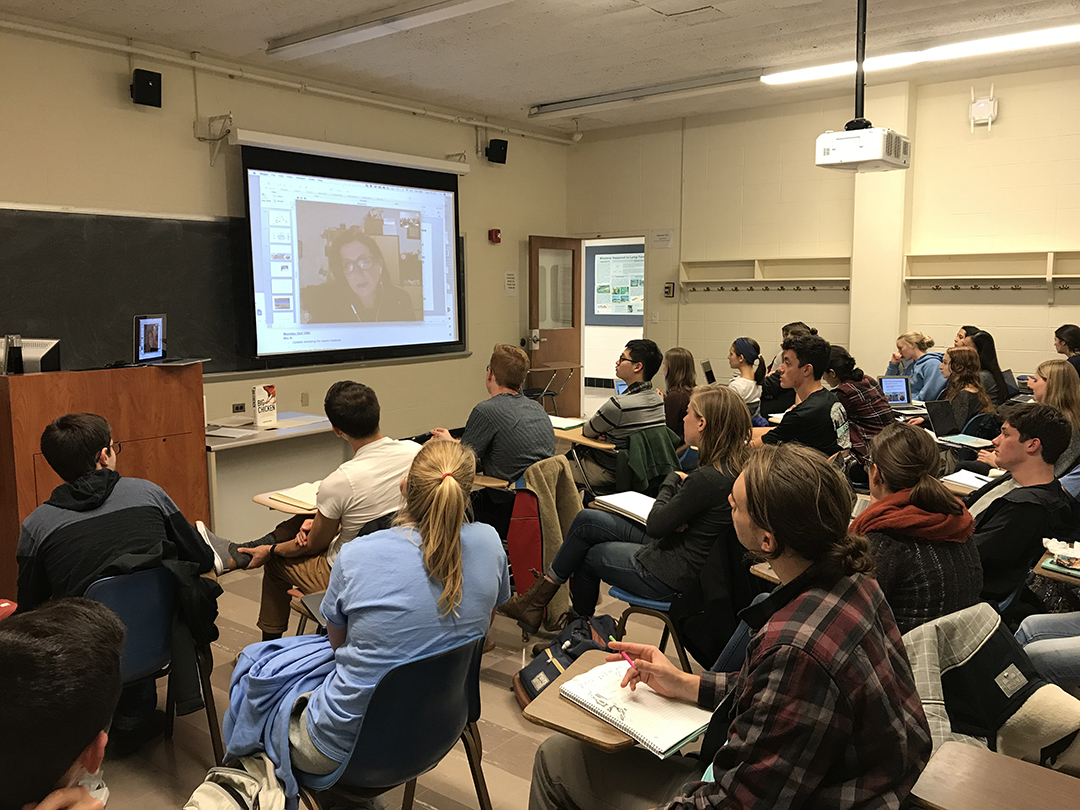
September 2018:
September 24th: Post-doc Pat Kearns is working on a large microbial interaction screen for our USDA-funded cabbage phyllosphere project. He is hoping to identify microbes that can strongly impact the growth other microbes in the cabbage phyllosphere. So many plates!!!

September 23rd: The lab enjoyed a day of apple picking in Groton, MA.
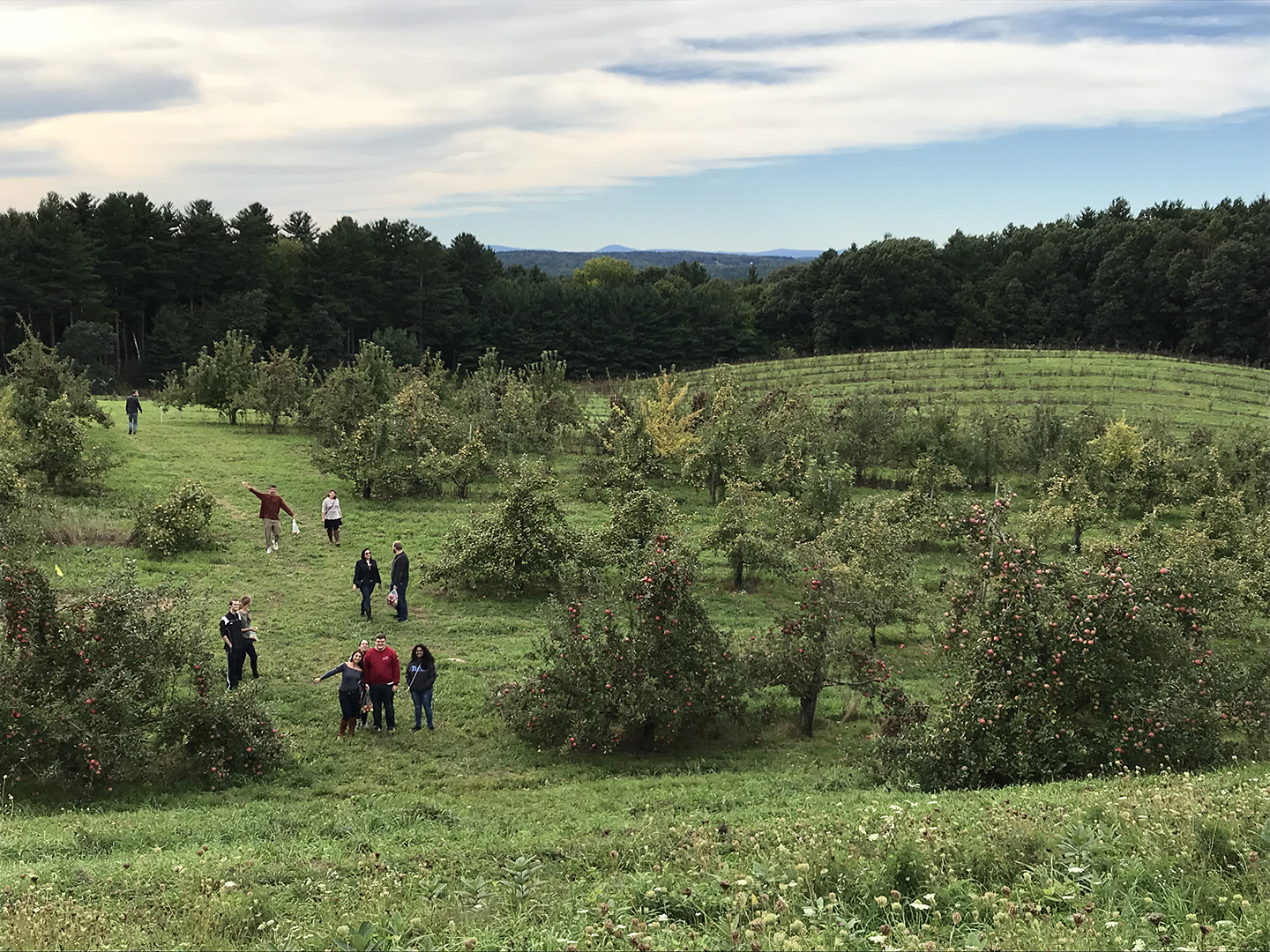
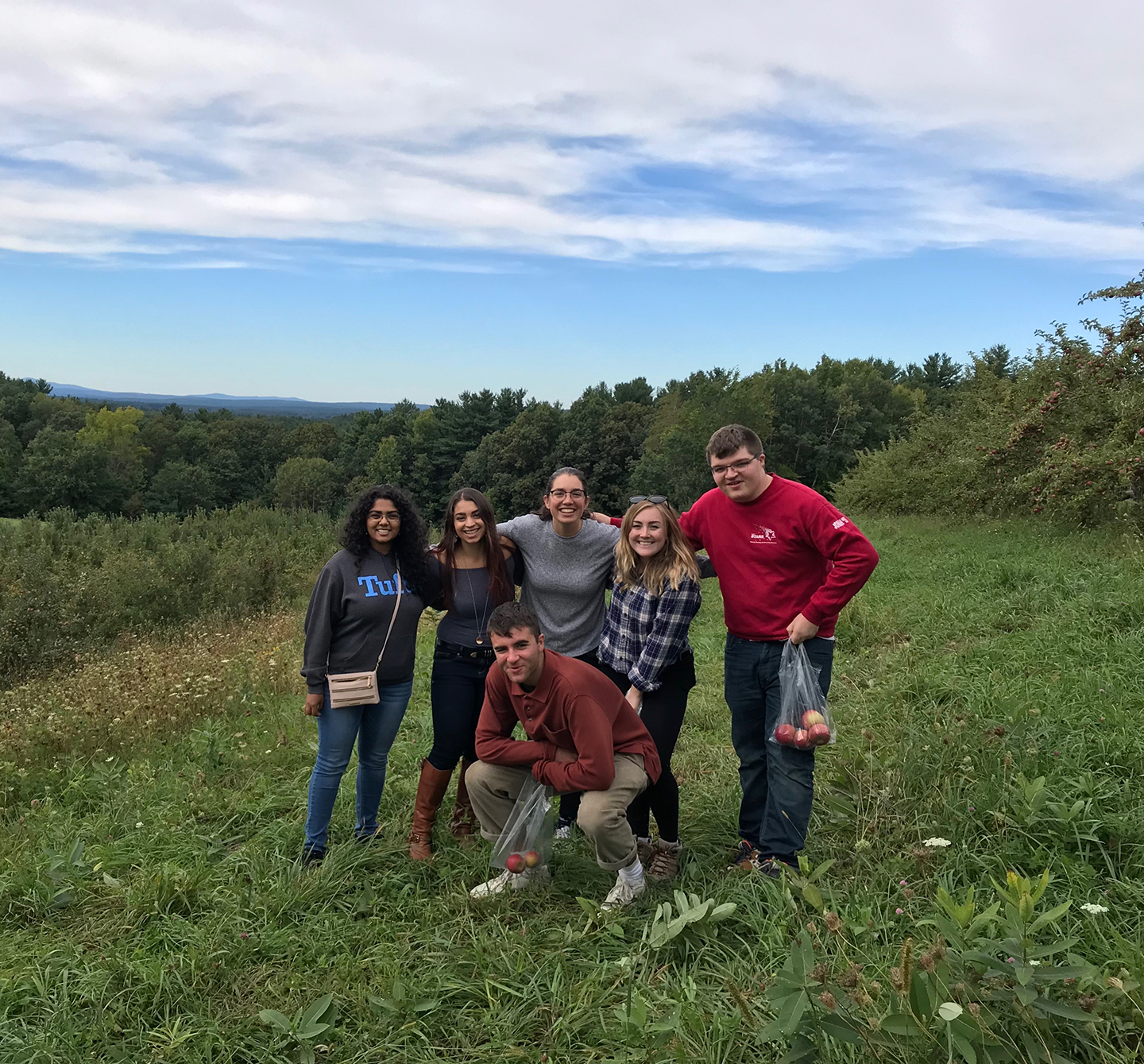

September 16th: Liz, Megan, and Ben were at the Berkshire Fermentation Festival with our USDA-funded Microbiome Discovery Center. There were so many excellent questions raised by the hundreds of visitors to our booth!
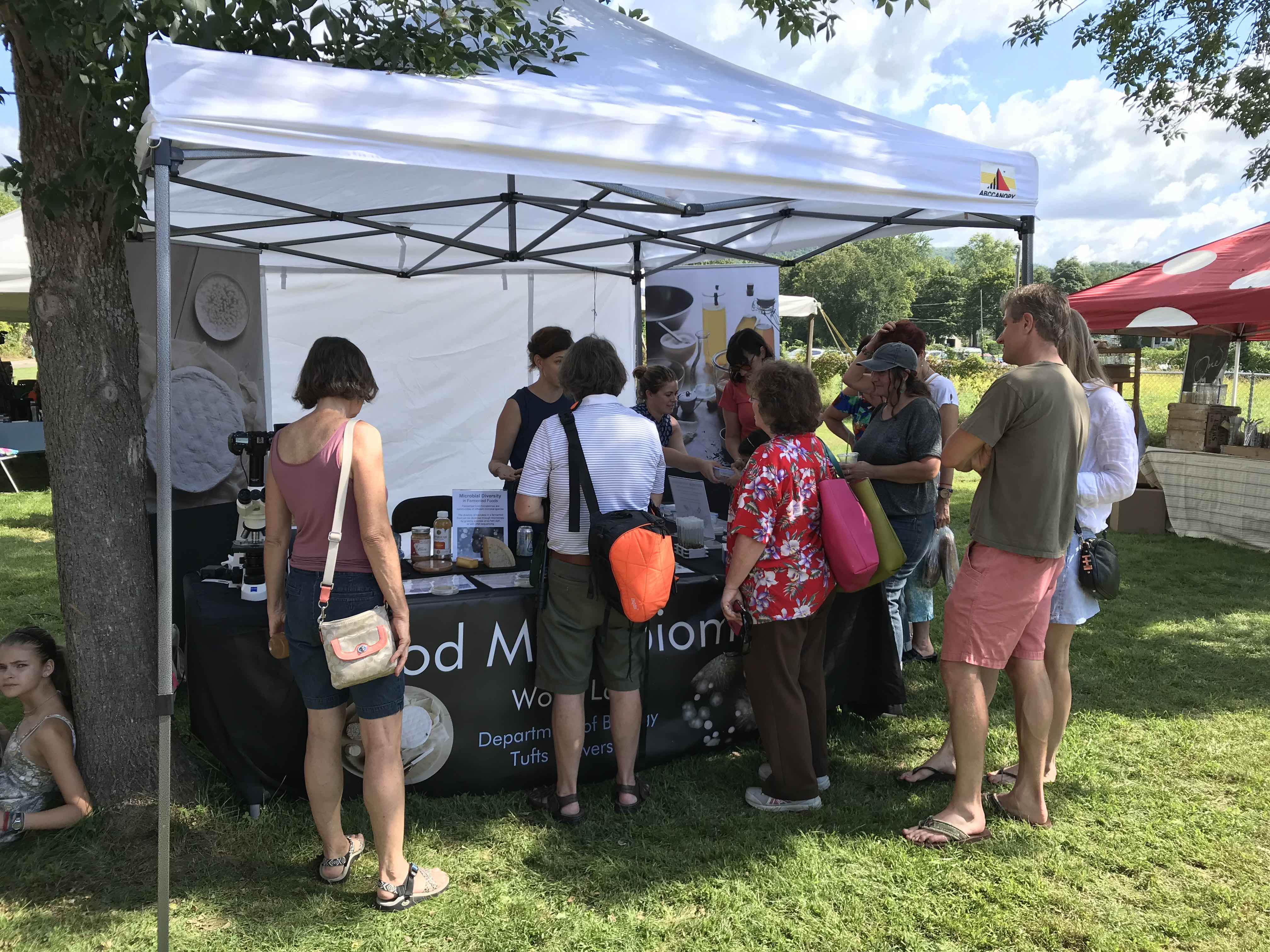
September 16th: Our work with microbes that live in cheese rinds is highlighted in the September issue of National Geographic! You can check out the article in the online version here.
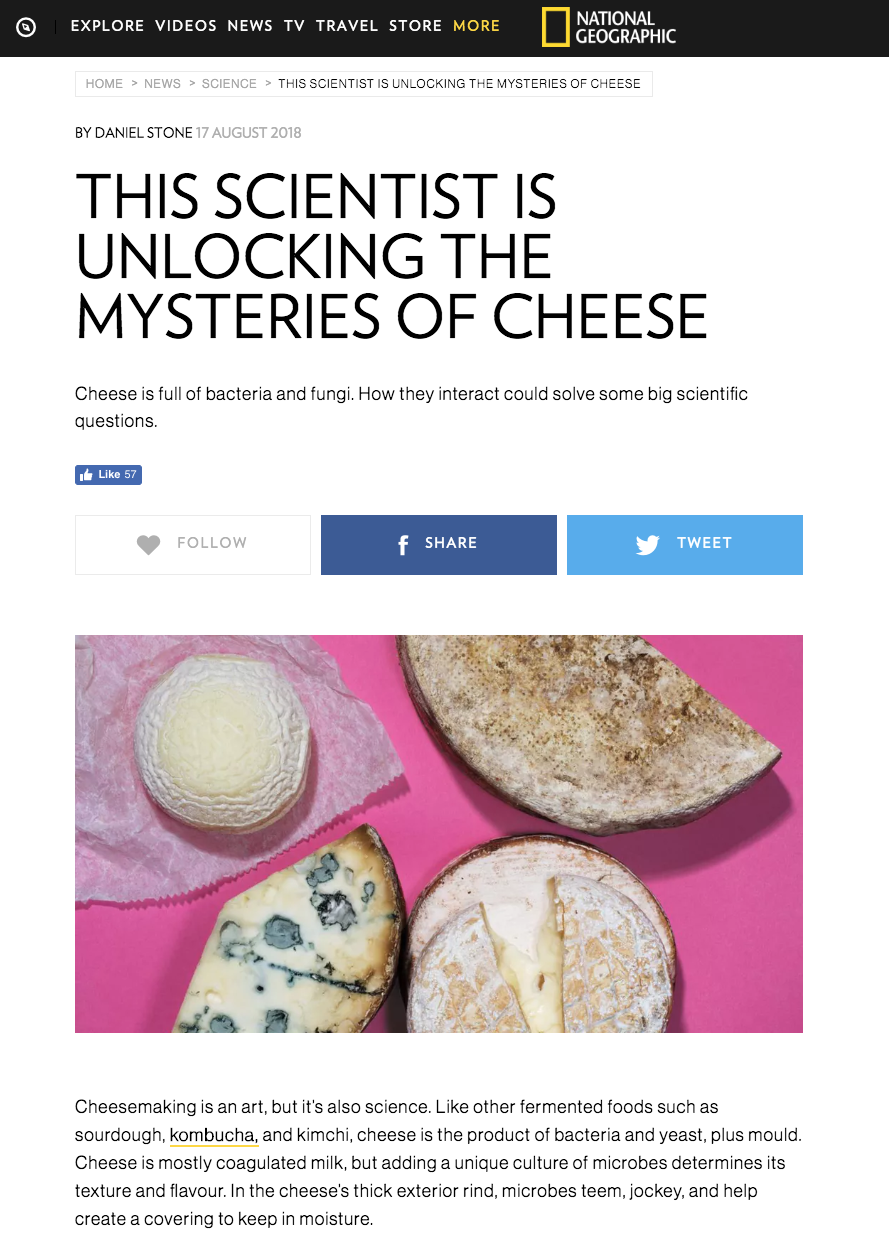
August 2018:
August 28th: We just published a collaborative paper with Laura Sanchez’s lab at University of Illinois-Chicago in mSystems. The goal of this research was to understand why the cheese rind bacterium Glutamicibacter arilaitensis secretes a red pigment (see below) when grown with molds. We discovered that the pigment is the metal-binding compound coproporphyrin III which may be used by the bacterium to compete for zinc with the fungi.
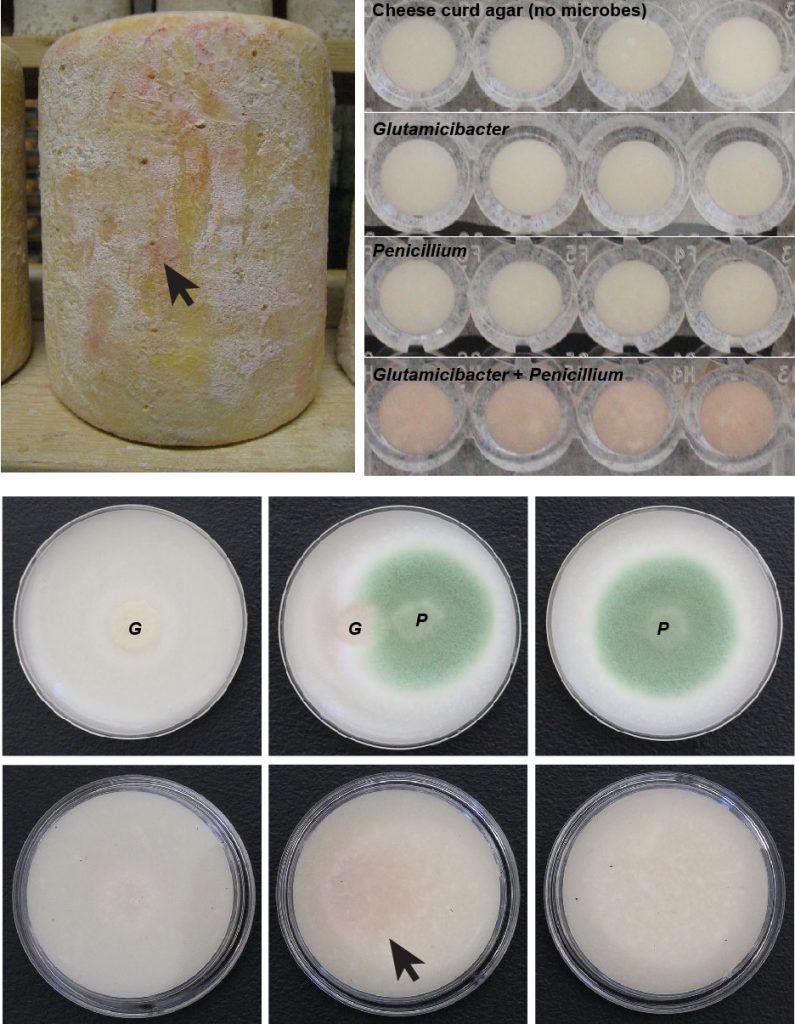
August 26th: Pat, Esther, Liz, Megan, and Ben all enjoyed chatting about the wonders of fermented food microbes at the Boston Fermentation Festival.
August 26th: Pat, Esther, Liz, Megan, and Ben all enjoyed chatting about the wonders of fermented food microbes at the Boston Fermentation Festival.
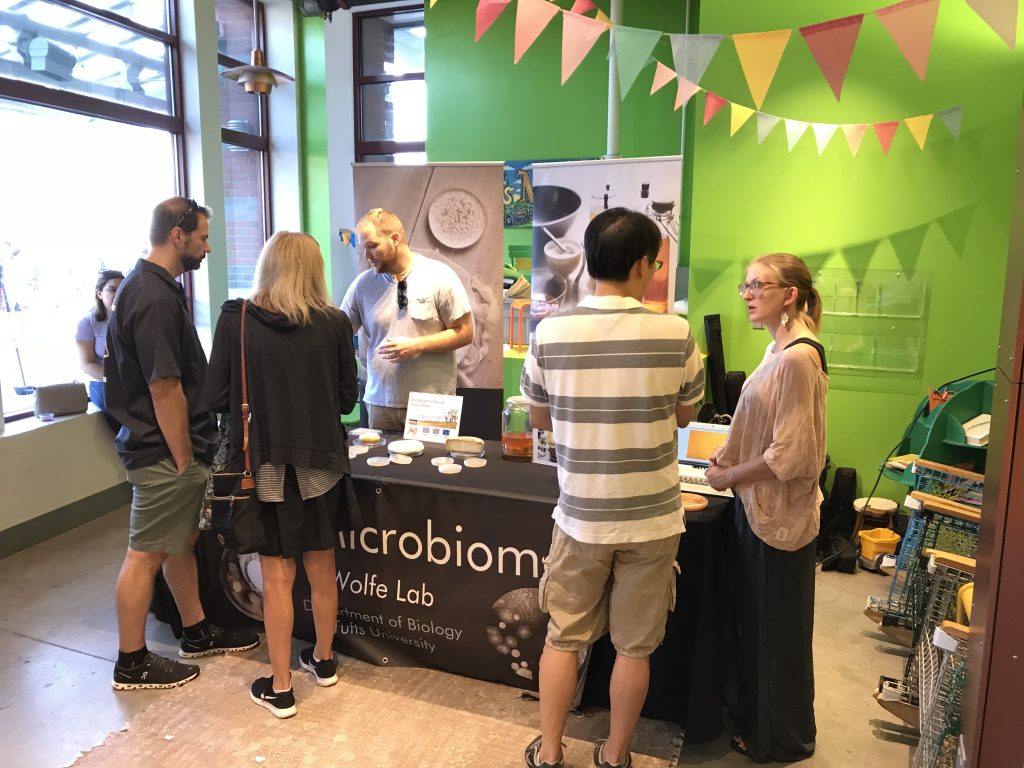
August 18th: A few years ago, we got an email from a cheese producer telling us that their cheese was turning purple. This was a very striking cheese rind pigment defect that had never been described before. We just published a paper in Food Microbiology describing the microbial cause of purple rind defect. Ben wrote about how we solved the curious case of the purple cheese rinds over at MicrobialFoods.org. It involves urine bags, indigo, and fishy-smelling bacteria.
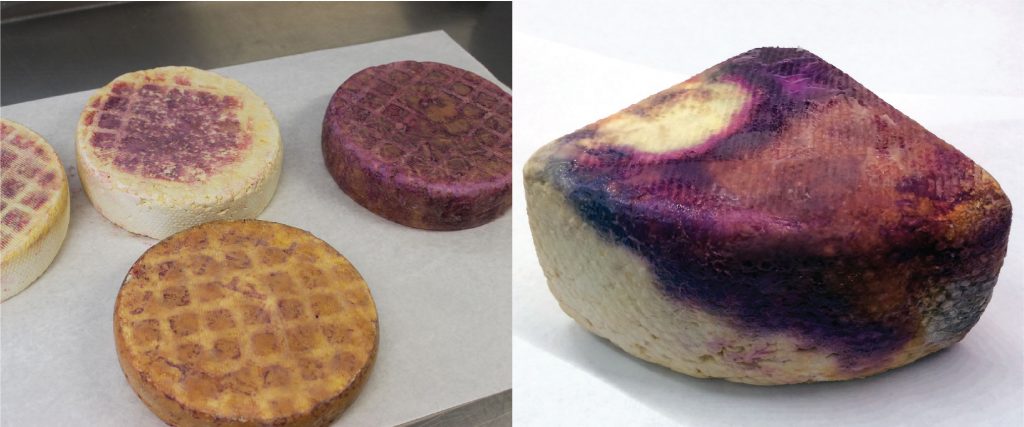
July 2018:
July 30th: Jake (below) has been working this summer on measuring inhibition of cheese rind bacteria by Penicillium mold metabolites. Many molds like Penicillium produce chemicals that can kill various types of microbes. The antibiotic penicillin was discovered when Alexander Fleming fortuitously noticed that a Penicillium mold was preventing the growth of the bacterium Staphylococcus on a Petri dish. In these plates, Jake has placed ‘plugs’ of fungi onto ‘lawns’ of bacteria. Any antibacterial compounds produced by the fungi diffuse out into the lawns of bacteria and inhibit their growth. In a few days, he will look for these ‘zones of inhibition.’
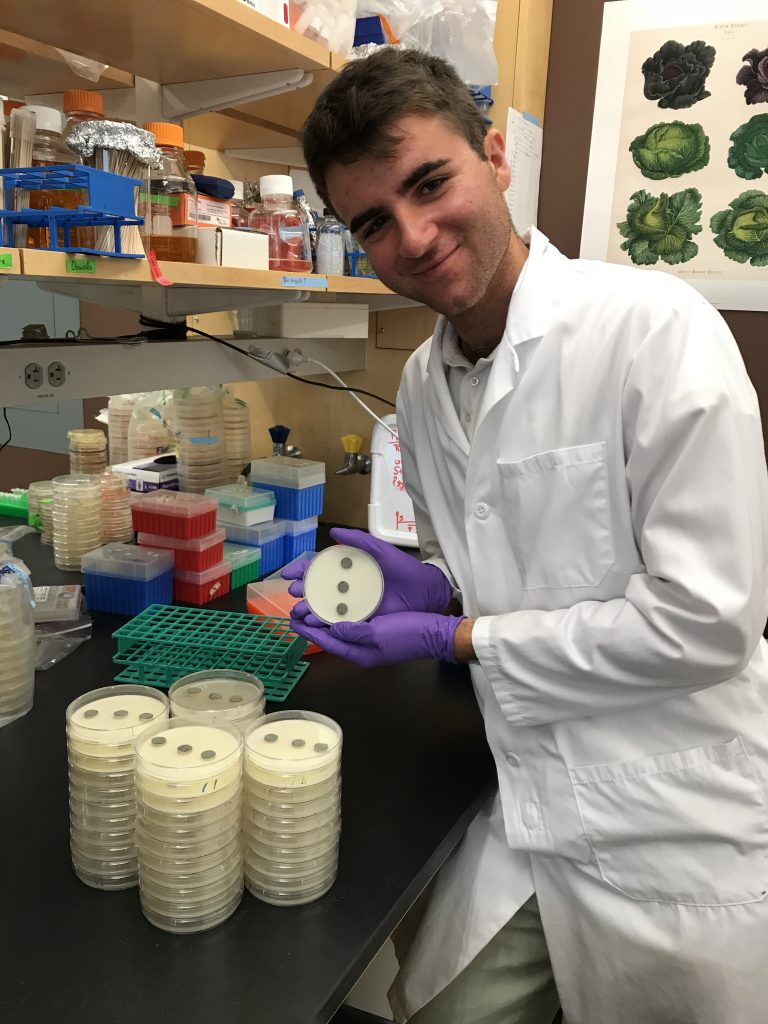
July 19th: Liz and Esther explained the wonders of fermented food microbes for the “Microchefs” event the Harvard Museum of Natural History.
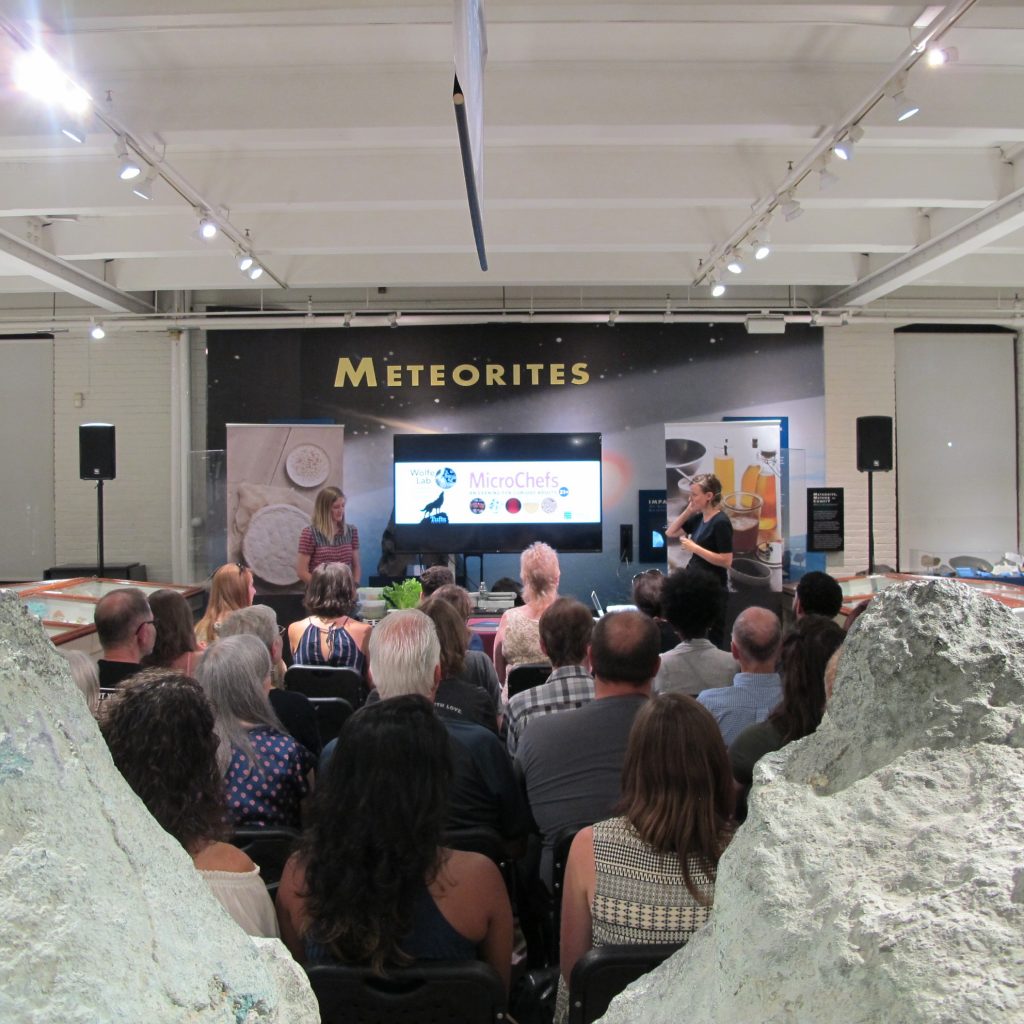
June 2018:
June 30th: Esther (left) and Mira (right) harvested Napa cabbages from our experimental garden. They are huge! We are using these cabbages to understand the ecology of lactic acid bacteria on plants. These bacteria are super important for the successful fermentation of vegetables (kimchi, sauerkraut, etc.).
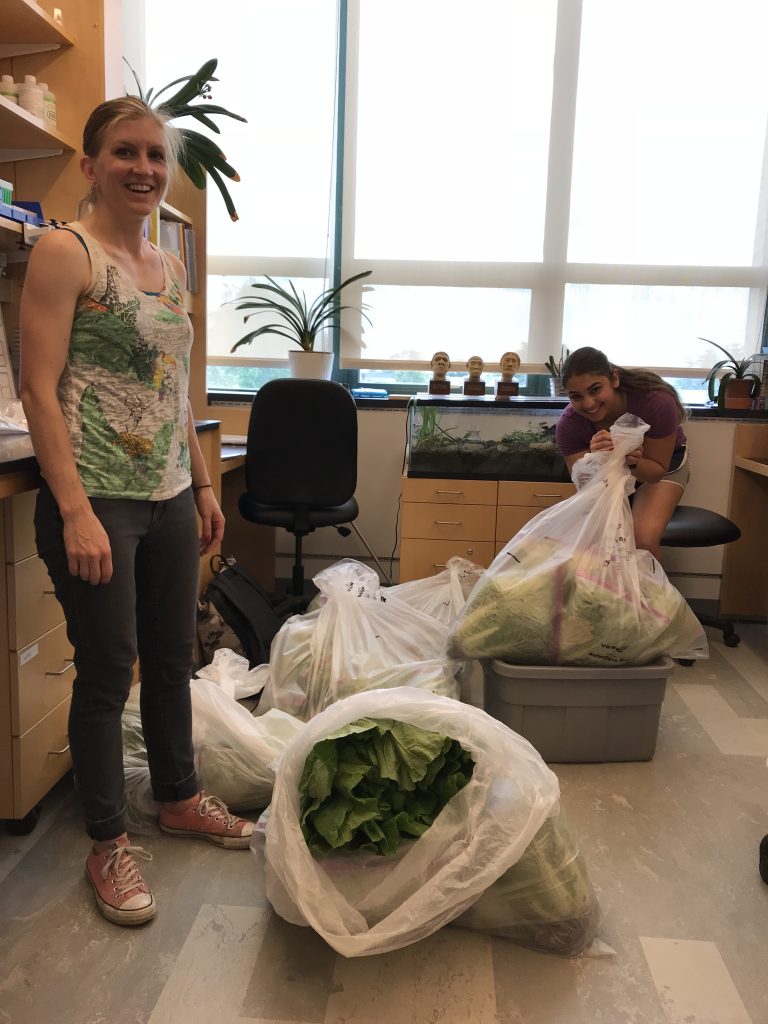
June 29th: Each week during the summer, we meet on Friday afternoons to discuss progress, problems, and plans. We also eat pie. We call it PPPPie. For her week, Esther made customized tarts from all World Cup countries. They were super detailed and incredibly delicious!
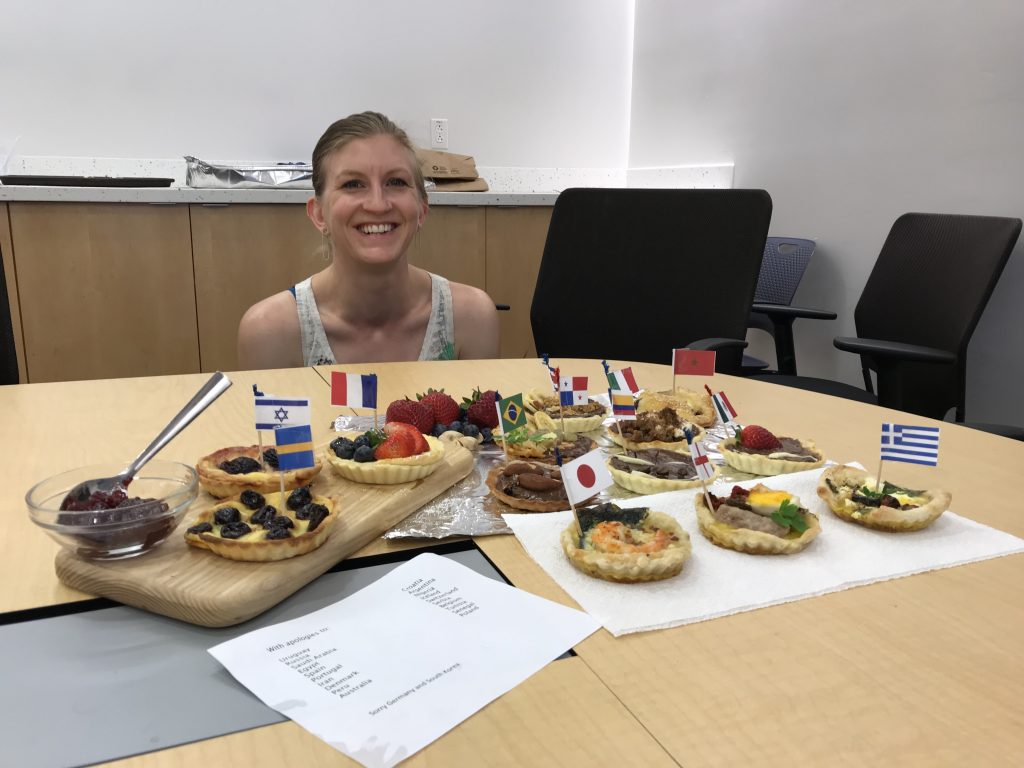
May 2018:
May 23: We kayaked down the Charles River from the Harvard Stadium to Kenall Square. It was a beautiful day! We also welcomed Patrick Kearns as a new post-doc in the lab (he’s in the green kayak). He’ll be working on microbiome assembly in the cabbage phyllosphere.
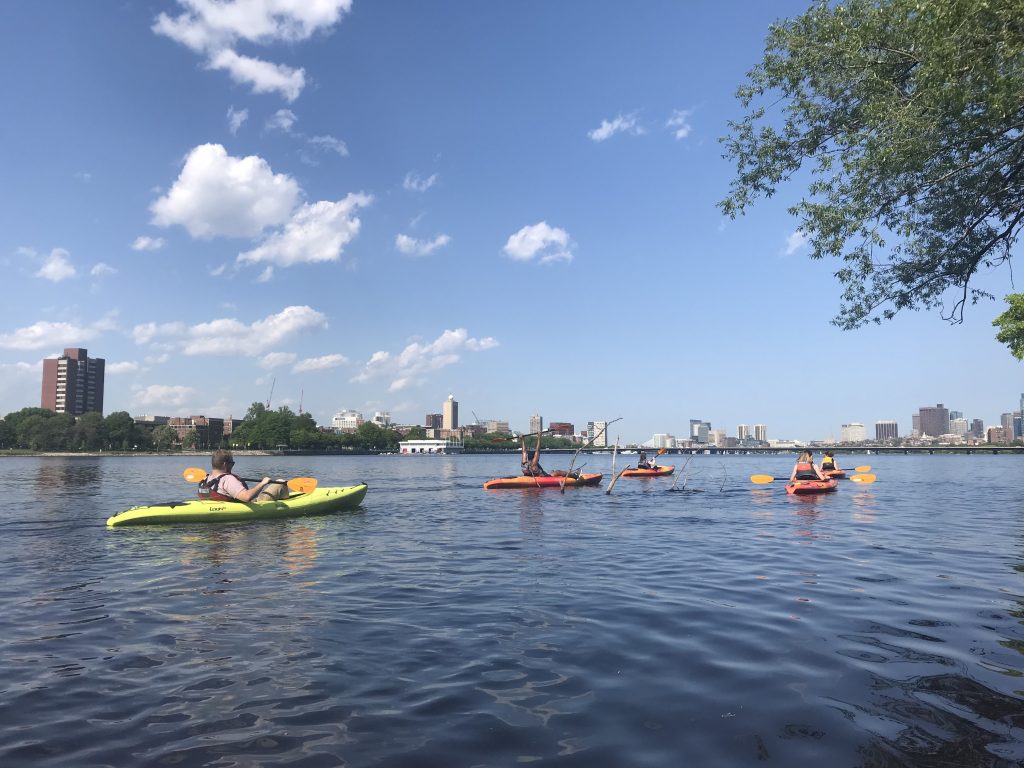
May 15: These are young Napa cabbages that are being colonized by bacteria. Lactic acid bacteria that live on the surfaces of cabbage leaves are responsible for the fermentation of sauerkraut, kimchi, and other fermented vegetables.
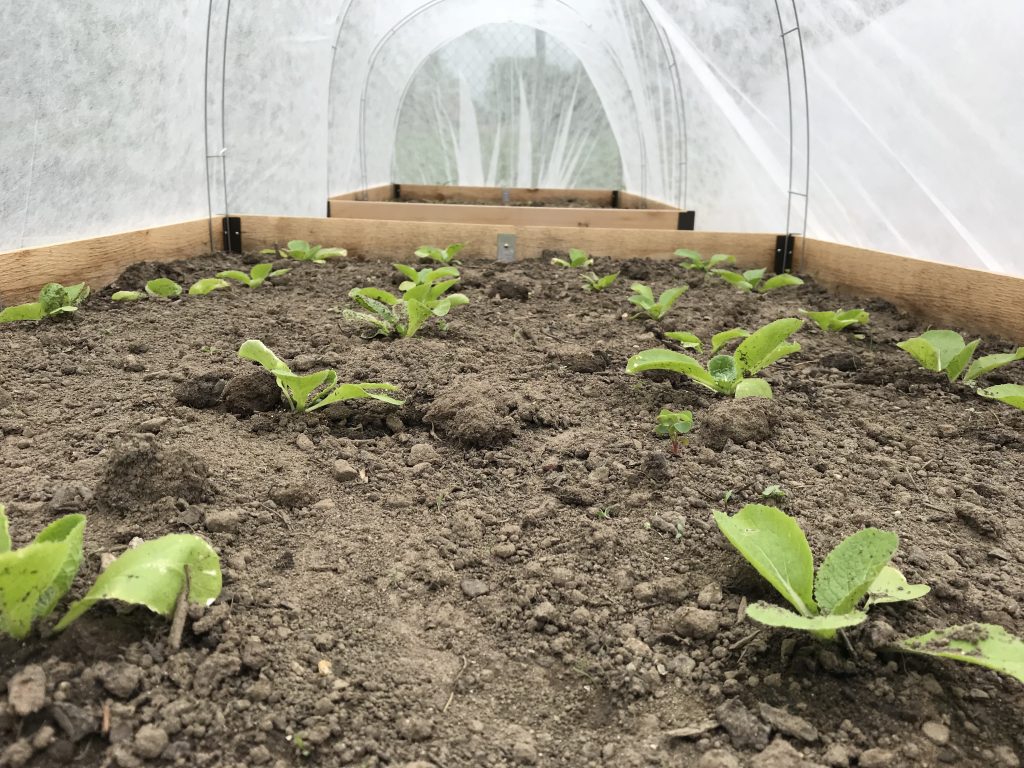
April 2018:
April 21: We spent the day building raised beds on campus for our USDA-funded cabbage microbiome project. We’ll use cabbages grown in these raised beds to confirm some of our results observed in test tubes in the lab.
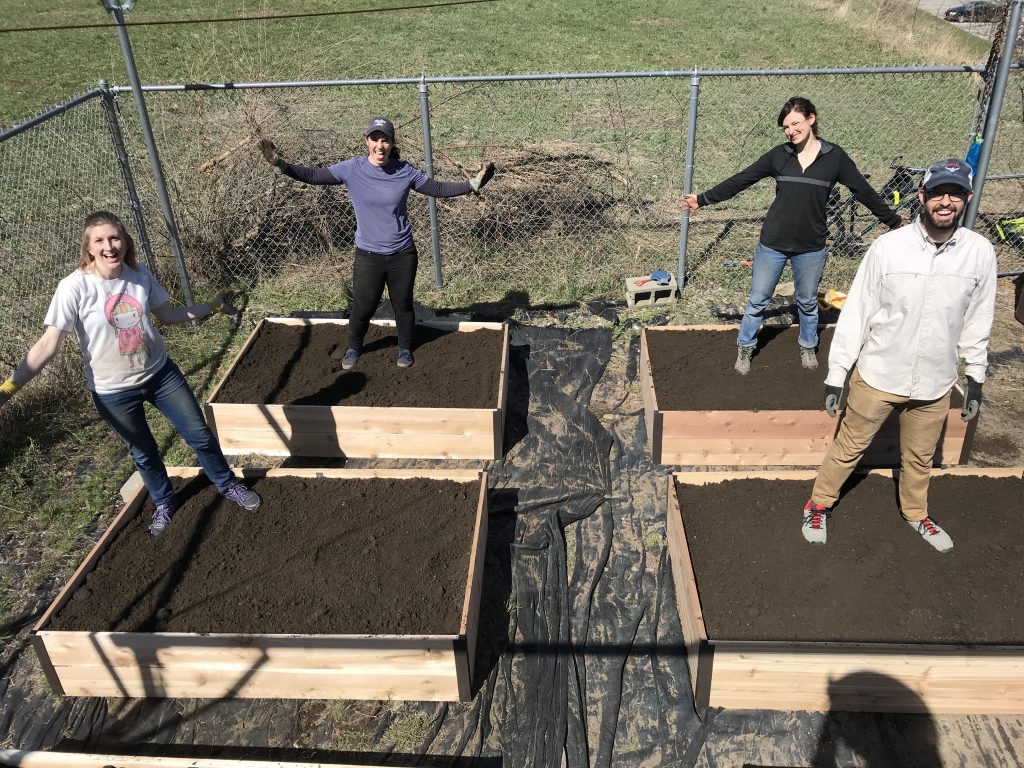
April 9: Shravya has been busy developing in vitro sourdough starters. As part of our NSF-funded project on the evolution of microbiomes, we are trying to reconstruct sourdough starters with cultures we have isolated from a large collection of starters sent to the lab. Here you can see some pilot starters that Shravya made using the bacterium Lactobacillus sanfranciscensis.
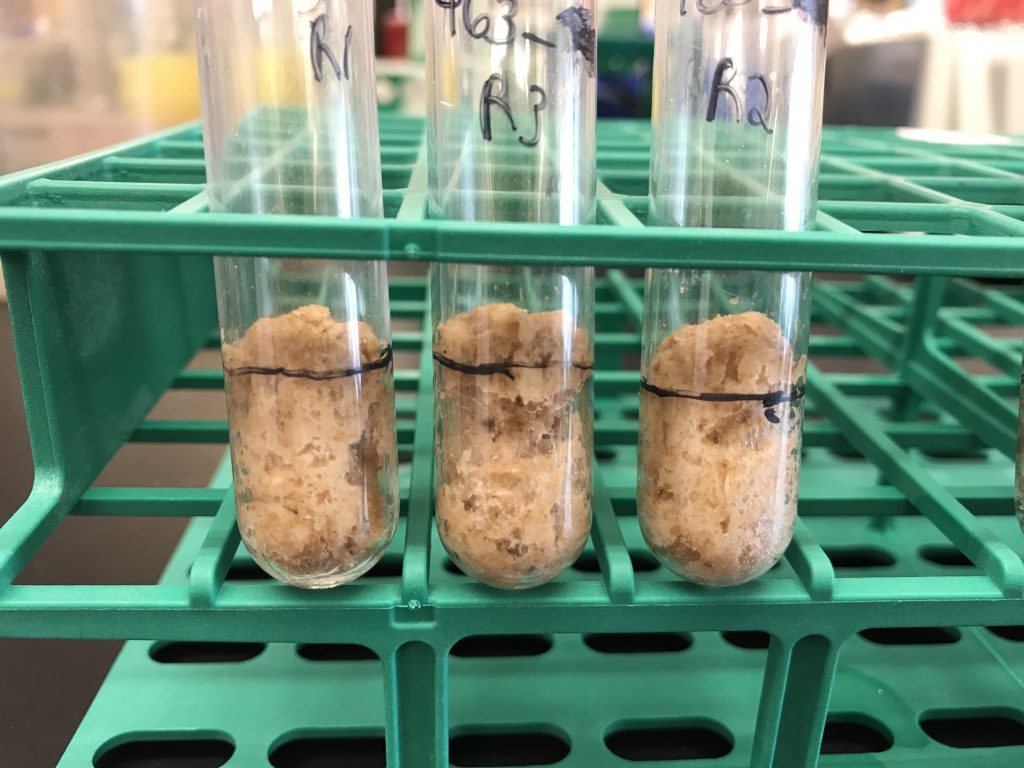
March 2018:
March 8: Ben had a lovely time tasting fermented food microbiomes with members of Pride on the Hill and Tufts Alumni & Friends. Ben also explained how our research on fermented foods is teaching us basic principles of microbiome assembly.
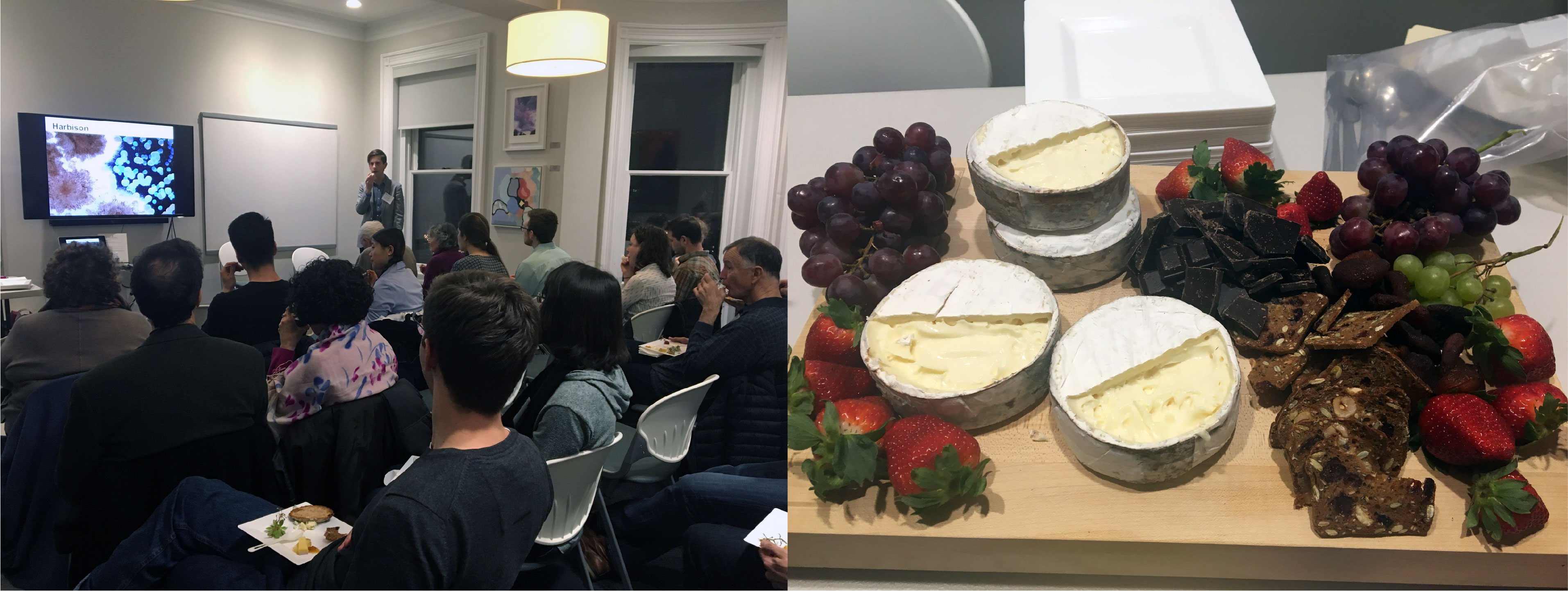
January 2018:
January 23: Our paper on the ecological significance of fungal networks in cheese rinds is out in Nature Communications. This work was led by Kaite Zhang, a former Tufts undergraduate. You can read the paper here. Check our our ‘behind the paper’ post on the Nature Microbiology Community page. Below is a video from this paper. It shows the cheese bacterium Serratia proteamaculans swimming on fungal networks of Mucor lanceolatus.
January 11: Check out this really cool time lapse video that Liz Landis took of growing Saccharomyces cerevisiae cells!
August 2017:
August 22nd: Ben returned to his alma mater Cornell to give a talk in the Food Science Department. Photo below from Sam Alcain (via Twitter @SamAlcaine).
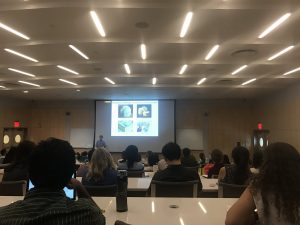
August 1st: We are thrilled to receive a grant from the National Science Foundation to study the evolution of fermented food microbiomes. You can read more about the project here at the NSF website.
June 2017:
June 28th: Ben gave a talk on the microbiology of cheese rinds at the American Dairy Science Association in Pittsburgh.
June 23rd: The early edition of our paper on horizontal gene transfer in cheese rinds (lead by Rachel Dutton’s lab) is out in eLife.
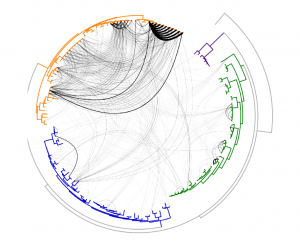
June 19th: Field work for our USDA-funded project on the cabbage phyllosphere has begun! Here Esther is sampling for lactic acid bacteria in a clover cover crop in Westport, Massachusetts.
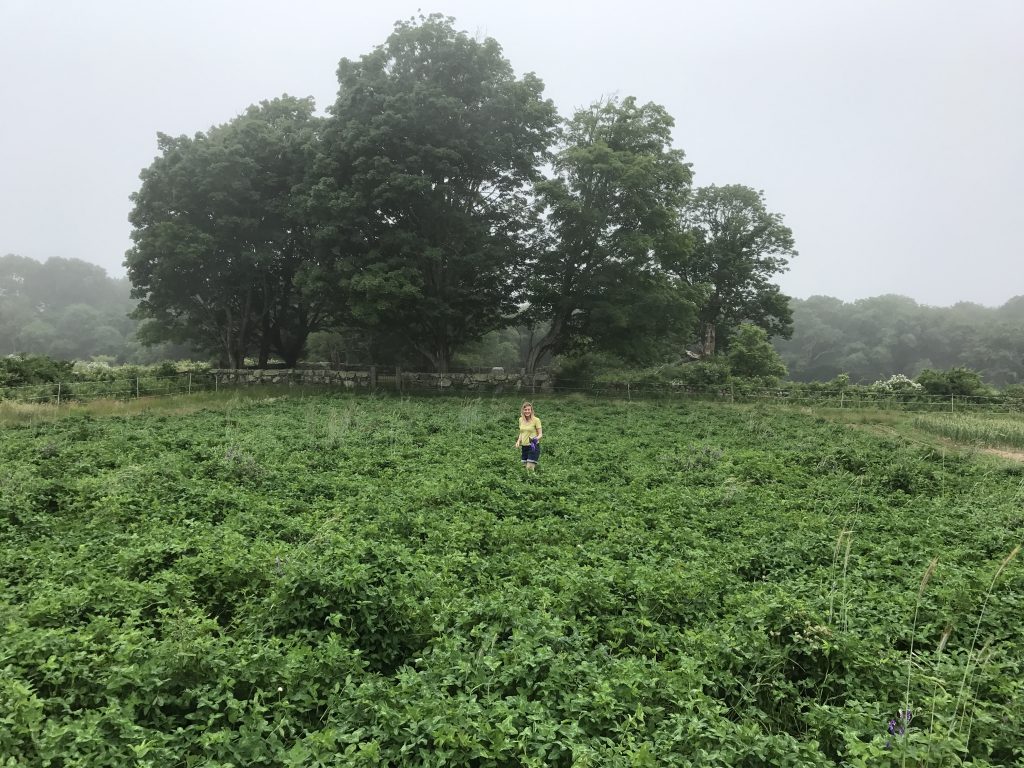
June 2nd: While the primary focus of our lab is on the microbial communities of fermented foods, we collaborating with the Levin lab on planarian worm microbiomes as part of the Allen Discovery Center at Tufts. Here Kate is feeding a batch of worms.
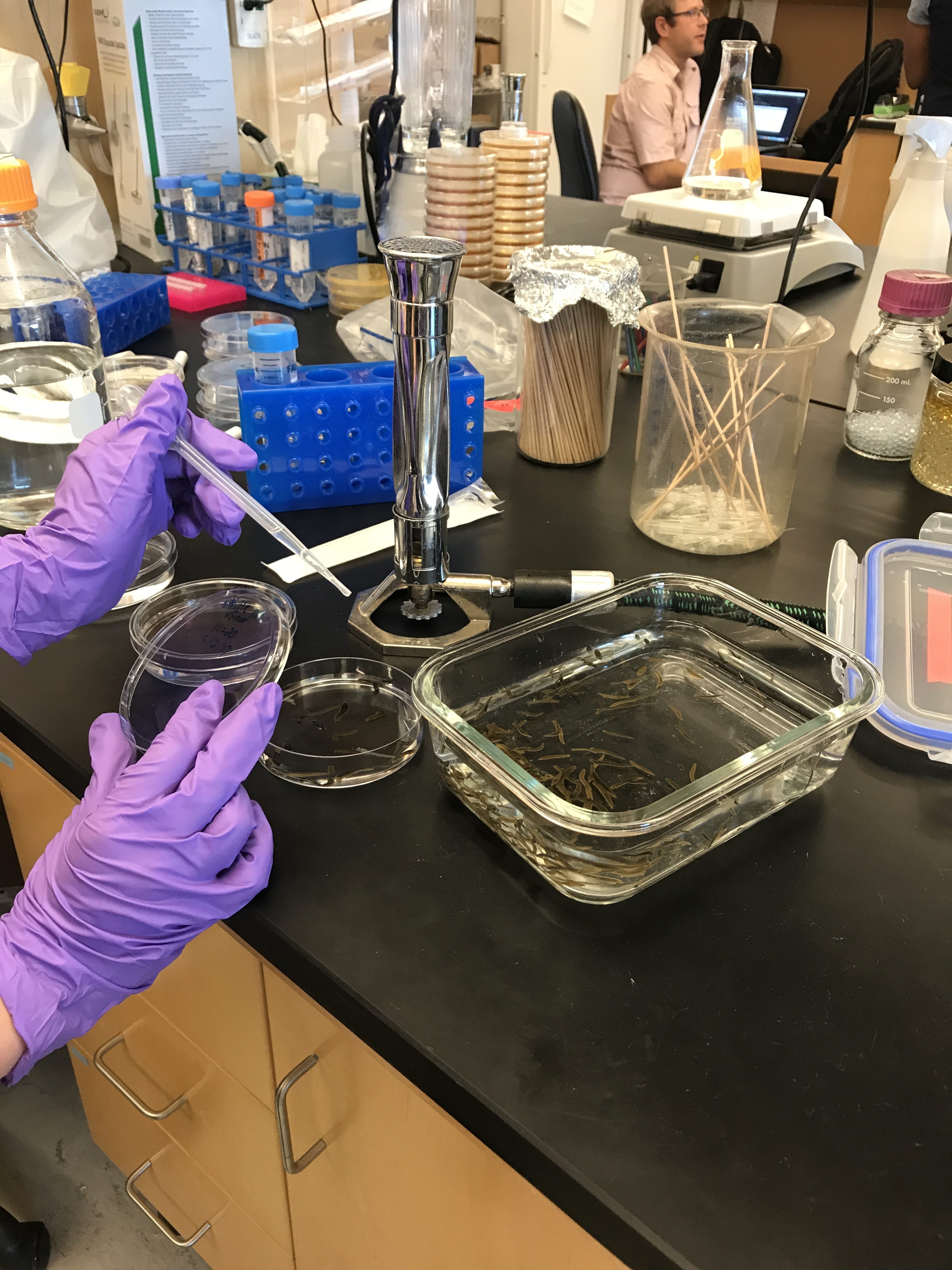
May 2017:
May 23rd: The whole lab kayaked down the Charles River today, from Brighton to Boston. A lovely day to be on the water!
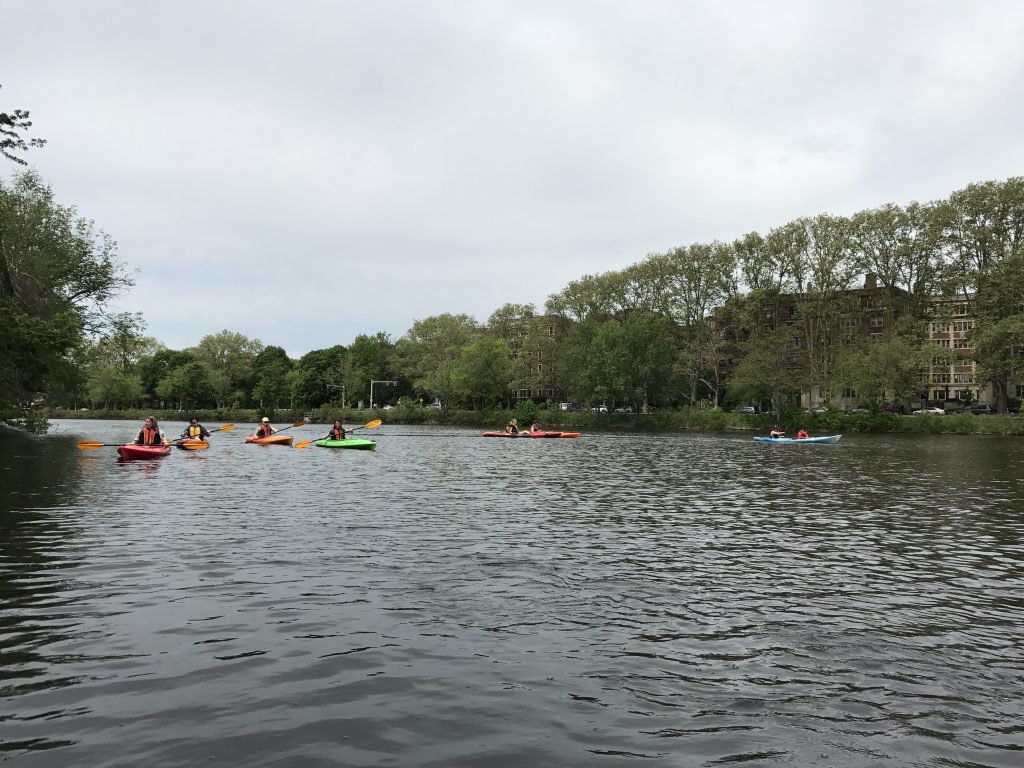
May 21st: Congrats to Jason Shaffer, an undergrad in the lab, for winning the Carmichael Prize for research in biology and for graduating from Tufts!
May 6th: We had a great time teaching visitors of the Museum of Science in Boston about the microbiomes and fermented foods.
April 2017:
April 20th: Liz and Kinsey’s sourdough research was featured in KQED’s Bay Curious podcast. Check it out here!
April 5th: Ben put together a new microbe guide on the microbial diversity of natural rind cheeses for MicrobialFoods.org. Check it out here!
March 2017:
March 15th: Ben’s plans to give a talk in the session he co-organized at Fungal Genetics were foiled by Blizzard Stella. But he was able to catch the rest of the conference and learn about the many exciting developments in fungal biology.
March 10th: Liz and Ben spent the evening with the Rockefeller University Lab out Loud science outreach program. We gave a lecture and and go to hang out with an awesome group of high school kids from throughout New York City. Photo below courtesy of @Rockedu_
March 7th: Our lab’s work using fermented foods as model microbiomes was featured in an “Inner Workings” piece in PNAS. You can read the full text of the article here.
March 6th: Ben gave a lecture at the Tufts Talks event for friends and alumni of Tufts. His talk was entitled “Unlocking Mysteries of the Microbiome Using Familiar Foods.” Ben was joined by former Tufts undergrad Kit McDonnell, who now works at Gingko Bioworks. Video from the New York City version of this talk can be found here.
February 2017:
February 7th: Our ongoing collaborations with the cheese makers at Jasper Hill Farms was highlighted in this piece in the New York Times.
January 2017:
January 30th: Liz has been busy sorting through hundreds of sourdough samples that have been arriving at the lab at part of our collaboration with Rob Dunn and others (more here).
January 16th: Liz and Esther chatted with the folks at Fuhmentaboutit! podcast at the Heritage Radio Network. You can listen to their conversation here.
December 2016:
December 29th: Rachael Bonoan from the Starks lab has been busy working in our lab the past few months. She’s interested in the nutritional ecology of honey bees, and has been sequencing the microbiome of honey bees collected from her hives in Medford and Grafton, Massachusetts. It’s great to have a field biologist learn molecular biology with us! Below you can see Rachael at the final step (after many, many steps!) of prepping an amplicon metagenomic sequencing library.
December 12th: We gathered for our holiday party, and had a blast. 2016 was a productive and exciting year in the lab. Looking forward to what 2017 will bring!
November 2016:
November 7th: Two of our favorite friends in the world of cheese visited campus: Mateo Kehler of Jasper Hill Farm and Sister Noella Marcellino from the Abbey of Regina Laudis. We toured the lab and then our guests talked about cheese and life in Ben’s Food Systems class. Such a treat to spend the day with two ambassadors of cheese.
November 3rd: Our recent paper in mBio was featured in the Research Highlights section of Nature!
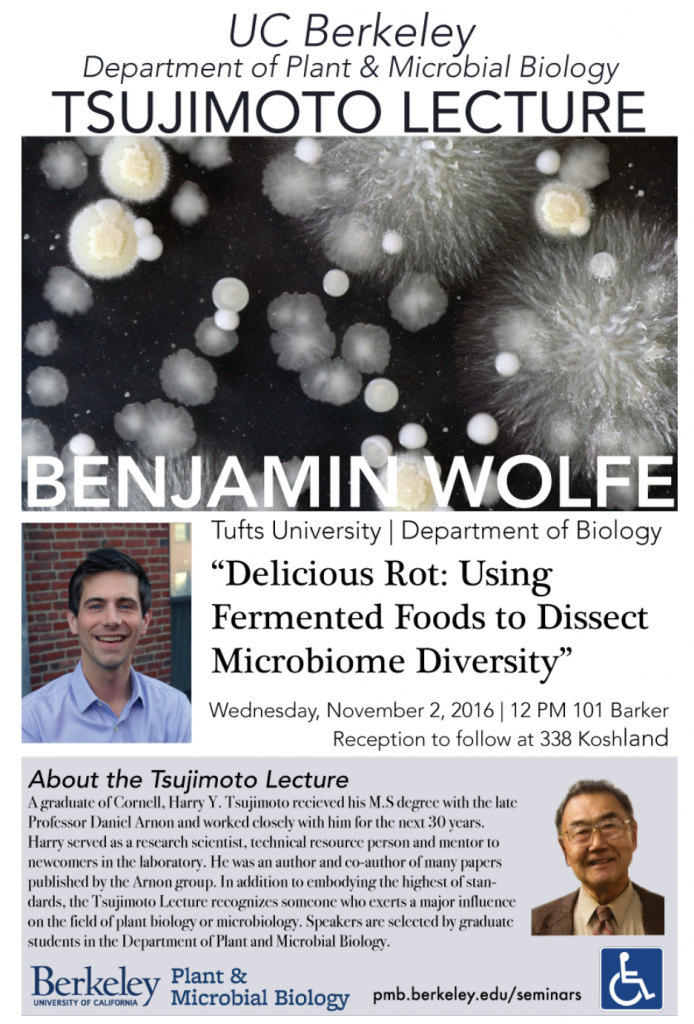
November 2nd: Ben was honored to give the Tsujimoto Endowed Lecture in the Plant and Microbial Biology Department at UC Berkeley. A wonderful and inspiring day!
October 2016:
October 28th: We carved pumpkins at lab meeting today! Happy Halloween!
October 21st: Esther Miller, a graduate student in the lab, helped our friends over at America’s Test Kitchen learn more about the bacteria in their experimental kimchi. Read about their findings over at Cook’s Science.
Photo of lactic acid bacteria isolated from experimental kimchi made at America’s Test Kitchen. Photo from Cook’s Science, and taken by Steve Klise/Anthony Tieuli/Daniel J. van Ackere.
October 20th: Our first lab data paper is out in Mbio! It’s a riveting tale of three Staphylococcus species (shown as colonies in photo below), and demonstrates how fungi can shape the ecological distributions of bacterial species in microbiomes. Enjoy!
October 15th: A sea of baby Napa cabbages! Jonah, an undergraduate researcher in the lab, is studying how bacteria interact with cabbages.
October 1st: We are delighted to welcome Brittany Niccum to the lab as a post-doctoral researcher! Brittany joins us from Indiana University where she studied bacterial genome evolution with Patricia Foster.
September 2016:
September 23rd: Liam, an undergrad researcher in the lab, dissecting a fermented tea biofilm. Liam is studying how yeasts and bacteria interact in these tea biofilms.
September 8th: A big day in the lab for Liz as she sets up 800 (!) mini kombucha biofilms!
September 6th: Esther’s work on cabbage microbiomes was featured in Cook’s Science (Photo below by Kevin White).
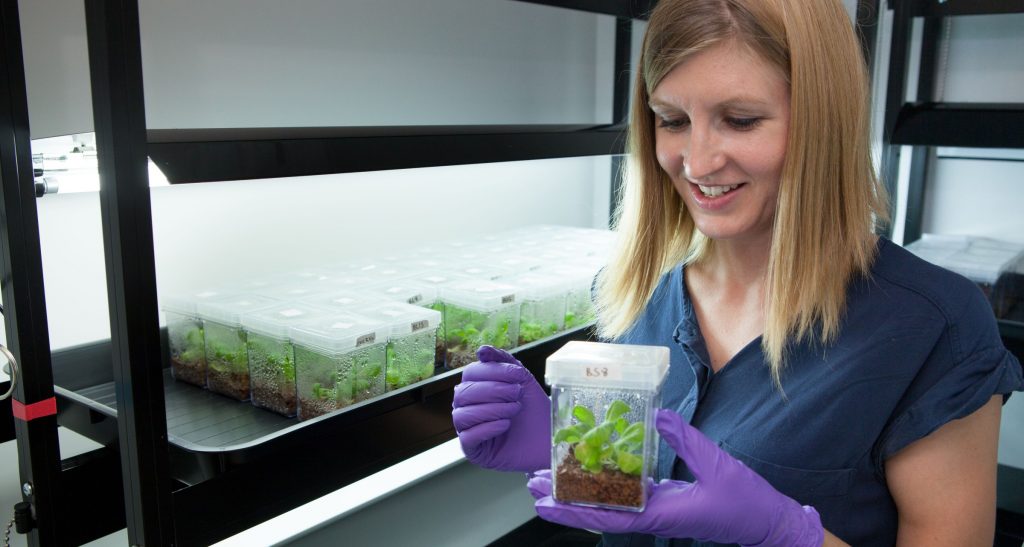
August 2016:
August 28th: Esther and Erik working our fermented food microbiomes table at the Boston Fermentation Festival.
August 9th: We helped our friends at Gastropod podcast demystify the microbiology and history of kombucha (fermented tea).
(photo by Nicola Twilley)
Listen to the podcast here:
https://soundcloud.com/gastropodcast/kombucha-culture
August 9th: Ben presented a talk “Ecology and Evolution of Fungi in Fermented Foods” at the Mycological Society of America conference at UC Berkeley.
July 2016:
July 14th: Liz (3rd from left in photo below) spent a week at EDMAME learning metagenomic analysis techniques for microbial communities. Photo by @ShairahAR
June 2016:
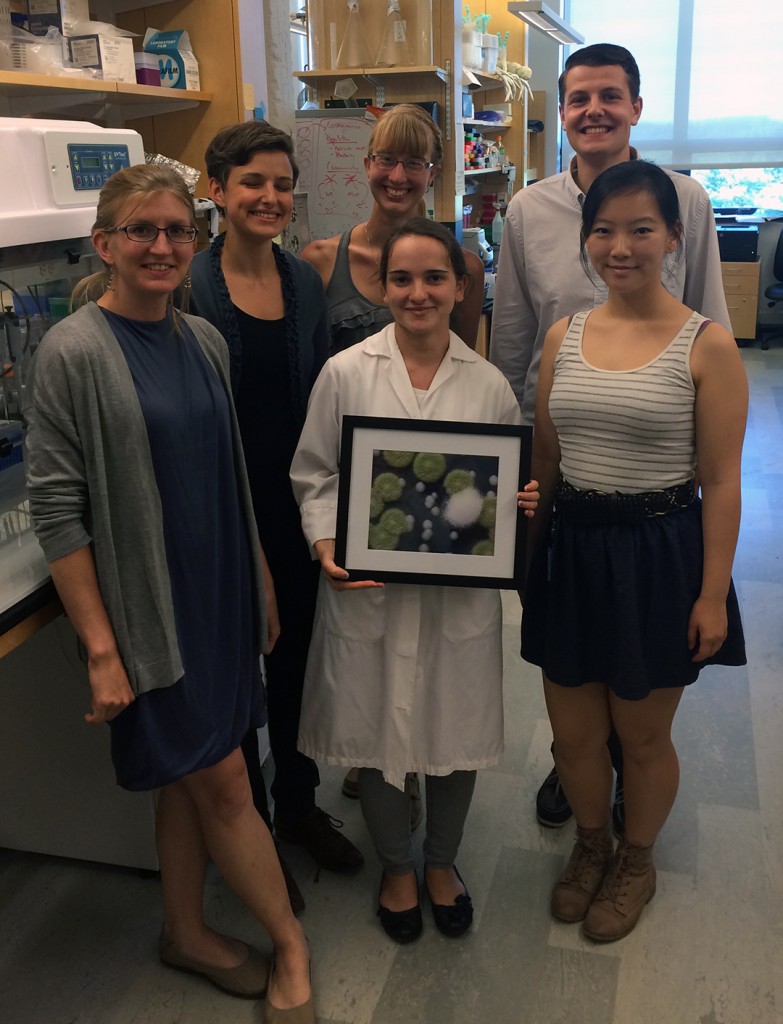
June 30th: Today was the last day for Ina Bodinaku, the first person to join the Wolfe lab in the Fall of 2014. Ina is taking a month off before she starts medical school at the Tufts University School of Medicine. We made sure that she will never forget her time in the lab by giving her a print of Penicillium colonies. Thanks Ina for all of your hard work!
June 27th: Microbial colonies growing on Petri dishes provide beautiful representations of fermented food microbiomes. We’re honored that cheese shops and restaurants around the country have asked to hang photos of microbes from our lab up in their shops. Here are some of our photos hanging up in Caseus Fromagerie & Bistro in New Haven, CT (photo from Sylvia Sobocinski). Our photos can also be found at Cowgirl Creamery in Petaluma, CA and Formaggio Kitchen in Boston, MA.
June 21st: Our primary interest is understanding what generates diversity in micrbiomes, but we are also interested in how microbiomes interact with other organisms. We are beginning to explore how herbivores might indirectly shape the microbiome of plant leaves by altering host plant defenses. Esther has been working on optimizing herbivore treatments in our gnotobiotic cabbage system. Here she is tracking the leaf munching abilities of caterpillars.
June 16th-20th: The lab had a fantastic time at the American Society for Microbiology meeting in Boston. Liz and Esther both presented posters and Ben gave a plenary talk. Here is Esther’s excellent poster on the cabbage phyllosphere microbiome.
June 15th: We’ve been a bit slow with getting a lab group photo. But yesterday we were all in one place and were ready to say ‘cheese’!
May 2016:
May 4th: It was an honor to be part of the Gastropod podcast live show at the Boston Museum of Science. We did live microscopy (!!) of a cheese rind to show the audience the amazing diversity of cheese bacteria and fungi. Photo from Anna Nowogrodzki (@AnnaNowo on Twitter).
April 2016:
April 29th: Ben gave a talk at the University of Toronto in the Department of Ecology and Evolutionary Biology. Liz’s mom was in attendance and made this awesome sketch of the whole talk.
April 25th: Kinsey and Emily have been busy working on developing a synthetic microbial community for our vegetable fermentation system. Here are some of their beautiful bacterial isolates.
April 7th: We had a blast at the MIT Museum Bacterial Bonanza! Liz, Esther, and Ben explained how fermented foods are made and why we are using fermented food microbiomes in our lab as model systems. Thanks to Marcus Parrish for the photos below!
April 5th: Ben’s undergraduate microbiology class stained roots of leek plants that he harvested from his garden to observe arbsucular mycorrhizal fungi. We found some really beautiful examples of arbuscules (projected on screen below). Nice to see these friendly garden fungi on a chilly spring day!
March 2016:
March 25th: Ben helped guests explore the microscopic world of the mold koji (Aspergillus oyrzae) at a pop-up dinner at Fazenda Cafe in Jamaica Plain. Rich Shih made the koji, miso, and other ferments that were part of the dinner.
March 5th: The lab took a “Cheesetreat” to visit our good friends at Jasper Hill Farm in Greensboro, Vermont. Esther fed a day old calf!
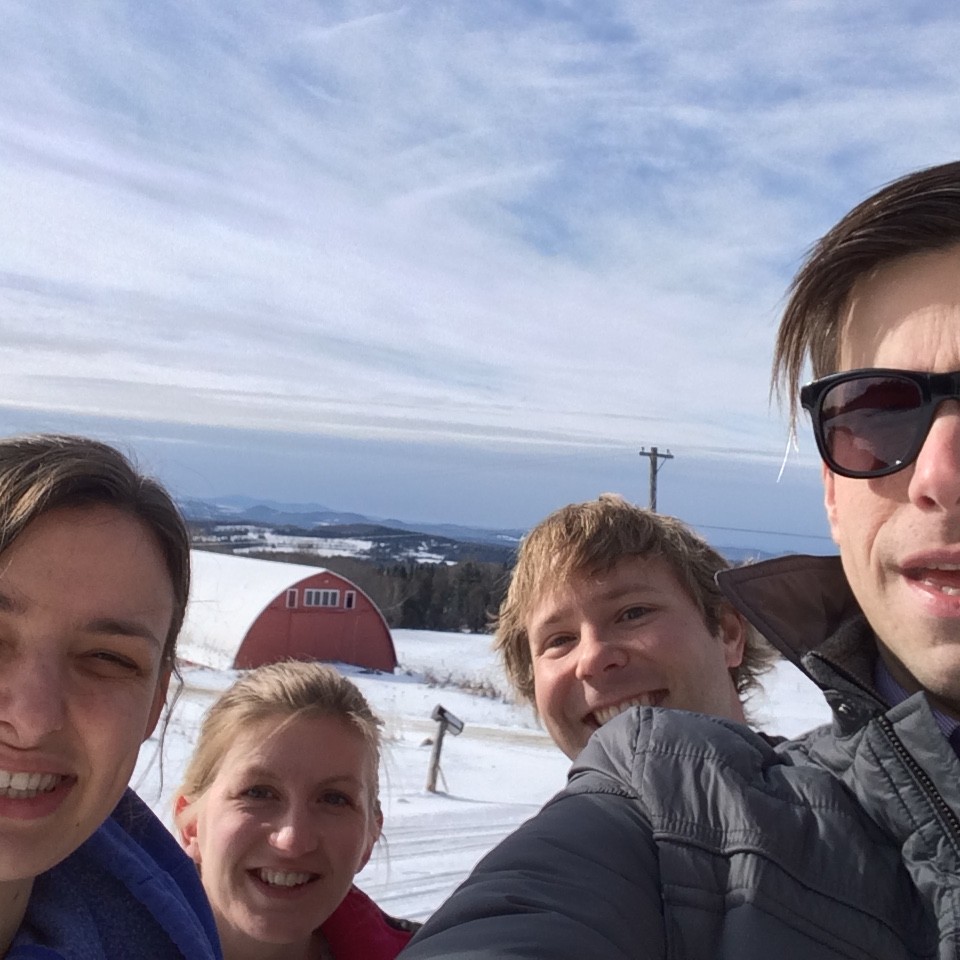
February 2016:
February 19th: We are delighted to be featured in the new Netflix documentary Cooked (Episode 4, Earth). Learn about the microbial communities that make fermented foods ideal model systems for research. Full episodes streaming here (Netflix account required).
February 19th: Liz took some glamour shots of our lab’s pet kombucha, fermented tea made using a biofilm of yeast and bacteria. In the image below, the biofilm has been magnified 1000 times using a microscope. The yeast, in green, are elongating on the surface of the SCOBY. The yeast cells are growing in a matrix of extracellular cellulose, produced by the bacteria.
February 4th: Ben joined Funke Sangodeyi to discuss public perceptions of microbes as part of the new Tufts Science, Technology, and Society Program.
February 2nd: Ben’s Microbiology course (Bio 106) sampled cheeses to eat in class last night. Each student also plated out samples of cheese rinds in the lab to dissect and describe the diversity of a cheese rind microbiome for the semester.
December 2015:
December 15th: Our friends at Gastropod stopped by the lab again to see what we have been up to since their last visit. Check out their “End-of-year Feast” podcast here:
December 11th: Ezra has been maintaining our collection of kombucha communities. Here he is making green tea that will be sterilized before being added to the communities. Right now we have over 20 different communities from across the United States. We are using them to understanding the molecular basis of bacterial-fungal interactions and coevolution within microbial communities.
December 8th: For one final project in Ben’s Microbiology of Food course, students have to create a small menu of their favorite foods and highlight how microbes impact the production, processing, or consumption of these foods. Check out some great examples of these student presentations here.
December 3rd: Our in vitro cabbages! We’re super excited about how well these Napa cabbages enjoy living in a sterile box. These plants are providing us with the ability to experimentally manipulate the phyllosphere of plants used to make fermented foods.
November 2015:
November 24th: We said thank you and goodbye to Noe, our fantastic lab technician.
November 13th: Our lab meetings are powered by kimchi! Esther gave a great talk today about her work linking vegetable phyllosphere microbial ecology with fermented foods. Thanks to the folks at Hosta Hill for making such delicious kimchi!
October 2015:
October 27th: The Microbiology of Food course got their hands dirty this week during an in class sauerkraut extravaganza. We plated out the initial cabbage juice on to see how phyllosphere ecology impacts fermentation dynamics.
October 9th: Ina presented her work on Penicillium at the Tufts Summer Scholars Research symposium.
October 5th: The Wolfe Lab had an outreach doubleheader! Liz, Casey, and Esther had a great time at Tufts Community Day teaching the public about food microbiomes.
At the same time Tufts Community Day was happening, Ben was downtown at the Boston Fermentation Festival also teaching the public about the wonders of microbes in Food. Photo from Real Pickles.
September 2015:
September 26th: We’re excited to be part of Community Day at Tufts next Sunday, October 4th.. Esther, Ezra, and Liz are crafting microbial models using papier-mâché for our Food Microbiomes table. Come stop by and visit the lab!
September 3rd: Esther’s cabbages are slowly settling into their experimental plots. The napa cabbages are really taking off! We’ll be examining the phyllosphere microbial community of these plants once they start to develop cabbage heads.
August 2015:
August 18th: Ben gave a talk on our work with cheese and other fermented foods as part of the NOVA CafeSci series at Le Laboratoire Cambridge. Photo from @LeLabCambridge.
August 3rd: Esther has been busy tending to her ‘cabbage patch.’ She’s growing sterile cabbage plants as part of a project exploring lactic acid bacteria in the phyllosphere.
July 2015:
July 15th: Today we traded in our pipettes for paddles and had a blast on the Charles!
July 14th: Our work with cheese microbial communities was featured in WIRED.
July 9th: During the production of fermented tea (kombucha), a biofilm (often called a SCOBY by kombucha producers) of yeast and bacteria forms on the liquid surface of the tea. Below we’ve used a flatbed scanner to capture the diversity of these biofilms from 20 unique kombucha microbial communities from across the United States. Each circle (about 4 inches across) is one unique biofilm that has been growing in a Petri dish in our lab (see May 17th entry below). Note how they vary in color, thickness, density, and texture. We’re using the microbial diversity of kombucha as a tool to understand how bacteria and yeast interact with one another in food microbial communities.
July 7th: We are making lab sauerkraut! Esther Miller is developing a system to study microbial dynamics of fermented vegetables. We won’t be eating them, but these smell amazing!
June 2015:
June 10th: Ben’s latest piece for Lucky Peach magazine explores how microbes in the phyllosphere of plants impact what we eat.
May 2015:
May 28th: The summer research season has started, and we are fortunate to have so many talented undergrads in the lab this summer! Kaite Zhang received a Carpenter Internship from the Department of Biology, Ina Bodinaku received a Summer Scholars fellowship from the Office of the Dean of Undergraduate Education, and Rachel Odillia is joining us from Colby-Sawyer College as part of the Department of Biology NSF REU program. We’re also excited to have Josh Norville continue his work on bacterial interactions. It’s going to be an exciting summer!
May 17th: We’re receiving kombucha (fermented tea) samples from all over the country as part of our efforts to develop this fermented food as a model system in the lab. A thick pellicle of cellulose develops in this fermented tea as yeast and acetic acid bacteria convert sugars to ethanol and acetic acid. This is what in vitro kombucha looks like in the lab!
May 5th: Ben had a great time visiting the Department of Biology at the University of Missouri-Columbia. Amazing people with fantastic resources. Be sure to check out their Broader Impacts Network – such a great resource for PIs doing science outreach.
APRIL 2015:
April 28th: Kaite presented an awesome poster at the Tufts Undergraduate Research Symposium.
April 13th-20th: A whirlwind week of talks for Ben, from the Tufts Culinary Society to the Harvard Microbial Sciences Initiative Symposium to The University of New Hampshire!
MARCH 2015:
March 27th: A cheese community assembly line in the lab today! Kaite (in front), Tom, and Claire cranking out cheese rind community data!
March 26th: Check out our review paper in the latest issue of Cell with Rachel Dutton. In this paper, we describe the utility of fermented foods as model microbial ecosystems.
March 23rd: A visual guide to fecal transplant microbiology, from Claire Walter
March 22nd: Our “pet” kombucha (fermented tea) in the lab. Look at those gorgeous biofilms!
March 20th: Gastropod put together a delightful podcast on the history and science of cheese. Our research was featured. Check it out here!
March 18th: Ben gave a talk as part of the Biodiversity of Fungi session at Fungal Genetics 2015. So many great talks on the incredibly diversity of fungi, from endophytes on the mountaintops of Hawaii to brown rot fungi in the forests of the UK.
March 4th: Our lab was featured in Tufts Now. Check it out here.
FEBRUARY 2015:
February 16th: Michael has been working on dissecting the microbiome of miso. Here’s what miso looks like at 1000 times magnification under the microscope:
Koji is the fungus Aspergillus oryzae, which is used in the production of miso. It’s tough to make out the bacterial cells, but they were clearly diplococcoid cells. The large golden blobs are plant cells that are being digested during fermentation. Can’t wait to see what grows and what we sequence from these samples!
February 7th: We love to do science, but we also love to bake! Check out Ben’s recipe for miso sourdough bread over at Lucky Peach.
February 1st: So many new faces in the lab. Check out our exponential growth on our people page. Excited to have so many fantastic undergrads joining our group!
JANUARY 2015:
January 16th: We’re excited that Esther Miller, a graduate student in Colin Orians’ lab, is doing a rotation through our lab this semester. Welcome Esther!
January 10th: We’ve begun a large experiment to understand the nature of bacterial-fungal interactions in our cheese rind communities. The bacterial communities in this experiment are beautiful. Check out these gorgeous colonies, hot off our microbial flatbed scanner!
January 3rd: At the end of last semester, Noe (our wonderful lab tech) took some photos of cheese rinds in her Harvard Extension School microscopy class. These scanning electron micrographs show the surfaces of two of our favorite cheeses, Winnimere and Bayley Hazen Blue.
The cheese rind surface gets a bit beat up as the electron beams are shot at the surface to get these images, but you can make out some clear structures. The Winnimere photo shows a stringy web which is probably the fungus Fusarium domesticum that is commonly found on washed rind cheeses. The Bayley photo shows hyphae of the mold Scopulariopsis, a fungus commonly found on natural rind cheeses.
DECEMBER 2014:
December 22nd: Why does rotting food smell? Ben wrote a small piece for Tufts Now exploring microbial answers to this question. Check it out here.
December 2nd: It’s so amazing to have Noe in the lab. She’s a master of media prep!
NOVEMBER 2014:
November 18th: The lab visited Valley View Farm in Topsfield, MA to see the new cheese cave. Liz and Peter Mulholland are growing some beautiful microbes on their natural rind cheeses.
November 14th: Ina harvested a fantastically executed experiment looking at the ecology of blue molds. Take a look at her beautifully blue in vitro cheese communities!
November 14th: Ben was part of a panel at the Yale Food Systems Symposium on the science, production, and sales of artisan cheese.
November 10th: Ben had a lovely time visiting the Food Science and Technology Department at the University of Nebraska – Lincoln. Ben gave a talk on the microbial ecology of cheese rinds. Thanks to Heather Hallen-Adams for hosting a fantastic visit.
November 1st: Ben gave a mini-talk as part of a Cultured Products Showcase at the iGEM Jamboree. Exciting group of panelists including Bryan Greenhagen of Mystic Brewery and Camille Delebecque of Afineur. Thanks to Mac Cowell (@100Ideas) for the Twitter shoutout and photo below.
OCTOBER 2014:
Oct 29: Microbes are everywhere. It’s something we talk about in the lab all the time. Yet sometimes we find ourselves surprised by the stunning diversity of microbial life in some of the most unexpected places. Michał Bogdziewicz, a graduate student working in Elizabeth Crone‘s lab, has been doing some work in our lab to understand how microbes impact oak regeneration. We plated out the microbial community living on acorns from the Harvard Forest and look at the beautiful diversity of fungi that we found!
Oct 25: When our cheese microbes get hungry, we feed them only the finest cheese in the world: cheese from Jasper Hill Farms! Today we received 5 lovely wheels of Bayley Hazen Blue. The wheels are broken down into small pieces of curd which are are then freeze-dried. The freeze-dried curd is used to make our cheese curd agar medium (10% cheese curd, 0.5% xanthan gum, 1.7% agar, 3% salt) that we use for in vitro reconstructions. NOTE: this isn’t biohazardous cheese! We just find that biohazard bags make for easy cleanup!
Oct 14: We are excited to have James Huth working in the lab this semester as a visiting research assistant. James will be exploring how fungi modify bacterial gene expression in our cheese rind communities.
Oct 11: Ben gave a talk entitled “Ecology and evolution of fungi in cheese rind microbial communities” at the Harvard Forest as part of MassMyco. It was a wonderful mini-conference and a great time connecting with local fungal biologists. You can view the slides from his talk here.
Oct 6: A very exciting week as Ina Bodinaku and Katie Zhang, both Tufts juniors, join the lab. Welcome!
Oct 2: Ben had a delightful visit with the wonderful people at South River Miso. They produce traditional miso in Conway, Massachusetts. They are excited to collaborate with the lab to learn more about the microbial ecology of their delicious misos! Below you can see the South River Miso koji room, where the mold Aspergillus oryzae is colonizing rice grains. The koji is added to cooked beans to help fuel the fermentation process.
Oct 1: Michał Bogdziewicz, a graduate student working in Elizabeth Crone‘s lab, is doing some work in our lab this week. He’s interesting in determining what fungi colonize acorns at the Harvard Forest and how they impact oak regeneration. We’re hoping to convert Michał into a microbial ecologist! Here’s Michał working in our tissue culture room, where he is dissecting some acorns:
Oct 1: After a month of ordering lots of equipment and unpacking many boxes, the lab is up and running! Below are photos of the our lab bays in the open lab space, our shared tissue culture room, and one of our shared imaging rooms.
SEPTEMBER 2014
Benjamin was part of a transdisciplinary panel at Duke University with Dr. Heather Paxon (Anthropology, MIT) and Portia McKnight (Co-Owner, Chapel Hill Creamery). The event explored the intersection of microbiology, anthropology, and food production. You can watch a video of the event here: Subnatural Cultures in and Around the Creamery | Duke University

